- Skip to primary navigation
- Skip to main content
- Skip to primary sidebar
- Skip to footer

The Mindful Traveller
Eco Travel Blog & Photography

15 Most Beautiful Places to Visit in Tunisia
25 April 2024 · In: Travel , Tunisia

Are you looking for the best places to visit in Tunisia ? You have come to the right place! This article walks you through the 15 most beautiful locations to add to your bucket list for an unforgettable vacation, whether you are travelling as a couple, family with children or with friends.
Welcome to Tunisia, a North African gem nestled between the Mediterranean Sea and the Sahara Desert. From ancient ruins steeped in history to stunning beaches framed by azure waters, you will find plenty of things to do and places to see for a vacation full of surprises.
Whether you are a history buff, an outdoor enthusiast or a culture seeker, Tunisia has something for everyone, thanks to its wide range of cultural experiences and water adventures .
I visited Tunisia a few years ago with my mum, and this road trip changed my life and the way I see the world ! It is also the place where my passion for travel writing and photography was born.
So, are you ready to discover the top 15 places in Tunisia that you must visit ? Let’s get started! And, of course, let me know in the comments below if you have any other suggestions ☀️
Disclosure : Some of the links below are affiliate links, meaning that at no additional cost to you, we will receive a commission if you click through and make a purchase. For more information, please read our full affiliate disclosure .
15- Bizerte
Overview: 15 must-visit places in tunisia.
1- Carthage 2- Tunis Medina 3- Sidi Bou Said 4- Dougga 5- El Djem Amphitheatre 6- Matmata 7- Kairouan 8- Chott el Jerid
9- Djerba 10- Tozeur & the Oasis of Nefta 11- Bulla Regia 12- Ichkeul National Park 13- Hammamet 14- Sousse 15- Bizerte

Scenic places in Tunisia – Map
Click on the top left of the map to display the list of stops and locations.
15 most beautiful places to visit in Tunisia

Remember that this list is only a recommendation! You will find many other beautiful places and towns to visit in Tunisia.
1- Carthage
Carthage, located near Tunis, is an ancient city steeped in history and mythology . Founded by the Phoenicians in the 9th century BC, it became one of the greatest and wealthiest cities of the ancient world, rivalled only by Rome.
Today, you can explore its vast archaeological ruins , including the Baths of Antoninus, the Punic Ports and the iconic Byrsa Hill, which offers panoramic views of the surrounding area and houses the Carthage National Museum.
The historical significance of Carthage, combined with its stunning ruins and coastal location, makes it one of the best places to visit in Tunisia for those interested in ancient civilisations and archaeology .
Things to do & see in Carthage
- Tour the Carthage National Museum
- Wander through the Ancient Ruins
- Marvel at the Antonine Baths
- Admire the Roman Villas
- Discover the Punic Ports
- Climb Byrsa Hill for panoramic views
- Explore the Salammbo Tophet
- Stroll through the Carthaginian Quarter
- Visit the Roman Theater
- Enjoy the various vantage points of the sea
Unforgettable experiences I recommend
2- tunis medina.
The Tunis Medina is a UNESCO World Heritage Site and one of the best-preserved medieval cities in the world. Enclosed within ancient walls, its narrow streets are lined with historic buildings, traditional souks (markets), mosques and palaces, reflecting centuries of Arab, Ottoman and French influences.
Immerse yourself in the vibrant atmosphere , sample local cuisine , shop for handicrafts and admire the detailed architecture . There are plenty of things to do and see for all ages.
The Tunis Medina is a cultural treasure not to be missed, offering a perfect glimpse into the rich history of Tunisia, making it one of the best places to experience the authentic charm and heritage of the country.
Things to do & see in Tunis Medina
- See the Zitouna Mosque
- Wander through the souks
- Explore the Dar Ben Abdallah Museum
- Admire the Al-Zaytuna University
- Climb the Clock Tower for panoramic views
- Visit the Mausoleum of Tourbet el-Bey
- Discover the fortified citadel of the Kasbah
- Indulge in traditional Tunisian dishes
- Marvel at the intricate architecture
- Experience local culture and interact with locals
3- Sidi Bou Said
Sidi Bou Said is a charming coastal village located a short distance from Tunis. Renowned for its striking white and blue architecture, you will uncover a picturesque and romantic ambience during your visit.
Stroll through its narrow cobbled streets, decorated with bougainvillea flowers, and admire the traditional Tunisian houses with blue doors and shutters . The village also offers stunning views of the Mediterranean Sea, making it an ideal spot for relaxation and reflection .
With its unique aesthetic and scenic panoramas , Sidi Bou Said is the perfect place to discover the essence of Tunisian coastal beauty and is a must-visit destination if you are seeking serenity and charm.
Things to do & see in Sidi Bou Said
- Wander through the picturesque streets
- Relax at the Café des Nattes
- Admire the views from Café Sidi Chabaane
- Discover the Ennejma Ezzahra Palace
- Explore the Museum Dar el-Annabi
- Photograph the iconic Lighthouse
- Browse through the artisanal shops
- Visit the Museum of Popular Arts and Traditions
- Unwind on Sidi Bou Said Beach
- Experience a magical sunset
Dougga, located in northern Tunisia, is a UNESCO World Heritage Site and one of the most impressive ancient Roman cities in North Africa. Dating from the 2nd century BC, it features well-preserved ruins that offer a glimpse into the past.
Take the time to explore its ancient theatre, temples, baths and residential quarters , all set against a backdrop of rolling hills and olive groves. Highlights you should not miss include the Capitol and the well-preserved Roman villas.
The remarkable state of preservation of the site, mixed with its scenic surroundings and rich history , makes Dougga an unmissable location for history buffs and travellers wishing to learn more about the ancient past of Tunisia .
Things to do & see in Dougga
- Marvel at the ruins of the Capitol
- Admire the ancient Roman theatre
- Discover the ruins of the Roman Forum
- Explore the Temples and other religious structures
- See the remains of the Licinian Baths
- Visit the House of the Trifolium
- Walk along the Decumanus Maximus
- Stop by the Dougga Museum
- Take in the views of the Tunisia countryside
5- El Djem Amphitheatre
The El Djem Amphitheatre, also known as the Colosseum of Thysdrus, is a splendid Roman amphitheatre located in the town of El Djem in central Tunisia. Built in the 3rd century AD, it is one of the largest and best-preserved Roman amphitheatres in the world, second only to the Colosseum in Rome.
The amphitheatre could accommodate up to 35,000 spectators and was used for gladiatorial contests and other public spectacles. Today, you can marvel at its impressive structure , including its imposing walls and well-preserved underground chambers.
The historical significance, architectural grandeur and dramatic setting of El Djem Amphitheatre in the middle of the Tunisian countryside make it a popular tourist attraction, especially great if you are interested in ancient history and Roman architecture .
Matmata is a unique Berber village located in southern Tunisia, known for its distinctive underground homes carved into the limestone cliffs. These troglodyte houses feature interconnected rooms arranged around a central courtyard, providing natural insulation from the desert heat .
For all the movie fans out there, Matmata gained international fame as a filming location for scenes in the Star Wars series , adding to its charm! You can also explore the fascinating cave homes, interact with the local Berber community and experience a way of life that has persisted for centuries.
The captivating landscape and cultural significance of Matmata make it one of the best places to visit in Tunisia for a one-of-a-kind and immersive travel experience – one of the highlights of my South Tunisia road trip !
Things to do & see in Matmata
- Visit traditional underground homes
- Stay overnight in a troglodyte hotel
- Discover the Star Wars filming locations
- Take a guided tour of nearby Berber villages
- Browse through local shops and markets
- Take in the breathtaking views of the desert
- Enjoy authentic Berber cuisine
- Embark on a camel ride desert excursion
- Explore Ksar Ouled Soltane
- Interact with locals and learn about their culture
7- Kairouan
Kairouan, located in northeastern Tunisia, is one of the holiest cities of Islam and a UNESCO World Heritage Site . Founded in the 7th century, it has been an important centre of Islamic scholarship and culture.
The city is renowned for its Great Mosque of Kairouan , one of the oldest and most significant mosques in the Islamic world, featuring stunning architecture. Do not forget to also visit the Medina , with its narrow streets, historic buildings and bustling markets.
The spiritual significance, architectural richness and cultural heritage of Kairouan make it a top destination to visit if you want to learn more about the Islamic history and heritage of Tunisia .
Things to do & see in Kairouan
- Explore the Great Mosque of Kairouan
- Marvel at the Aghlabid Basins
- Wander through the Medina
- Visit the Mausoleum of Sidi Sahab:
- Discover the Museum of Islamic Art
- Climb the Tower of the Barber’s Mosque
- Experience the bustling Friday market
- Stop by the ancient well Bir Barouta
- Indulge in traditional Tunisian dishes
- Attend a Sufi ceremony at a local Zawiya
8- Chott el Jerid
Chott el Jerid is a vast salt pan located in southern Tunisia, on the edge of the Sahara Desert. Covering an area of approximately 5,000 square kilometres, it is one of the largest salt flats in the Sahara .
The landscape of Chott el Jerid is surreal and mesmerising , characterised by the contrast between the shining white salt crust and the surrounding desert terrain. You can also experience the unique phenomenon of mirages caused by the heat and reflective surface of the salt pans, especially at sunrise and sunset .
Chott el Jerid is a must-visit Tunisia location for photo lovers looking for a phenomenal experience , particularly unmissable if you want to witness the natural wonders of the Tunisian desert landscape.
When is the best time to visit Chott el Jerid?
The best time to visit Chott el Jerid is during the cooler months, usually from late autumn to early spring (October to April). During this period, temperatures are milder with better conditions for photography, making outdoor exploration more enjoyable.
Djerba is a picturesque island located off the southeastern coast of Tunisia, in the Gulf of Gabès. Known for its stunning beaches, crystal-clear waters and vibrant culture, it offers a perfect blend of relaxation and exploration .
You can enjoy the sun and water sports along the sandy shores of the island, explore charming Berber villages with whitewashed houses and narrow streets, and visit historical sites such as the Ghriba Synagogue, one of the oldest synagogues in the world.
With its laid-back atmosphere, rich history and natural beauty, Djerba is an excellent place to visit and stay in Tunisia for travellers seeking a memorable beach getaway infused with cultural experiences .
Things to do & see in Djerba
- Discover the El Ghriba Synagogue
- Relax on the many Beaches
- Wander through the markets of Houmt Souk
- Visit the Guellala Museum
- Explore the Fortress of Borj El Kebir
- Experience the Djerba Heritage Village
- Uncover the Meninx Archaeological Site
- Stop by the Djerba Explore Park
- Go on a fun camel ride
- Enjoy watersports such as sailing
10- Tozeur & the Oasis of Nefta
Located in southwestern Tunisia, Tozeur is a charming desert town famous for its distinctive brickwork and palm-lined streets, whilst the Oasis of Nefta offers a tranquil retreat in the middle of verdant palm forests .
You will have the opportunity to discover the ancient irrigation systems called ksour and ghorfas , stroll through the winding alleys of the Medina of Tozeur and embark on camel rides or horse-drawn carriage tours through the oasis.
If you are looking for an authentic desert experience , you have come to the right place! Tozeur and the Nefta Oasis are among the best places to visit in Tunisia for those seeking an immersive adventure .
Things to do & see in Tozeur
- Relax at one of the tranquil oases
- Explore the Dar Chrait Museum
- Go on an excursion into the Sahara Desert
- Visit the Eden Palm Museum
- Stop by the Chak Wak Cultural Village
- Uncover the Mos Espa Set
- Enjoy a sunset camel ride
- Experience the Tozeur dates market
- Take a scenic drive to Chott el Djerid
11- Bulla Regia
Bulla Regia is an ancient Roman archaeological site located in northwestern Tunisia, renowned for its well-preserved underground houses .
These belowground homes feature intricate mosaics, frescoes and architectural details , offering a fascinating insight into ancient Roman domestic life. Take the time to see the underground chambers , walk among the ruins of the Roman city and marvel at the creativity of its inhabitants.
The unique architectural elements and historical significance of Bulla Regia make it one of the best places to visit in Tunisia for those interested in ancient history and archaeological sites .
12- Ichkeul National Park
Ichkeul National Park is a UNESCO Biosphere Reserve located in northern Tunisia, near the town of Bizerte. It is renowned for its diverse wetland habitats , including marshes, lakes and lagoons, which provide crucial wintering grounds for migratory birds such as ducks, geese and flamingos.
During your visit to Ichkeul National Park, you can enjoy birdwatching, hiking and boat tours , whilst admiring the scenic landscapes and rich biodiversity of the park.
The ecological importance, stunning natural beauty and opportunities for plenty of outdoor activities make the park one of the best places to visit in Tunisia for nature enthusiasts and wildlife lovers .
Things to do & see in Ichkeul National Park
- Go birdwatching with a guide
- Take a guided boat tour of the waterways
- Explore the hiking trails
- Pack a picnic and enjoy a meal amidst nat
- Try yourself at nature photography
- Stop by the visitor centres and interpretive exhibits
- Keep an eye out for native wildlife such as wild boars
- Enjoy fishing in the lakes and waterways
- Join guided nature walks led by park rangers
- Visit nearby cultural attractions such as Bizerte
13- Hammamet
Hammamet is a charming resort town located on the northeastern coast of Tunisia, overlooking the azure waters of the Mediterranean Sea. Known for its beautiful sandy beaches , historic medina and vibrant arts scene, it offers a perfect blend of relaxation and culture .
Wander the narrow alleys of the Medina , shop for artisanal products, visit historic landmarks such as the medieval fortress and enjoy water sports activities like swimming, snorkelling and sailing.
With its picturesque setting, rich cultural heritage and a wide range of experiences , Hammamet is one of the most beautiful places to visit in Tunisia, ideal for couples seeking a rejuvenating seaside getaway .
Things to do & see in Hammamet
- Soak up the sun on Hammamet Beach
- Explore the ruins of the Kasbah
- Indulge in fresh seafood and Tunisian cuisine
- Visit the International Cultural Center
- Discover the historic Medina fortifications
- Relax in Gardens, such as the Omar Khayam Park
- Tee off at one of the world-class golf courses
- Enjoy family-friendly fun at Carthage Land
- Attend festivals, like the Hammamet International Festival
Sousse is a historic coastal city located in central Tunisia, renowned for its UNESCO-listed Medina and its long sandy beaches . Steeped in history, the city features impressive monuments such as the Great Mosque, the Ribat Fortress and the Museum of Sousse, which houses a rich collection of archaeological artefacts.
During your short or long stay in Sousse, you can wander through the narrow streets of the Medina, shop for souvenirs, relax on the beach and immerse yourself in the vibrant cultural scene of the city .
With its fascinating history, architectural wonders and seaside charm , Sousse is the perfect place to stop by on your Tunisia holiday for its mix of culture and relaxation .
Things to do & see in Sousse
- Wander through the UNESCO-listed Medina
- Discover the Great Mosque and Ribat of Sousse
- Soak up the sun on the sandy beaches
- Explore the Archaeological Museum
- Visit the Kasbah of Sousse
- Try your hand at windsurfing, sailing or scuba diving
- Shop at the nearby Port El Kantaoui
- Take a day trip to the city of Monastir
- Enjoy the vibrant nightlife of Sousse
- Experience one of its annual cultural festivals
Bizerte is a picturesque coastal city located in northern Tunisia, known for its charming Medina, historic kasbah and traditional fishing port. The city also features architectural gems such as the Spanish Fort, which offers panoramic views of the city and the Mediterranean Sea.
Discover the narrow streets of the Medina, admire the historic landmarks of the city and experience a laid-back Mediterranean ambience. It is the perfect place to escape the more crowded tourist locations .
So, if you are seeking an authentic seaside getaway , look no further! Bizerte is a must-visit destination on your Tunisia vacation, thanks to its rich cultural heritage, scenic waterfront and relaxed atmosphere .
Things to do & see in Bizerte
- Visit the Kasbah of Bizerte
- Spend a day relaxing on the sandy beaches
- Explore Cap Blanc, a scenic peninsula
- Discover the Archaeological Museum
- Go on a boat trip to explore the coastline
- See the Great Mosque of Bizerte
- Take a hike in the Forest of Chiffa
- Attend one of its annual festivals or events
Shop the printable road trip planner
Create your dream road trip in Tunisia 🇹🇳

How to reduce your eco-impact in Tunisia
Sustainable travel means exploring the world whilst being aware of your surroundings and having a positive social, environmental and economic impact on the places you visit.
Being a responsible traveller in Tunisia is possible! Here are some eco-friendly travel tips for reducing your carbon footprint:
- If you need to take the plane, book direct flights (which require less fuel than indirect flights) and offset your carbon footprint . But, do not use carbon offsetting as a complete solution. Combine it with other sustainable practices, like avoiding single-use plastic on the plane and mindfully packing your suitcase for your sunny holiday.
- Select an eco-friendly accommodation . Choose hotels, guesthouses or lodges that prioritise sustainability initiatives, such as energy and water conservation, and waste reduction. Try to look on their website for green credentials and ask questions. You can also use Bookdifferent or Ecobnb to help you decide.
- Conserve water . Practice water conservation by taking shorter showers, reusing towels and reporting any leaks or drips in your accommodation. In addition, avoid wasting water when brushing your teeth or washing dishes.
- Reduce energy consumption . Turn off lights, air conditioning and appliances when not in use to save energy. You can also consider using natural ventilation and daylight instead of air conditioning and artificial lighting whenever possible.
- Minimise the use of plastic . Bring a filtered water bottle, reusable shopping bag and utensils to reduce single-use plastic waste. Refill your water bottle from filtered water stations or large refillable containers instead of buying plastic bottled water.
- Choose a local guide or sustainable tour operator . Support tour operators, guides and excursions that prioritise environmental conservation, cultural preservation and responsible tourism practices. Look for certifications or memberships on their website.
- Respect wildlife . Avoid activities that exploit or harm wildlife, such as participating in captive animal encounters. Instead, support responsible wildlife viewing experiences that prioritise animal welfare and conservation.
- Always respect the local heritage . Treat people and their surroundings with respect. Sustainable travel is not only about the environment but also about the local communities. So, always be respectful, smile and learn about the Tunisian traditions.
More inspiration for your green vacation:
- Best Travel Apps for Exploring Sustainably
- 15 Travel Books to Inspire Your Next Eco-Adventure
- Best Ecotourism Activities Around the World
Eco-friendly gear you might love:
- 10 Best Sustainable Backpacks for Travel & Hiking
- 10 Best Reusable & Eco-Friendly Travel Mugs
- 8 Best Filtered Water Bottles for Travel & Hiking
Check out this page for more inspiration on eco-friendly products & gear.

Tunisia travel planning guide
🚑 Should I buy travel insurance to travel to Tunisia? Yes, buying insurance is always valuable when travelling abroad. Enjoy your vacation in Tunisia stress-free with one of my favourite providers, Nomad Insurance .
💧 Can you drink the water in Tunisia? No, drinking tap water in Tunisia is not recommended. That is why I suggest travelling with the UltraPress Purifier Bottle , a lightweight filtered water bottle perfect for reducing plastic and staying hydrated on the road.
🚗 Is it easy to rent a car in Tunisia? Yes, renting a car in Tunisia is easy and a great way to explore the country freely. I recommend booking yours with Rentalcars.com – they offer a variety of operators for all budgets.
🏨 How to book accommodation in Tunisia? The best way to book your accommodation in Tunisia is with Booking.com – my favourite platform to compare and reserve places to stay each night, from affordable hotels to luxury resorts.
✈️ What is the best site to buy a flight to Tunisia? I recommend booking your plane with Skyscanner . It has been my favourite platform for years, as it allows me to book the cheapest flights whilst lowering my carbon emissions.

Best places to visit in Tunisia – FAQ
The spring months of April and May, as well as the autumn months of September and October, are the best times to visit Tunisia, as the weather is generally mild and pleasant, with fewer crowds and comfortable temperatures, ideal for outdoor activities and beach relaxation.
Yes, Tunisia is an affordable destination, offering good value for money compared to many other Mediterranean destinations. You will easily find low-cost options for accommodation, transportation and sightseeing, making it an accessible country for travellers on a budget.
Djerba has some of the best beaches in Tunisia. With its pristine sandy shores, turquoise waters and laid-back atmosphere, it offers an ideal setting for beachgoers seeking relaxation and water activities. Other places worth mentioning are Hammamet, Sousse, Monastir and Mahdia.
Tunisia is generally considered safe for tourists, with the government and local authorities taking measures to ensure the safety and security of visitors. However, like any destination, it is essential to exercise caution and remain vigilant, especially in crowded areas and tourist sites.

And you, what is your favourite place to visit in Tunisia? Let me know in the comments below!
With love ♡ Lucie
- Share on Twitter Share on Twitter
- Share on Facebook Share on Facebook
- Share on Pinterest Share on Pinterest
You will also love

STAY INSPIRED
Join our community today to receive exclusive travel tips & behind-the-scene stories that will inspire your next adventures, directly to your inbox. Can't wait to see you inside ♡
Reader Interactions
Leave a reply cancel reply.
Your email address will not be published. Required fields are marked *
Save my name, email, and website in this browser for the next time I comment.

Sustainable Camping Guide: 12 Easy Eco-Tips
Follow the journey.

On the Blog
- Privacy Policy
Become an insider!
And receive exclusive travel tips & behind-the-scene stories ♡
Copyright Lucie Charpentier © 2024 · Theme by 17th Avenue

Home » Travel Guides » Tunisia » 15 Best Places to Visit in Tunisia
15 Best Places to Visit in Tunisia
Trodden by the Berbers of old and raided by Barbary pirates, settled by the Phoenician Greeks, and then home to the mighty city of Carthage, Tunisia has a grand place in the annals of both the North African and European story. (After all, it was host to the only major rival to Rome across the entire Mediterranean basin for those formative centuries between the 800s BC and year zero.)
Add to that the mythical figures of Aeneas and Dido, along with tales of Arabic sultans and even Norman seafarers from the north, and it’s easy to see why this cut-out on the Maghreb is such a fascinating, culturally-rich place. Unfortunately, the great power struggles played out here have continued on into the modern age, giving rise to revolutions and counter-revolutions. Today, the government vies for control with hardline Islamists, there have been attacks on tourists, and FCO advice flits between cautious and uber-cautious. But when the dust settles and Tunisia stabilizes, it’s sure to take the breath away!
Lets explore the best places to visit in Tunisia :

It doesn’t get much better than this for fans of the ancients.
Colossal arches and elliptical amphitheaters to rival even the Colosseum in Rome are what mark the horizon of famous El Djem.
Tagged by UNESCO, the city is a modern one built right atop an old one, with the occasional ruin of Roman homes and arcades popping up on the corners.
Many sights have been preserved thanks to the billowing dust storms of the surrounding Sahara, but a lack of large-scale archaeology means that the main attraction remains the huge Amphitheatre of Thysdrus.
Delve in and stroll the changing rooms of gladiators, or stand where ancient governors once did atop the fighting pits.
2. Houmt Souk

The undisputed jewel of Djerba island comes topped with the adobe domes of the Bordj el Kabir fort, which was raised in the 1400s and 1500s to protect the harbor on the Gulf of Gabes below.
Over the centuries, everyone from the Numidians to the Arabs to the Spaniards to the Ottomans have made their home in this tactical position on the edge of the Med.
Accordingly, history oozes from every dust-caked pore.
There are the traditional fondouks quarters of medieval merchants left in the Old Town.
There colorful pottery bazaars, whitewashed synagogues, Turkic mosques, and lively marketplaces selling olive oils and chickpea broths.

Still reeling from the horrific terror attacks of 2015, the seaside city of Sousse is now much less loud about its beauties.
But the beauties are there nonetheless.
They lurk between the tight-knit alleyways of the town’s historic medina; they ooze from the simple and elegant rises of the Aghlabite Great Mosque; they beckon from the formidable bulwarks of the old Ribat citadel above the place.
And away from the steaming Ottoman hammams and colorful Maghreb souks of the town proper, there are gorgeous beaches that sparkle turquoise blue, all fringed with luxurious hotels and palm-lined promenades.
4. Sidi Bou Said

You could be forgiven for thinking that you’d made the hop across the Med to the islands of the Greek Aegean as you enter the vibrant interior of Sidi Bou Said town, sat just 20 kilometers from bustling Tunis.
Yep, the sky-blue and whitewashed color scheme here is more than reminiscent of towns in Santorini and Mykonos.
However, this one’s interesting hues were actually started by the French musicologist Rodolphe d’Erlanger.
He first plastered the stucco walls of his home with the endearing tones in the 20s, and his palatial mansion at the Ennejma Ezzahra is a now a museum to his legacy.

Every trip to Tunisia should include a jaunt to the great desert of the Sahara, whose shifting sands and dry escarpments begin here in earnest.
And where better for a taste of the dry life than the adobe mud town of Tozeur? This oases settlement in the extreme south-west of the nation is a veritable masterpiece of Berber tradition.
For starters, it’s surrounded by swathes of verdant date palm blooms that rise straight from the ochre-hued earth.
And then there’s its medina city, with filigrees and carvings and brick artistry straight from the old arabesque world.

Pass under the great arches of the Bab el Bhar (the Port de France) and you’ll see both sides to this fascinating capital: the French side and the Maghreb side.
In the former, the so-called Ville Nouvelle, the traces of rule from Paris are all too evident.
There are wide, tree-peppered avenues.
There are coffee shops spilling onto the sidewalks.
There are grand cathedrals with Gothic elements.
And on the latter side of town; the African side, things take a turn for the arabesque.
Lively souks packed with kaleidoscopic fabrics crawl and sprawl over one another.
The shouts of hawkers touting spice echo, and the scents of tagines and mint teas mix with camel skin lamps and shisha pipes.
7. Kairouan

Nearly 1,500 years of history meets between the dust-caked desert hills around Kairouan.
A city famed for its long connection to the Islamic world, it’s been a center of Sunni teachings since at least the 7th century.
Cue the mighty rises of the Great Mosque of Kairouan: a UNESCO World Heritage Site that draws thousands of pilgrims to its prayer rooms and enclosures each year.
Once you’ve wondered at that amazing Aghlabid relic, be sure to wander the old medina and its whitewashed cottages, taste sweet Tunisian pastries in the bakeries there, and seek out the interesting Mosque of the Three Gates.
8. Monastir

Most people will know Monastir for the great citadel fortress that bears its moniker.
And it’s true that the Monastir Ribat, topped with its crenulated parapets and red stone bulwarks, is unquestionably the major attraction in town.
(After all, it was one of the filming locations in the hit film Monty Python’s The Life of Brian). However, there are other things to see and do here, like trace the Muslim influence at sites like the Mausoleum of Bourguiba, or wonder up at the colossal city mosque (dating from the 1000s no less!).

UNESCO World Heritage fame marks the crumbling peristyles and age-cracked temples of Dougga out from many of North Africa’s other mighty ancient sites.
Once Roman, the remains of the entire city here are considered some of the best-preserved in the region.
Travelers come to gawp at the looming Doric columns of the Dougga Theatre, standing tall over the green fields of the Beja Governorate.
They come to walk the old cobbled Roman roads, or to see the relics of shrines to Jupiter and the Imperial Cult.
There are also bathhouses, soaring mausoleums, and in-tact sewer systems to encounter.
10. Carthage

The very name of Carthage evokes romantic tales of Greek seafarers, figures like Aeneas and Dido from the heroic age, and stories of mighty battles on the Alps and Mediterranean Seas.
That all makes it easy to see why this sprawling ruined site just outside of Tunis is one of the most-visited attractions in all of Tunisia.
However, the centuries of Punic wars and Muslim invasions have left it abandoned more than once, and the remains of Carthage are not as awe-inspiring as some of the country’s other Roman treats.
It’s worth coming though, if only to stand where great generals in the ilk of Hannibal once did!

It’s hard not to be taken by the elegance of Sfax.
Old and eclectic, it bears all the hallmarks you’d expect of a city trodden by Sicilian kings and Spanish invaders, Barbary pirates and Ottoman imperialists.
Moorish traits pockmark the old Kasbah, mingling with Rococo and colonial elements, while the great city walls look like something plucked straight out of Aladdin.
Meanwhile, the gorgeous Place de la Republique is trotted by horses and carts, and the Sfax War Cemetery is a sobering reminder of the great struggles that occurred in North Africa between Allied and Axis forces during the 20th century.

It’s just a stone’s throw from Douz to the sweeping sand plains of the Jebil National Park – one of the great natural treasures of southern Tunisia.
So, it’s not for nothing that this far-flung town in the south is considered the gateway to the Sahara.
It’s home to purring camels, and weathered Berber tour guides who are eager to lead expeditions on humpback into the scorched wilds.
It’s worth getting in the saddle and following them, because wonders like the salt flats of Chott al-Jerid and the shifting Grand Erg await there!
13. Hammamet

Hammamet sits on the southern bends of the Cap Bon, enjoying the lapping waves and soothing salt-packed breezes of the Mediterranean Sea.
The town magnetizes visitors with its enchanting appearance, which comes as a curious mélange of Spanish, Sicilian and Castilian architecture, all balanced out by the ubiquitous Maghreb medina town of whitewashed adobe homes and palm-sprouting streets.
However, it’s the beaches here that really take the biscuit.
Head down to sun-kissed Hammamet Sud, where loungers meet jet skis meet sunbathers meet SCUBA outfitters.

Palm-peppered Zarzis (also spelled Jarjis) is a place that proudly touts its fringing of shimmering beaches and resorts.
Lined up all along the Mediterranean to the north and south of town, they are amongst the most popular of destinations for package holidayers in search of Tunisia’s medley of sun, sand, sea, and unrelenting desert heat.
The town itself is a modern, built-up place that hides the centuries of Roman and Arabic history beneath.
You’ll see grand mosques looming above the street corners, the occasional olive oil seller, and whitewashed villas shrouded by oases.
15. Matmata

Matmata entered the field of public attention when it became the home of a certain Luke Skywalker in the stories of Star Wars way back in 1976. In fact, the spot is one of many in a long line of filming locations found throughout Tunisia, but might just be the most famous.
The backdrop for the iconic lands of Tatooine were the interesting troglodyte houses of the locals here, which are carved straight into the dusty earth and painted white to reflect the sun.
You can still see them, along with other cool examples of cave dwellings in the dusty surrounds of Gabes.
15 Best Places to Visit in Tunisia:
- Sidi Bou Said
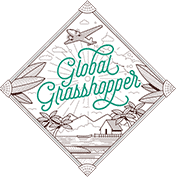
20 Most Beautiful Places to Visit in Tunisia
Although it’s famous for its warm winter sun, dunes and elegant spas, the smallest country in North Africa is not always synonymous with beauty. Still, of course, beauty is subjective and I think it’s vastly underrated and is home to many places easily worthy of the word!
From magical mountain oases and atmospheric holy cities to some of the most sought-after beach resorts and from my time spent exploring this unique country, here are my favourite spots…
1. Hammamet
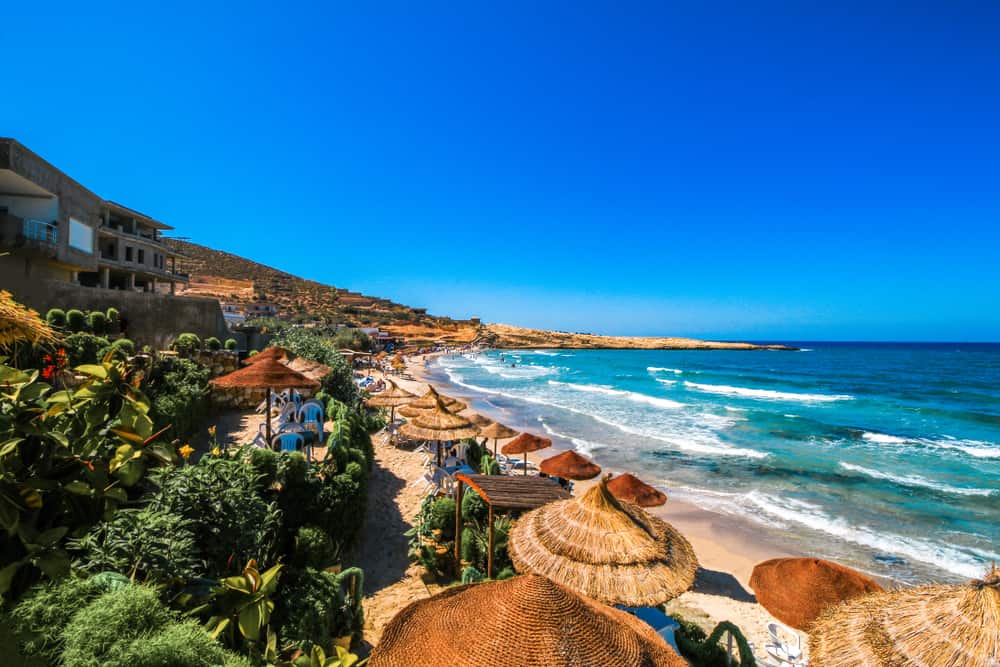
Once a humble fishing village surrounded by lemon groves, Hammamet is now a thriving beach resort town with numerous hotels.
Sharing the same Mediterranean coastline as Egypt , this is one of Tunisia’s first tourist destinations due to its fine beaches and warm waters, perfect for water sports. The area is home to some of the most beautiful beaches in the country, and I’m a huge fan of this place!
It’s not all about all-inclusive hotels and sunbathing. Hammamet has a beautiful historic centre crisscrossed with narrow alleyways. Here, you’ll find an attractive medina and a 12th-century Kasbah, which I highly recommend exploring.
Location: – Hammamet is in Nabeul Governorate east of Tunisia, less than an hour’s drive from Tunis airport.
Book A Trip!
We can book your trip hopping around Tunisia’s beautiful places through our free, top-rated travel planning service !
2. Sidi Bou Said

Tunisia’s prettiest town is perched on a cliff overlooking the Mediterranean. Its gorgeous traditional houses have been whitewashed to perfection and beautifully accented with flashes of brilliant blue.
It’s long been a bohemian enclave, but with a few trendy boutique hotels popping up, it now attracts a more well-heeled crowd.
I suggest exploring the narrow, cobbled streets with cafes, art shops, and souvenir stalls framed by abundant fragrant, cascading flowers. The town also makes a great base to explore the nearby Roman ruins of Carthage.
Location: Sidi Bou Said is a town located in northern Tunisia, about 25 minutes drive from Tunis airport.
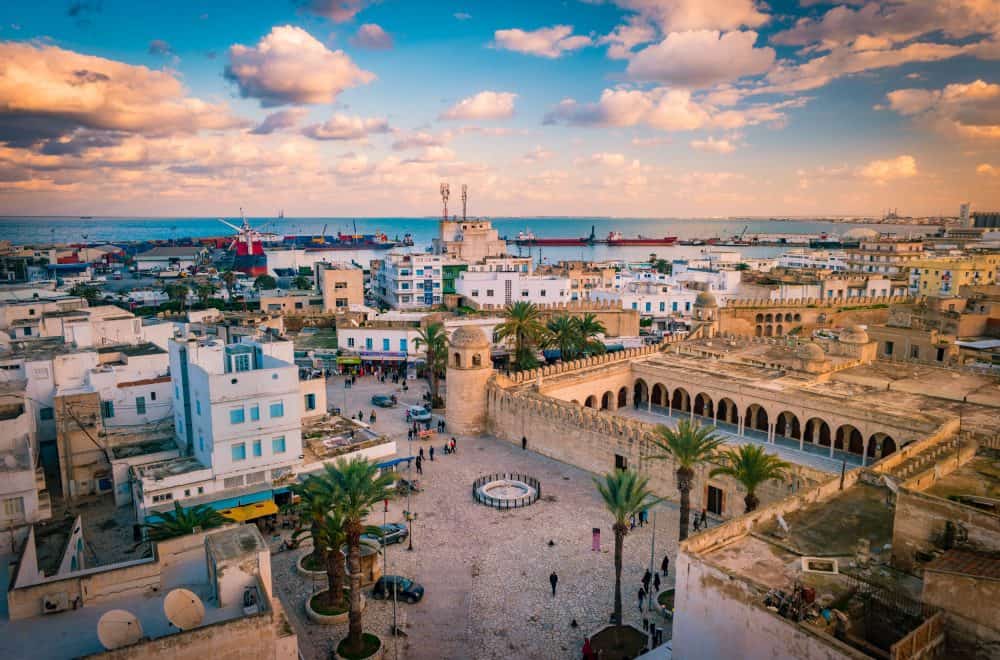
Located right on the coast, this former military port is known for its beautiful sandy beaches and UNESCO World Heritage site status. It’s both a bustling tourist resort and a beautifully preserved place. In my opinion, it is a fine example of a town dating from the first centuries of Islam.
Visit for outstanding Arabo-Muslim and Mediterranean architecture, including ramparts, a Ftata Mosque, a typical ribat and a medina, also home to the city’s Great Mosque.
Location: Sousse is located on the Tunisian Sahel coast in the centre of the country, a 2-hour drive from Tunis airport
4. Port El Kantaoui

Luxury is everywhere in Port El Kantaoui. Beach resorts throughout the area cater to every waking need of their high-end visitors, but rest assured; you do not have to be a part of the luxury sect to enjoy the sheer beauty of Port El Kantaoui.
This Tunisian destination is ideal for tourists from every walk of life, whether you want to relax along the coastline and soak up some sun or dive beneath the surface of the water for some supreme snorkelling.
I personally think it’s everything you could want from a luxury coastal destination is all in one location here!
Location: Port El Kantaoui is located 10 kilometres north of Sousse city in central Tunisia, around an hour and 40 minutes drive from Tunis Airport

With a population of around 170,000, Djerba is not considered a small village.
It is also among the more popular tourist areas in the country, but people do not simply come to Djerba for access to the spectacular beach or even for its handmade crafts throughout the city.
People enjoy a more diverse religious culture in Djerba that is not accentuated as much in any other part of Tunisia. Here, you can learn about a new religion and culture while enjoying a picturesque coastal destination. I love this place!
Location: Djerba is a large island in southeastern Tunisia. Many people drive from Tunis airport, stopping on the way, as it’s a 6-hour trip. Once near, you can get a ferry to the island.

Nabeul is not just a fine place for locals to enjoy but also Tunisia’s first seaside resort! On both sides of this easy-on-the-eye resort, you are engulfed by illustrious Mediterranean Sea views.
Nabeul has been charming locals and visitors alike since the 5th century BC and has also charmed me! There are also many hotels and guest houses to stay in to take advantage of the beautiful beaches here.
Today, artisans throughout Nabeul are known for making some of the most beautiful mosaics, painted dishes, potteries, and wall tiles, so I highly recommend visiting one of the many shops dotted along this remarkably beautiful coastal city.
Location: Nabeul is a coastal town located in northeastern Tunisia, just over an hour’s drive from Tunis airport
7. Cap Bon Area

The peninsula lying at the country’s Northeastern tip is so alluring that it’s often referred to as the “garden of Tunisia.” It’s also a popular resort area, but it’s popular for a reason.
Filled with sun-drenched beaches with a clear blue sea, thermal springs, fragrant eucalyptus trees, lush palms and sweet-smelling flora this area I personally think this place deserves a place on this list!
Location: is a peninsula in far northeastern Tunisia located around an hour and 20 minutes from Tunis airport

A charming and authentic resort in northern Tunisia is one of those places where you can stay and live like a local for a while, far from the tourist crowds.
Aside from a beautiful long sandy beach, other reasons to visit here include the picturesque old port with gently bobbing boats, a pretty coastline, and an incredible road cut into the coast. I would highly recommend trying out some of the excellent restaurants also located here!
Location: Bizerte is the northernmost city in Africa, an hour’s drive from Tunis Airport.
9. Tunis Medina, Tunis

In my opinion, the most striking part of the country’s capital city is the old Arab-walled town, otherwise known as the Medina. Expect fine examples of Arab architecture and lively souqs where everything from household goods to gold can be bartered for.
The atmosphere is intoxicating, and it gives you a taste of what life was like in the Arabian opulence era, which reigned from the 12th to the 16th centuries. I would highly recommend a visit!
Location: Located in the capital of Tunis on the northeastern coast, about a 20-minute drive from Tunis airport.
10. Monastir Ribat

A visit to Monastir Ribat is essential to get the most out of your Tunisian adventure. Today, Monastir Ribat is considered a holy site as it maintains two mosques servicing the city of Monastir, but it was not always so calm there.
In 796, Monastir Riba was built as a military structure to ward off invaders. Throughout its many-century history, rooms and additions have been added to ensure the building is always relevant.
I recommend enjoying walking around Monastir Riba and taking pictures of various architectural feats throughout its history!
11. Plage de Chaffar, Sfax

Strolling around Sfax will allow you to see many beautiful locations, such as the Museum of Architecture. Still, if you are looking for somewhere to relax and enjoy Tunisia’s natural beauty, Plage de Caffar is the place to be.
This beach destination has a mild climate and white, sandy beaches. It is where locals bring their families to enjoy fun in the sun in Tunisia.
Although it is a popular place for tourists and locals alike, this beach remains a calm, relaxing area to enjoy any time of the year.
12. Chebika

Of course, it’s all a matter of opinion, but arguably, the most beautiful places in Tunisia are far from the cities. Chebika, which lies at the foot of the mountains of the Djebel el Negueb, is a perfect example.
Here, an Eden-like oasis of beautiful waterfalls, curious caverns, and date palms surviving in rocky clefts is a dramatic sight – unsurprisingly, a popular tourist haunt.
It’s also popular with film directors, as scenes from Star Wars Episode IV and The English Patient were shot in this area.
13. The Sahara

Visitors should include the world’s largest desert on their itinerary, and tours arranged by most resort towns can reach the Sahara.
The Eastern Sand Sea (Grand Erg Oriental) covers a large part of Southern Tunisia. It’s a magical place where scenes from Star Wars and The English Patient were once filmed.
The area is best explored by jeep, but to really up the romance stakes, include an overnight stay in a traditional tent. Ensure you don’t miss Nefta, the most beautiful dunes in Tunisia and Chott el Jerid, a vast salt lake.
14. Matmata & the Ksour

Movie fans would instantly recognise the intriguing troglodytic houses of Matmata. When director George Lucas visited here, he was so taken with the area that he used it as a set in his famous Star Wars films.
I love that it’s a uniquely beautiful place, home to attractive honeycomb-esque granaries known as ghorfas. The curious architecture style stems from fortified Berber settlements and is so unusual that it almost looks other-worldly.
15. Chott el Djerid

Unique is a word thrown around by visitors to Chott el Djerid. When visiting, you might believe you have seen it before. If you are a Star Wars fan, you probably have as many Tatooine scenes shot in this location.
Chott el Djerid is a saltwater lake, and throughout the year, geological changes change the water’s colour—it turns all kinds of crazy hues: purple, pink, and red.
I would suggest walking along the water’s edge and seeing its natural salt deposits. A popular activity for Chott el Djerid visitors is to fly over the lake in a paraglider to get a bird’s eye view of its amazing beauty.
16. Tamerza

The largest mountain oasis in the country is also a popular beauty spot and has an abandoned old town. Located in the mountains north of the salt lakes, it’s an intriguing place with two waterfalls, an oasis, and deep gorges.
The town was abandoned after the 1962 river floods, and today, it’s eerily quiet. I suggest making sure you include a visit to nearby Mides, another mountain oasis home to a spectacular canyon.
17. Kairouan

This important holy city has also been designated a UNESCO World Heritage Site . Founded in 670, it has a rich architectural heritage, an attractive medina, and lively souqs.
My favorite highlights include the Great Mosque of Okba – one of Tunisia’s largest and oldest mosques and the 9th-century Mosque of the Three Gates.
18. Ichkeul Lake

Beaches and coastal destinations have their allure, but Ichkeul Lake has an attraction of its own. If your destination is northern Tunisia, I personally think Ichkeul Lake is the place to go.
For those who enjoy bird watching, this lake boasts intricate wetlands that attract thousands of migrant birds each year, including the stunning flamingo.
Although construction on the dam for the lake has changed its ecological standpoint somewhat, birds and wildlife such as ducks, storks, flamingos and geese are still prevalent in the area.
19. Bou-Hedma National Park

National parks are treasures to behold, and in 1980, Bou-Hedma National Park was founded in Tunisia. Today, it is on the list of UNESCO heritage sites for its ecological significance and illustrious history. It is home to ancient Roman structures beautifully preserved within the park.
Animals such as Gazelles can be seen throughout the park, but endangered creatures such as the Addax Antelope also call Bou-Hedma National Park home.
A museum was recently built within the park’s borders to help you learn more about the park and its ongoing conservation efforts. I suggest visiting if you can to learn about this interesting area.
Please always check the latest government advice before deciding on any travel destination.
21 thoughts on “20 Most Beautiful Places to Visit in Tunisia”
thanks for posting these pictures but i have so much pictures and they are better btw
Thanks for sharing such mind blowing pictures from Tunisia. So money saving starts for my next year’s vacation 🙂
Tunisia is amazing indeed! You can take a look at my post about Tunisian part of Sahara (linked below.
Such stunning pictures! It seems like there are so many different variety of places to visit in Tunisia with so many different cultural and environmental experiences. Definitely adding this place to my bucket list.
I’ve been recently and all these choices are good, I’d have to give a special mention to the Roman ruins and the spa hotels are pretty incredible too!
The spa hotels are gorgeous!
Well it definitely looks beautiful in these photos! I’ve never really considered it before as a travel destination to be honest, but it looks as though I’m missing out!
I love this list, I have never considered traveling in Tunisia, always somehow connected it with all inclusive cheap holidays deals until now, you have change my mind! Bravo!
Thanks Marysia, I’m glad we did! 🙂
So many beautiful places, Sidi Bou Said looks gorgeous!
OMG that shot in the Sahara!!!!! All those places look nice. But my last trip was Morocco so for the next few I will try something radically different. But I will keep in mind this post for the future! Thanks
These places in Tunisa looks amazing! Sidi Bou Said reminds me of Greece. Beautiful photos too!
I have never been to Tunisia, and dream about Sahara for years… Great list! Beautiful photos. Now I wanna go even more [smile]
Wow, I’m impressed. I’ve never thought about visit Tunisia, I even don’t know why, this place just haven’t have been on my mind, never. But looking at these photos it would be a shame if I wouldn’t go there.
Hope you get to go one day, it’s a very underrated place!
I would absolutely have to go to Tunisia just to visit the old Star Wars set! A lifelong dream come true for me and before the sand engulfs it permanently. I would love to sit and people watch in the Medina, Becky! That looks like so much fun. Btw…the pictures are amazing. Especially that one of the Sahara…wow 🙂
Not a place I had ever really though of visiting before until now. The moon pic is amazing! Adding this to the list..
Great list! Hammamet actually reminds me of a fish market in Bali, Indonesia!
Thanks Agness!
I like your list. I have to say I liked a few other places better and was really kind of disappointed in Sidi Bou Said,let alone where Star Wars was filmed, however I loved Tunisia. My favorite place by far was El Kef! Great post.
I have never been there, looks like some really nice places to visit .
Leave a Comment Cancel reply

The Tunisian Way
Learn about Tunisian life
Tunisia bucket list – 40 things to do and see in Tunisia
Are you looking for the ultimate Tunisia bucket list? Keep reading for 40 suggestions. I have spent months in Tunisia. But still, I haven’t seen all this country has to offer! I have seen and experienced a lot in Tunisia, and that’s why I wanted to share these things with you too. I have put together this Tunisia bucket list – 40 things to do and see in Tunisia. So, now you don’t need to spend ages researching things to do. From the charming Sidi Bou Said to camping in the Sahara Desert, this list includes all the must-do activities in Tunisia. I hope you find this Tunisia bucket list handy on your trip.
Tunisia bucket list - 40 things to do and see in Tunisia
1. wander around la medina, tunis.
La medina literally means city or town, which are known for narrow and maze-like streets. From La medina, you will find hundreds of little boutiques (=souks) that sell products from handcrafted jewelry to colorful carpets and vases. It’s easy to spend hours or even days wandering around La Medina. Visiting charming boutiques, stop at one of the many restaurants and cafes, admire brightly painted doorways, hammams, mosques, and madrassas. Visiting La medina is a mandatory place to visit. That’s why it is on this Tunisia bucket list – 40 things to do and see in Tunisia.
2. Tunisia bucket list: Have a day trip to Sidi Bou Said
Your trip to Tunisia won’t be complete without seeing Sidi Bou Said. It is one of the most famous and beautiful places in Tunisia. It’s known for blue and white houses and cobblestoned streets. This charming seaside town is located about 20km north of Tunis. This popular tourist attraction is definitely worth visiting. Stroll through the old town and explore art galleries, cafes, restaurants, and small boutiques. And do not forget to eat a well-known Bambalouni, a delicious Tunisian doughnut. At the end of the day have dinner in the restaurant La Villa Bleue : stunning view, beautiful milieu, and delightful food.
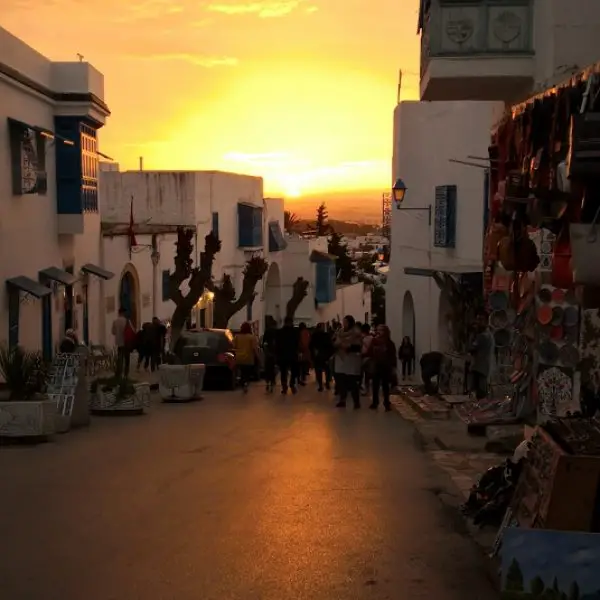
3. Tunisia bucket list: Visit Ez-Zitouna Mosque
I didn’t know much about Tunisia when I had my first trip there. But I had one thing in my mind: To visit the famous Zitouna mosque. This absolutely gorgeous mosque is located in the heart of Tunis Medina. If you are a non-Muslim then you have a right to visit just the courtyard, but it is definitely worth visiting. This place has an amazingly peaceful atmosphere, which makes it a great escape from the hectic Medina. Remember to dress correctly for the Mosque visit. Tip: women need to cover their hair. At the entrance, there are boutiques where you can borrow a scarf if you don’t have one with you.
4. Discover the Bardo National Museum
If you love culture and you are interested in the history of Tunisia, you should visit the Bardo National Museum . It happens to be one of the most important museums on the African continent. Additionally, they have a stunning collection of mosaics and sculptures. You can easily spend one day there and a lot of people say that it is a must thing to do in Tunisia.
5.Tunisia bucket list: Drink Tunisian coffee in one of the thousands of cafes
Tunisia has a really strong café culture. The atmosphere is really unique, which I have never experienced in any other country. It is a perfect opportunity to experience how Tunisian people live their everyday life. The cafes are the meeting points for Tunisian people and it’s really common to visit your local café many times per day. You will see cafes full of all kinds of people: a young, old, group of friends, foreigners, females, and males. On your visit try Tunisian espresso, capucin, direct, and qahwa Arbi (Arabic coffee). Here you find more information about Tunisian drinks.
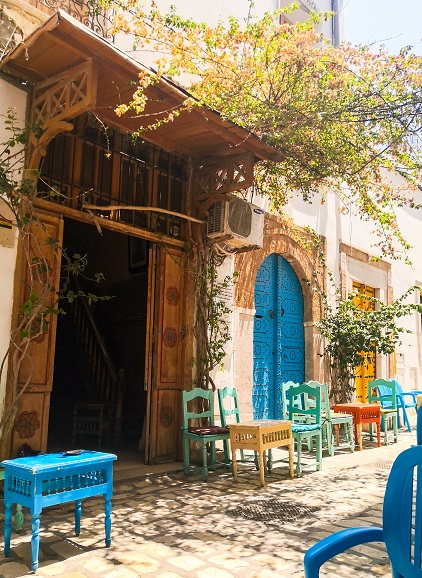
6. Eat Bambalouni in Sidi Bou Said or La Goulette
Bambalouni is one of the traditional Tunisian sweets that you have try to on your trip. Famous Tunisian doughnut Bambalouni is usually served with sugar or chocolate sauce. You can buy this mouthwatering pastry from street vendors in Sidi Bou Said or La Goulette. If you have a big sweet tooth here you find a list of Tunisian sweets you should try on your trip .
7. Swim in the Mediterranean Sea
When I asked my husband what are the must things to do in Tunisia. The first thing he said is to swim. Tunisia has a long coastline with some of the Mediterranean’s most beautiful beaches. That is why Tunisia is a perfect destination for beach-lovers! Some of the best beaches are located in Hammamet, Monastir, Djerba, El Haouaria, Cap Angela and Sfax.
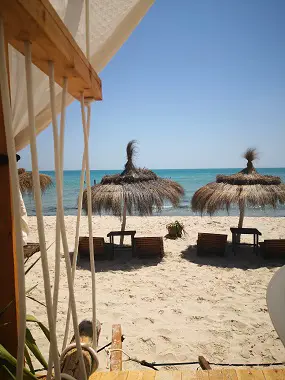
8. Go to see Flamingo Island (Ras R’mal)
Djerba is an island that is also a very popular tourist destination. It’s known for stunning beaches and picturesque villages with whitewashed houses. There is also a very magical place that you should visit without question. The exotic Flamingo Island is a mandatory place to visit when on Djerba. If you are willing to see thousands of beautiful flamingos then go to this island in the winter months October-February. During the summer the flamingos are not there. But with flamingos or not, this beautiful island is still worth visiting and a boat ride to this island is also a great experience.
9. Tunisia bucket list: Pay a visit to the Sahara Desert
If you are looking for an adventure and once-in-a-lifetime experience, visiting the Sahara Desert is one of the best things to do in Tunisia. I would say that to have a full experience you should stay overnight in Sahara. There is nothing more magical than eating dinner around a campfire, under the sky full of stars. If you are planning to have a day trip you can discover the dunes and oasis with camel ride, quad bikes, or 4W ride.
There are many great clubs, bars, and lounges to party in Tunisia. I am sure that you will find one that fits your wishes and expectations. If you are looking for a place to have fun, there is a great app called Ija, that you should download on your phone. You will see a list of clubs, bars, restaurants…Then you pick the place that suits you and you can do a reservation and hopefully, you got it accepted. Then when you enter the place, you simply show the accepted reservation.
One of the greatest things about traveling is to discover new food cultures. I love Tunisian food and I don’t mind that eating out is very affordable also. Tunisian cuisine is full of magical dishes, so you can easily try a new delicious meal every day. Here I have written guides for Tunisian dishes , sweets , and drinks . Those will help you at the beginning if you don’t know where to start. Tunisia is a perfect destination for foodies and people who love to eat.
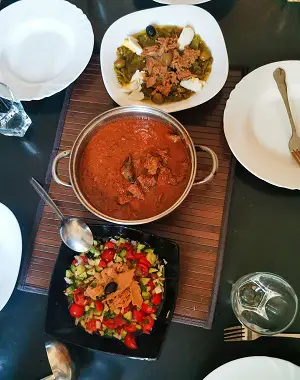
12. 40 things to do and see in Tunisia: Go to Hammam
Hammam known also as the Turkish bath is a communal bathhouse. Hammams are an important part of Tunisian culture. I really recommend visiting a local Hammam during your trip as it is an experience that you don’t want to miss. So how does it work? Shortly answered, first you will sit in a steam room that will soften your skin. After that, the professional washers will give your full body scrub and wash your body. You will be shocked how much dead skin will get off. Men wear boxers or towels around their hips and women wear panties but you can also put a towel around your chest if you don’t feel comfortable. After the Hammam drink something refreshing like lemonade or Fanta.
13. Ride the camel
In Tunisia, you will see camels a little bit everywhere: at the beach, the Sahara Desert, or even in front of the café. There are many tour operators offering camel rides in the Sahara Desert, which will be a great experience for sure. Often, you will see people selling camel rides at the beach, which is a more affordable option than heading to the Sahara. If riding a camel is not a thing for you at least you can take a picture of this majestic animal.
14. Enjoy the live music
Now is your perfect opportunity to discover traditional and newer Tunisian music. Music is very important for Tunisian people, and it plays a big role in their lives. The Tunisian weddings and other celebrations are filled with traditional Tunisian music. So, if you have an opportunity to go to a live music concert, you really should go! In the concerts, the atmosphere is always very good and listening to traditional music is a great way to understand Tunisian culture. In addition, Tunisian people love to dance and have fun.
15. Tunisia bucket list: Go to the Arabic disco
If you are fed up with westerns style nightclubs, I recommend going to the Arabic disco. I remember my first time in the Arabic disco, and it makes me laugh. In the Arabic disco, they play traditional Arabic music, and Tunisian people have their own kind of way to dance these songs. The evening was also filled with oriental dancers and fire performances. So, it’s totally a new experience if you are not familiar with Arabic culture beforehand.
16. Buy a handcrafted Tunisian product
On your stay in Tunisia, you will explore unique markets and souks in medinas with a wide variety of beautiful products. Tunisia has a long history with handcrafts, and there are numerous amounts of local specialties. Leave some space in your suitcase as you are surely heading home with a suitcase full of beautiful Tunisian souvenirs. In this article , I have listed 13 things to buy from Tunisia.
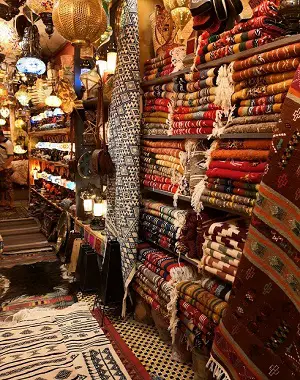
17. Visit Tunisian bakery, and buy a box full of goodies
Tunisia has a strong love for sweets. Tunisia offers a great range of handmade sweets, crunchy cookies, and delightful pastries. Visit one of the many Tunisian bakeries, and start testing all the delicious Tunisian sweets. Try at least: Samsa, Zouza, Baklava and Makroudh. I wrote a blog post about 10 popular Tunisian sweets you need to try . If you are looking for high-quality and Instagram-worthy sweets then go to Patisserie Masmoudi .
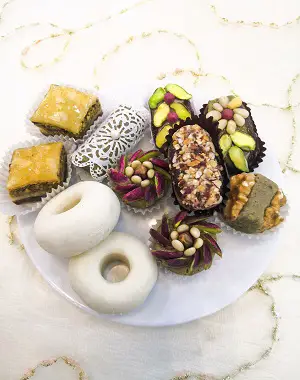
18. Drink refreshing Tunisian lemonade
During hot summer days, there is nothing more refreshing than a glass of cold citronnade/lemonade served with an almond biscuit. The Tunisian lemonade is made of fresh lemons, water, white sugar, and vanilla sugar, this creates juice that is super sweet, fruity, cloudy, and less bitter if compared to the American lemonade. It can be seasoned with mint. It is super delicious, and kids will love it also. This thing is really at the top of my Tunisian bucket list! This drink is so yummy!
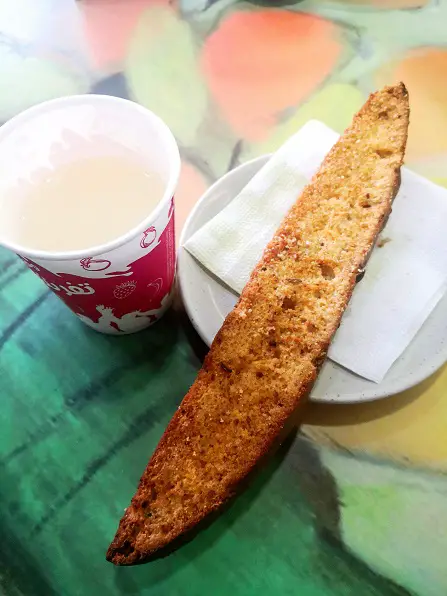
19. Go to see amphitheater El Djem
El Djem is a must-place to see in Tunisia. Especially, for a history lover. Every year thousands of tourists visit the biggest historical tourist attraction in Tunisia. A very well-preserved Roman amphitheater is one of the biggest in the world. It’s located in a small village called El Djem. If you are in Tunisia mainly to enjoy swimming and sunbathing, this majestic UNESCO World Heritage Site is something that you should not miss.
20. Take pictures of the colorful doors of La Medina, Tunis
If you are looking for free things to do in Tunisia, this is a great tip for you! Might be that you have seen pictures of beautiful colored wooden doors in Instagram or Pinterest feeds. One of the greatest spots to see these beautiful wooden doors is in La Medina, Tunis. Now, fill up your social media feed with stunning pictures also.
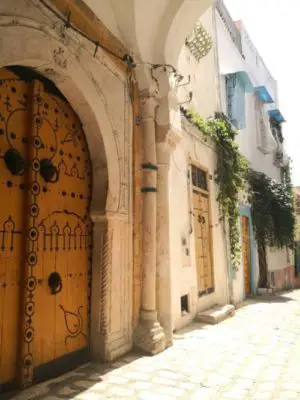
21. Go to the market square and buy plenty of fresh fruits and vegetables
I am not sure if it’s only me but I truly enjoy visiting the market squares. I love the fresh and organic products, talking with the sellers, and the atmosphere in general. I understand that you don’t necessarily want to fill your hotel room with tomatoes and cucumbers. But you should go and buy fresh dates instead.
22. Visit Tunisian spice store. Tunisia is a great place to buy spices
Here, I wrote a guide about the most traditional and popular Tunisian spices . So, check it out! It will help you to decide what spice you should buy. The spice stores filled with piles of colorful spices are very beautiful, so you can also spend a day simply window shopping without buying anything.
23. Try harissa, Tunisian hot chili pepper paste (must thing on your Tunisia bucket list)
This Tunisian bucket list- things to do and see in Tunisia wouldn’t be complete without harissa. On your stay in Tunisia, very fast you get to know this hot chili paste as it’s served everywhere and all the time. It’s an important ingredient in many Tunisian traditional dishes. If you a fan of spicy food, buy a couple of cans of this hot goodness. Harissa is a very useful product in your pantry as there are multiple ways to use it. How could I write the Tunisia bucket list without including harissa?
24. Tunisia bucket list - 40 things to do and see in Tunisia: Eat Tunisian dates
Tunisia is one of the world’s biggest producers and exporters of dates. There are hundreds of date types that are divided into groups: soft, semi-dry, and dry depending on how moist is the date. The most produced date in Tunisia is Deglet Nour “finger of light” other typical dates are Allig, Khouat Allig, and Kenta. Buy a packet of dates as a souvenir or maybe one of the many date products like honey, vinegar, oil, or powder. Fascinating fact: maybe you have heard about a belief among Muslims, that dates should be eaten in odd numbers to gain the maximum amount of health benefits.
25. Go for a long beach walk
Having long beach walks is one of my favorite things to do in Tunisia. It’s an amazing way to start a morning, and it’s so relaxing. If you are a sporty person, the long coastline is a perfect place for running. During the summer it’s better to go for a run, in the early morning or late evening when the weather isn’t too hot yet. This thing is a great addition to your Tunisia Bucket list.
26. Have a coffee at Panorama Medina Café, Tunis
Next on this Tunisian bucket list- 40 things to do and see in Tunisia..Panorama Medina cafe! If you are looking for a café with a stunning view visit the Panorama Medina Café. The rooftop café itself is also amazingly beautiful with all the mosaic details. The place might be a little bit tricky to find, so my advice is to take a screenshot of the place and show it to the people and they will kindly show you the way.
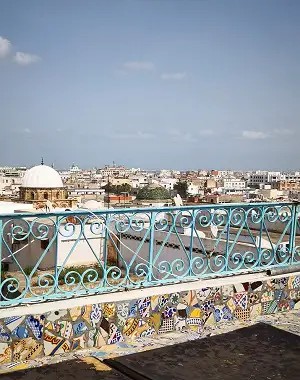
27. Tunisia bucket list wouldn't be complete without this: Get to know Tunisian people
One of the most beautiful things in Tunisia is the Tunisian people and their hospitality. There are so many amazing people who are incredibly generous and warm-hearted. So, my advice is to get to know Tunisian people. There might be a little language barrier with some of the people but it does not matter. With Tunisians, you will learn about the Tunisian culture and lifestyle. This is the best way to discover the real Tunisia.
28. Eat Mezza and plenty of seafood
Is there anything better than fresh seafood with a very affordable price? In Tunisia, you will have a great opportunity to eat seafood that has been caught in the morning. So delicious! Other, great tip is to eat Mezza: a selection of grilled meats and seafood. If you are in Tunis, go to the restaurant Omek Sanafa and eat mouthwatering Mezza at a good price. They also offer a good selection of traditional Tunisian meals if the Mezza isn’t for you.
29. Places to see in Tunisia: Visit Star Wars filming spot
You need to head towards southern Tunisia to see the original sets where the famous Star Wars were filmed. Some of the filming spots are destroyed by time but there are still many places worth visiting. Some of the well-preserved places are located in Matmata, Tozeur, Tataouine, and Djerba Island. Most of the filming spots are located in the desert and might be hard to find. So, contact one of the many tour operators and make the most out of this experience. It is a must place to visit, and a very popular attraction among tourists, especially if you are into Star Wars. So of course this place found its’ place on my Tunisia bucket list.
Tunisia’s beautiful and long coastline has many wonderful diving spots. People say that going under the sea is one of the best things to do in Tunisia. Clearwater, colorful coral reefs, shipwrecks, and lively sea life make Tunisia a perfect destination for a diving holiday. There are many great places to start discovering life under the sea in Tunisia. So, here is just a couple of options to get you started: Tabarka, Hammamet, Bizerte, Port El Kantaoui, Mahdia and Djerba.
31. Discover Matmata caves
Matmata is a small town located in southern Tunisia. It’s famous for being one of the few Berber villages and their special way of housing. Its unique architecture makes it a popular destination among tourists. Matmata was one of the locations where the legendary Star Wars movies were filmed. You need to have Matmata caves on your Tunisian bucket list.
32. Go for a road trip
One of the greatest ways to explore a new country is to rent a car and go for a road trip. Tunisia is a really versatile destination: mountains, the Sahara Desert, long coastline, small villages, and big cities. It’s also an amazing way to find hidden beaches and try the area’s food specialties! If you are planning to have a road trip during the summer, I highly recommend renting a car with an AC. Tunisian traffic is also a bit chaotic, so pay attention when driving.
33. Tunisia bucket list: Experience Ramadan
If your visit to Tunisia takes a place during the holy month of Ramadan, you should make the most out of the experience. During the daytime, the country is really calm and very lively during the night. Cafes, patisseries, and restaurants are open during the night and all kinds of music are played on the streets. To get the real experience, I advise you to visit a Tunisian home: cook many beautiful meals with them and when the time comes to break the fasting with the meals you cooked before.
34. Places to see in Tunisia: Visit the pottery capital Nabeul
Nabeul is a town located 65 km from Tunis. It’s famous for pottery and handcrafted ceramics. You can find all kinds of ceramic items: glazed, unglazed, colored, neutral. Walk around the streets and you won’t find only pottery boutiques but also other handcrafts: stone, gold, silver, fabric, perfumes. It’s a great place to fill up your luggage with Tunisian products.
35. Visit Tunisian family place
The best way to get a full Tunisia experience is to visit a Tunisian home. It’s a great way to see their everyday life. Especially old Tunisian homes are very stunning: high room heights, vivid tilework, and colorful window frames. And get ready for Tunisian hospitality. You will eat and drink a lot!
36. Barbeque
In Tunisia, you will find special barbeque restaurants. In the restaurant, they have a selection of fresh meat and you will choose the pieces you want. They will barbeque those for you in a charcoal grill. Fresh meat combined with smokey flavor is so delicious! At Tunisian homes or boutiques, you might see small clay pots filled with charcoal. A metal rack is placed over the pot and then we grill! You will wave a hand fan and keep fire in charcoals. This way of grilling is very popular on Eid-al-Adha when sheep and goats are slaughtered as a sacrificial gift.
37. Try Henna
Henna has a big role in Tunisian culture. It’s said that it brings good fortune to a bride. Henna party is one of the most important days for Tunisian women. Henna is a natural dye that is used to decorate hands and feet with beautiful patterns. On the steers, you will see women painting beautiful patterns for their customers. Often, they use Harkous instead of Henna. The easiest way to tell the difference between Henna and Harkous: Harkous smells good and it’s much thicker compared to Henna.
38. If you get the chance visit the Tunisian wedding
If you ever get invited to a Tunisian wedding, you should definitely go. It’s an amazing combination of culture, hundreds of people, beautiful outfits, traditional music and a lot of food. Before the wedding was week-long celebrations, so you can imagine that Tunisian people take wedding very seriously.
39. Things to do in Tunisia: Hiking
Might be that the first thing that comes to your mind about Tunisia is not hiking. But actually, Tunisia has many breathtakingly stunning hiking spots to offer. You can also rent a bike or go for a horse ride. A couple of beautiful spots to mention: Lake Ichkeul, El-Haouaria, Zaghouan and Kairouan.
40. Have a beauty treatment
On Monday manicure, Tuesday pedicure, Wednesday facial, Thursday hairdresser, Friday massage… During your holiday you have a great opportunity to have many beauty treatments at very affordable prices. Maybe Tunisia will be your next destination for a girls’ trip.
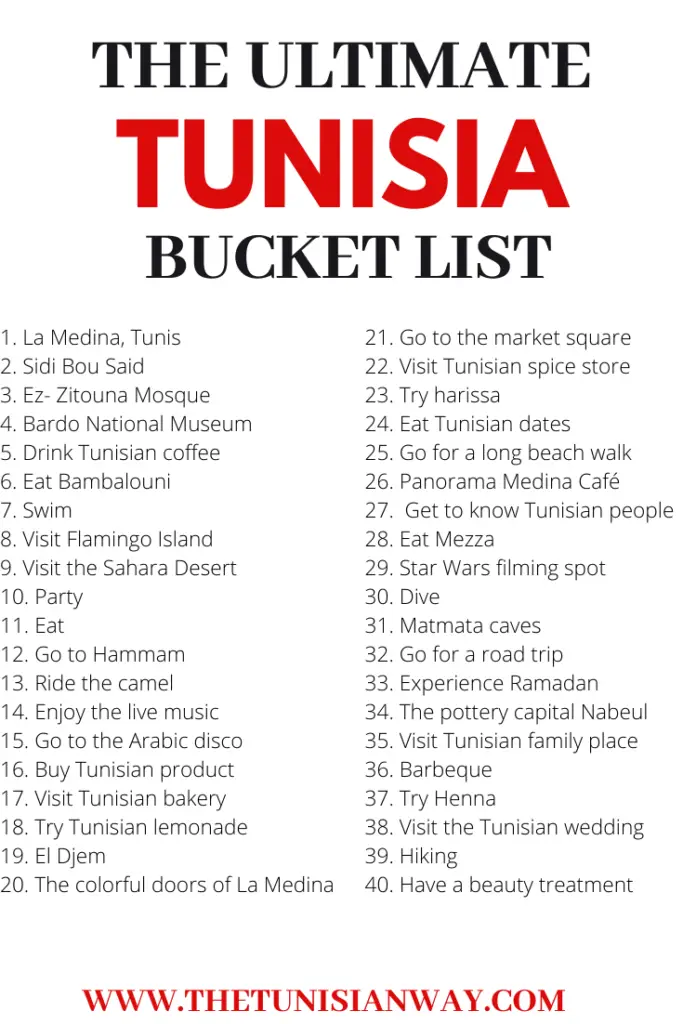
I hope you enjoyed this Tunisian bucket list – things to do and see in Tunisia. I am sure that from these 40 things you will find something new for yourself! There are so many great things do and places to see in Tunisia. Is there something else that you would add to your Tunisian bucket list?
Leave a Reply Cancel reply
Your email address will not be published. Required fields are marked *
Save my name, email, and website in this browser for the next time I comment.

Must-see attractions in Tunisia

This sprawling maze of ancient streets and alleyways is one of the most impressive medieval medinas in North Africa and one of Tunisia's great treasures…

El Jem Amphitheatre
This Unesco World Heritage–listed colosseum was the second-largest in the Roman world (after Rome's); it was 149m long by 124m wide, with three tiers of…

Kairouan’s medina feels like it ebbs and flows to a different rhythm to modern Tunisia. Long protected by its monumental walls and babs (gates), most of…

Sousse Archaeological Museum
Located inside the 11th-century kasbah, this museum showcases an extraordinary collection of 2nd- and 3rd-century Roman mosaics, one of the best in the…

Archaeological Museum
A 1km walk from the El Jem Amphitheatre (follow the signs), this museum showcases an exceptional collection of Roman mosaics. All are richly coloured, in…

Bardo Museum
The main draw at the Tunisia's top museum is its magnificent collection of Roman mosaics. These provide a vibrant and fascinating portrait of ancient…
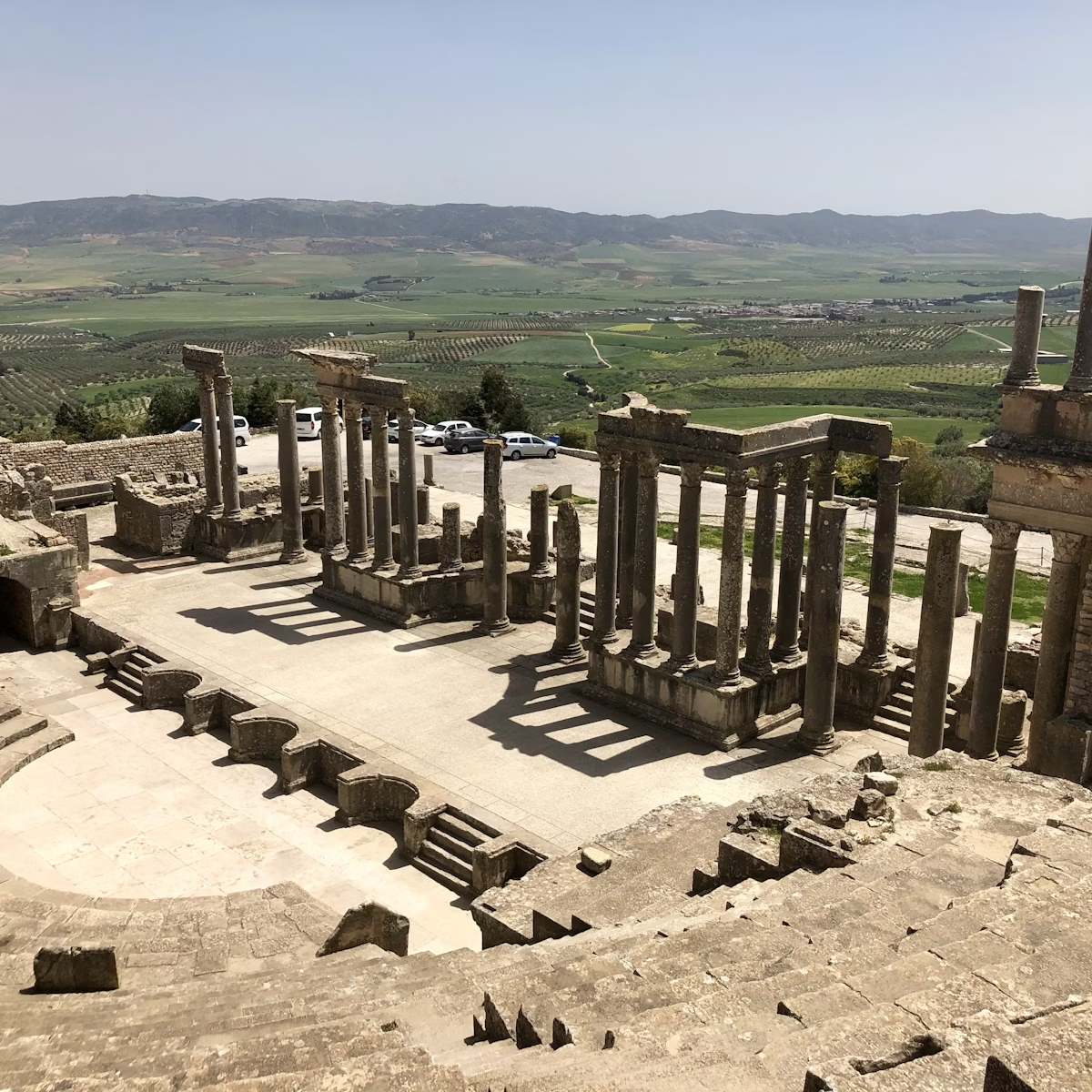
Arguably the most magnificent Roman site in Africa, Dougga’s ancient remains – a Unesco World Heritage site since 1997 – are startlingly complete, giving…

On the cultivated amber slopes of Mt Mekrima, the fascinating but little-visited ruins of ancient Uthina are the remains of one of the Roman Empire's…

There's hardly a souvenir shop in sight within the monumental medieval walls of Sfax's Unesco-listed medina. The narrow thoroughfares are crowded with…

Souq des Chechias
A medina highlight, this hugely atmospheric souq is filled with exquisitely decorated shops producing and selling chechias, Tunisia's traditional blood…
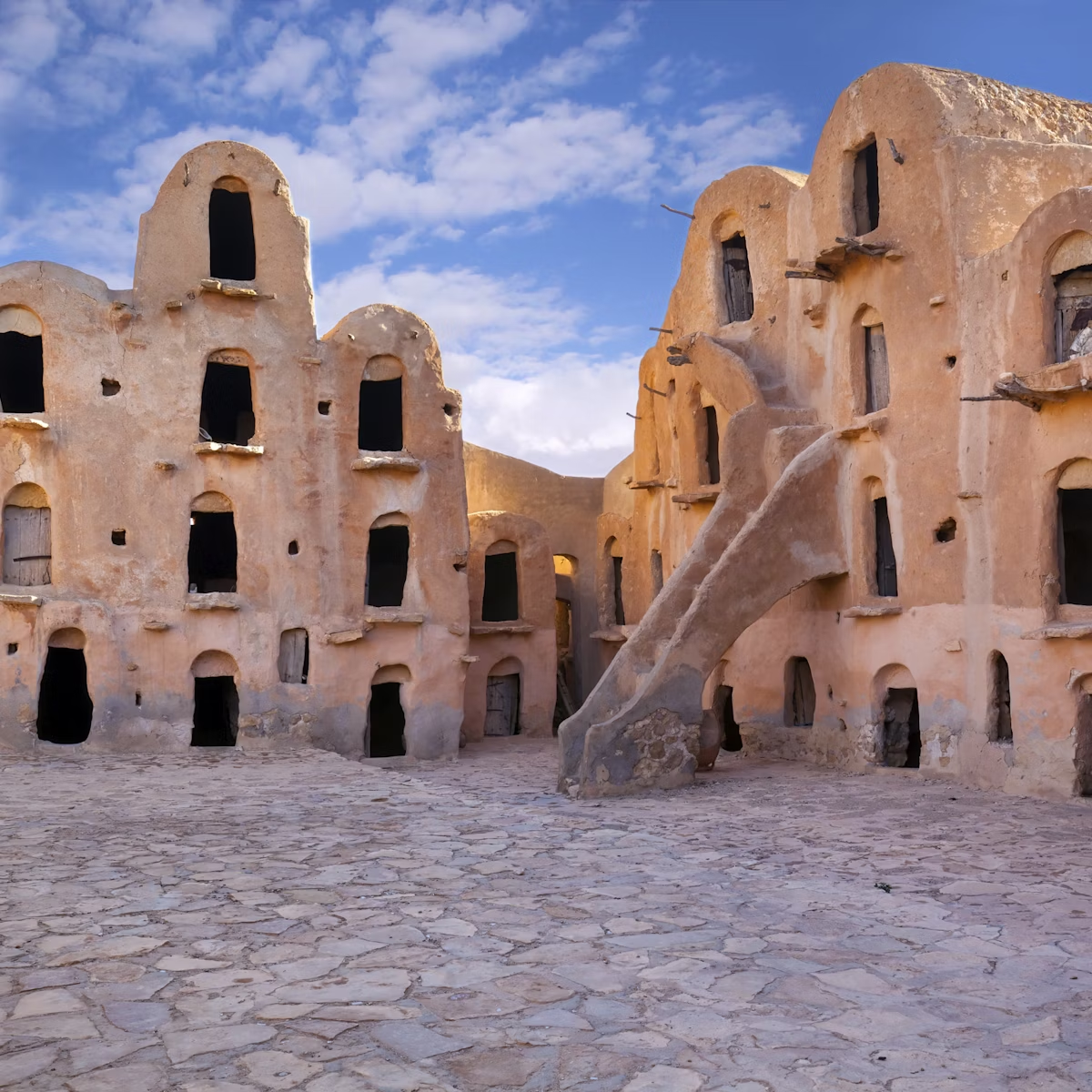
Ksar Oued Soltane
Southern Tunisia
The ghorfas (long, barrel-vaulted rooms built to store grain) of Ksar Ouled Soltane rise a dizzying four storeys around two courtyards and are one of…
Marché Centrale
Tunisian food markets offer a great introduction to local culture, and Tunis' Marché Centrale is particularly atmospheric. The original market building…
Djerba Traditional Heritage Museum
Good things often come in small packages, and that is certainly the case at this modestly sized but extremely impressive museum. Occupying a curvaceous…
In 2014, 150 artists from 30 countries descended on Erriadh to collaborate on an ambitious street-art project. The result was 250 vividly coloured…

One of North Africa's best-preserved ancient Roman cities, Sufetula is awash with temples, monumental arches and bath complexes that speak of an ancient…
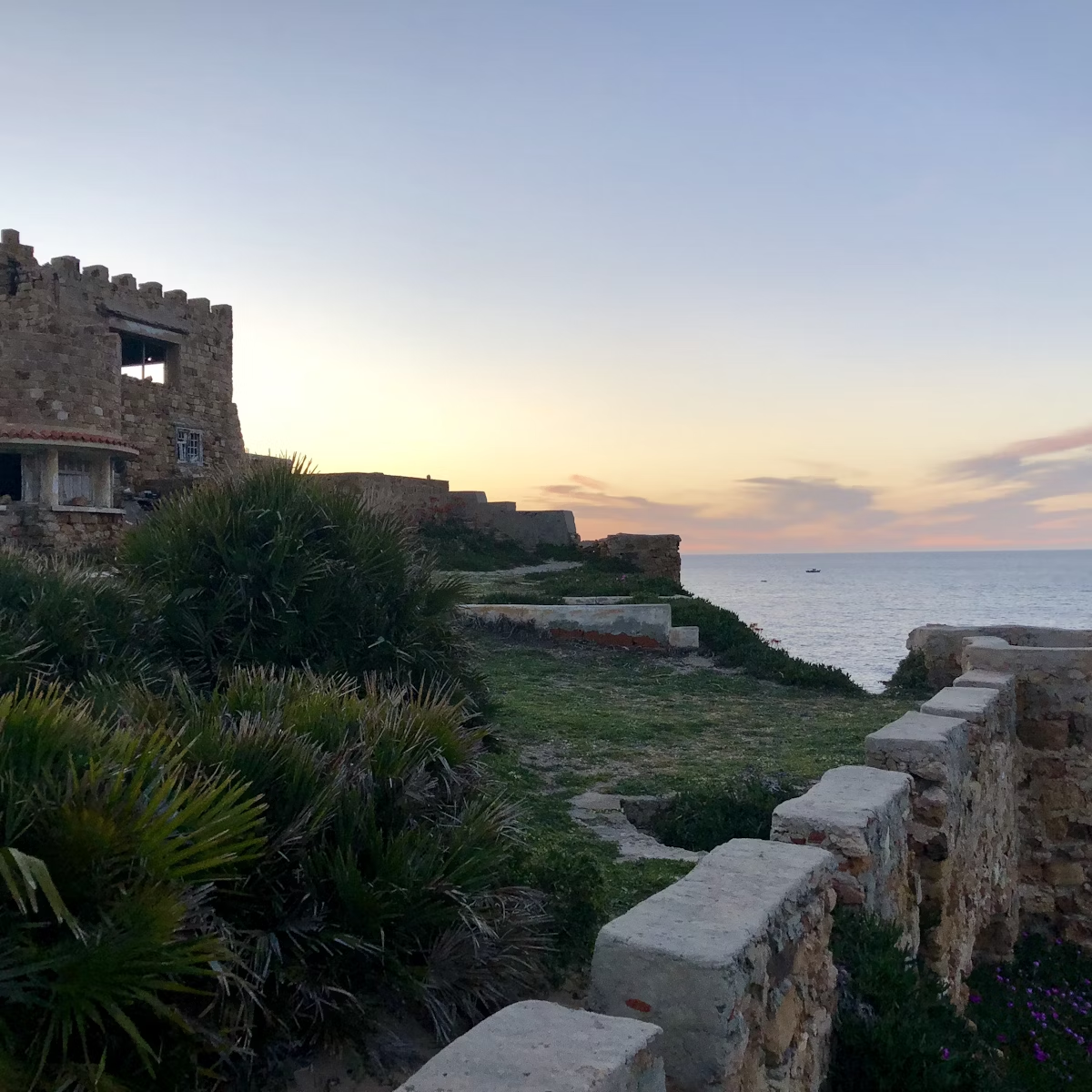
Port Aux Prince
This appealing golden curve of beach is anchored by a rock-hewn castle-like villa, said to have belonged to Wassila Bourguiba, the wife of the former…
This enormous green space has more than 200,000 date palms, as well as fig and pomegranate trees and canopied garden holdings. It's best explored by foot,…

Bulla Regia
Northern Tunisia
Famed for its extraordinary underground villas, the Roman city of Bulla Regia, 7km northwest of Jendouba, offers a rare opportunity to walk into complete,…
The largest marble quarry in ancient North Africa, Chemtou was the source of an unusual, pink-veined yellow marble that was prized throughout the Roman…

Ksar Ezzahra
This is a relatively little visited ksar (Berber fortified granary), which is a shame because it almost rivals Oued Soltane as the best in the region. It…

Thuburbo Majus
Surrounded by shimmering wheat fields and olive groves like those that made its fortune, Thuburbo Majus has a prosperous air even in its ruinous state. In…

The remote border village of Haidra is the site of ancient Ammaedara, once a Roman legionary outpost. It’s a wonderfully evocative place, and the…

Antonine Baths
The Romans chose a sublime seaside setting for this monumental terme (bath complex), a short walk downhill from the Roman villas. Begun under Hadrian and…
Great Mosque
Also known as Sidi Okba Mosque, after the founder of Kairouan who built the first mosque on this site in AD 670, this is North Africa’s holiest Islamic…

Jugurtha's Table
This spectacular flat-topped mountain (1271m) rises almost vertically from the surrounding plains. Its sheer, impregnable walls make it a superb natural…

The most important synagogue on Djerba and the oldest in Tunisia, this 19th-century building is in a white compound 1km south of the medina. Pass through…

Djebel Sidi Abiod
This 390m peak is the northeastern tip of the Tunisian Dorsale – and feels like the edge of the world. A paved road winds to the top, where you can revel…
A fine example of Islamic military architecture, Monastir’s immaculately preserved ribat (coastal fort housing religious military volunteers called…

Mausoleum of Habib Bourguiba
The colourful cupolas and marble minarets of this mausoleum, final resting place of Monastir-born Habib Bourguiba, the first president of independent…

Plage de Sidi Mansour
The road to get here from Kelibia is rough, narrow and militantly guarded by herds of goats, but if you have your own set of wheels, this is one of Cap…

Zitouna Mosque
Located in the heart of Tunis' medina, this important mosque was founded in 734 and built on a site once occupied by a church. It was totally rebuilt in…
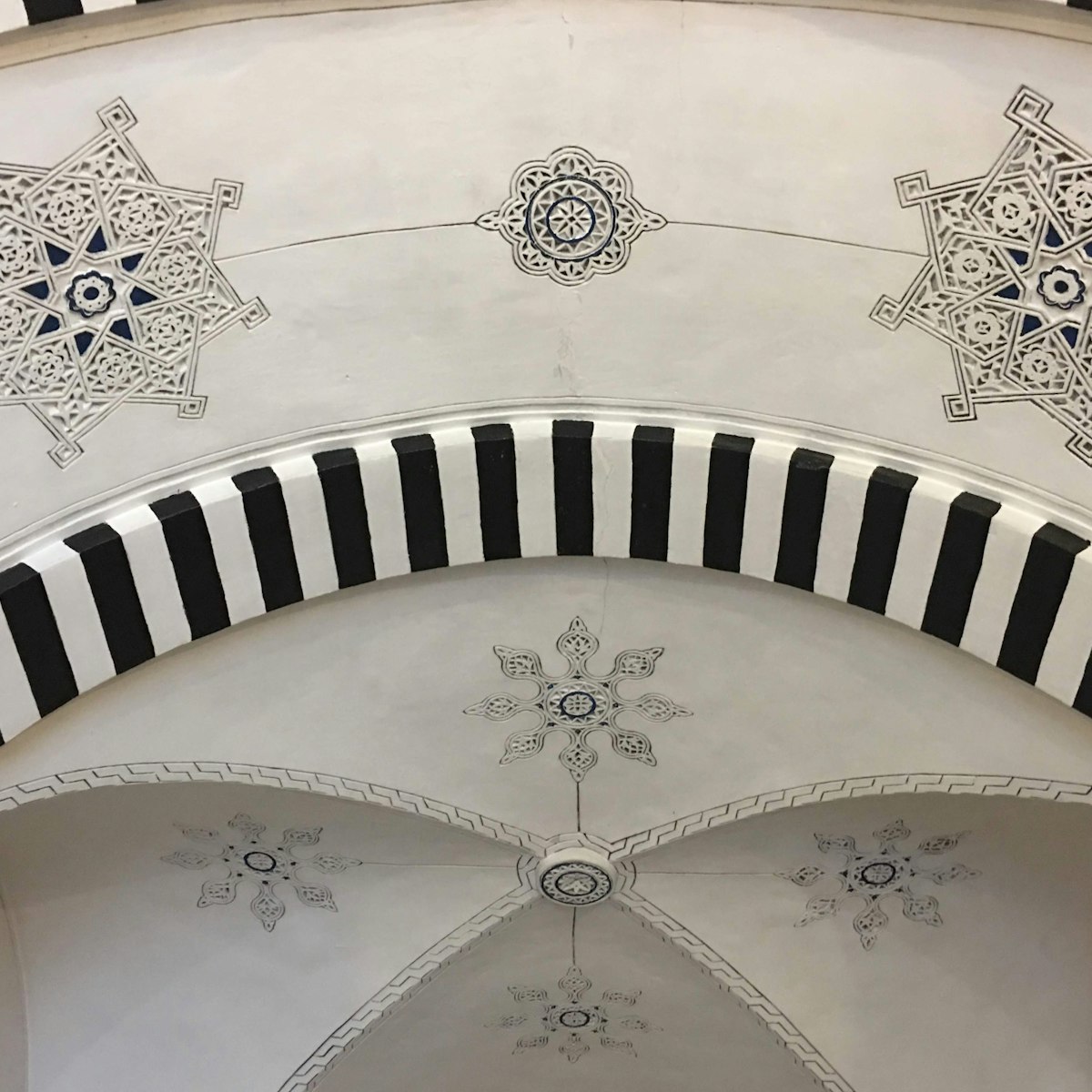
Once home to the Lasram family, who provided the beys with scribes, this magnificent building dates from the early 19th century and was one of the first…
Ichkeul National Park
Lake Ichkeul has been a Unesco World Heritage site since 1980, but it's been managed as a hunting reserve at least as far back as the 13th century. The…

La Marsa Beach
Join the local crowds flocking to this urban beach to escape the summer heat with a dip in the clear waters of the Med. In colder months, the sand becomes…
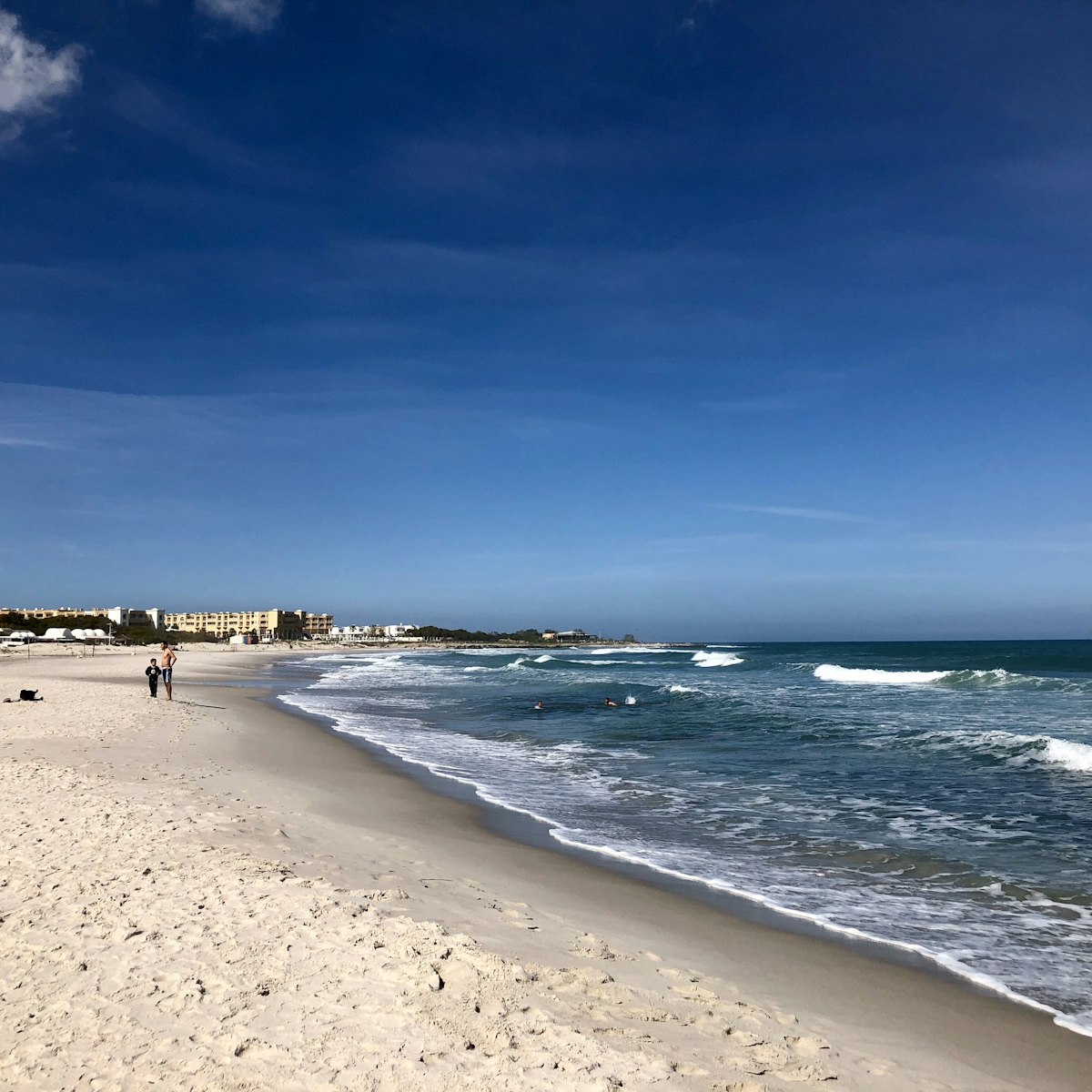
Plage de la Mansoura
Plage de la Mansoura's soft white sand tapers gently into blissfully clear-as-glass sea. This is Kelibia's favourite beach, and it gets packed at the…
Added to Unesco's World Heritage List in 1988, Sousse's 9th-century medina is an unusual and important example of Aghlabid military coastal architecture…

Zaouia of Sidi Ali Azouz
Zaghouan's architectural highlight is this tomb complex dedicated to the city patron of Tunis, which has a green fish-scale dome and, inside, superb tiled…

La Malga Cisterns
The restored and extremely impressive remnants of the huge 2nd-century-AD cisterns that housed Roman Carthage’s water supply are located at the foot of…

Galeri El Marsa
Occupying a beautiful vaulted space behind a grand wooden door in the heart of La Marsa, this is one of Tunisia’s most respected and internationally…

Souq El Attarine
Souq El Attarine (the Perfume Makers’ Souq) dates from the 13th century and is still home to shops selling fragrant oils and waters. Its location on one…
More destinations you need to see


The Perfect 14 Days Itinerary for Tunisia
Tunisia is a fantastic destination and if you’re looking for an itinerary to follow, you came to the right place!
While many visit Morocco and Egypt, somehow Tunisia remains less explored.
Hi, we’re Rach & Marty!
We’ve visited every country in the world and want to help you get the most out of your travels!
Whether you need an expertly planned itinerary , some experienced hints and tips , or just craving a delicious food adventure , we’ve got you covered!
We may earn affiliate commissions from websites we link to, at no cost to you. Click here for details.
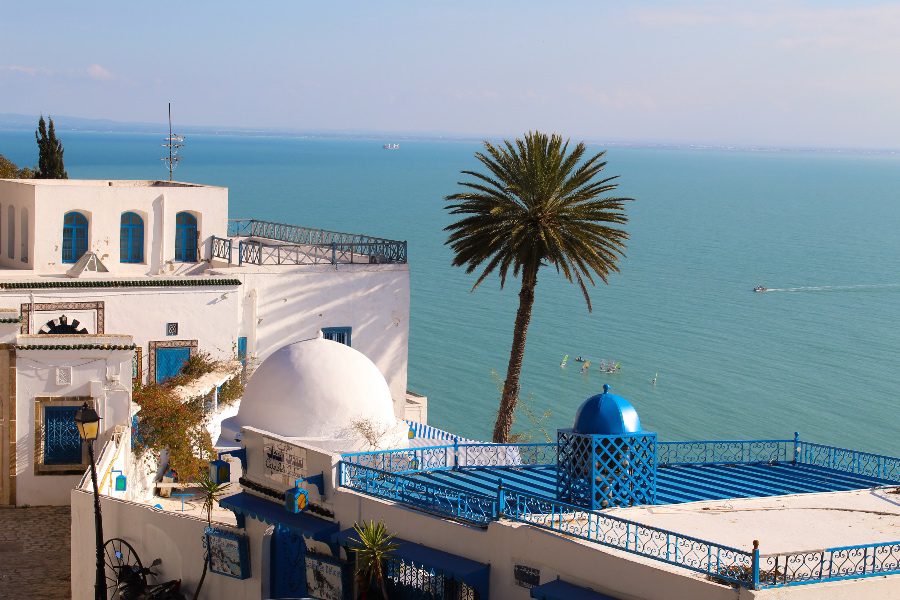
We’ve spent three weeks in Tunisia travelling independently and decided to write this perfect 14-day itinerary for Tunisia. But don’t worry, we have some suggestions if you wish to stay longer or shorter.
The country has so much to offer: gorgeous beaches, Mediterranean towns, exceptional Roman Ruins, islands, Star Wars Movie sets, the Sahara desert, great food, honest and friendly people, and great infrastructure, so getting from A to B is easy.
We travelled to Tunisia in late November and early December 2021. The prices quoted in this itinerary for Tunisia are in local currency, Tunisian Dinar (TND).
At the time 1 USD = 2.9 TND
Table of Contents
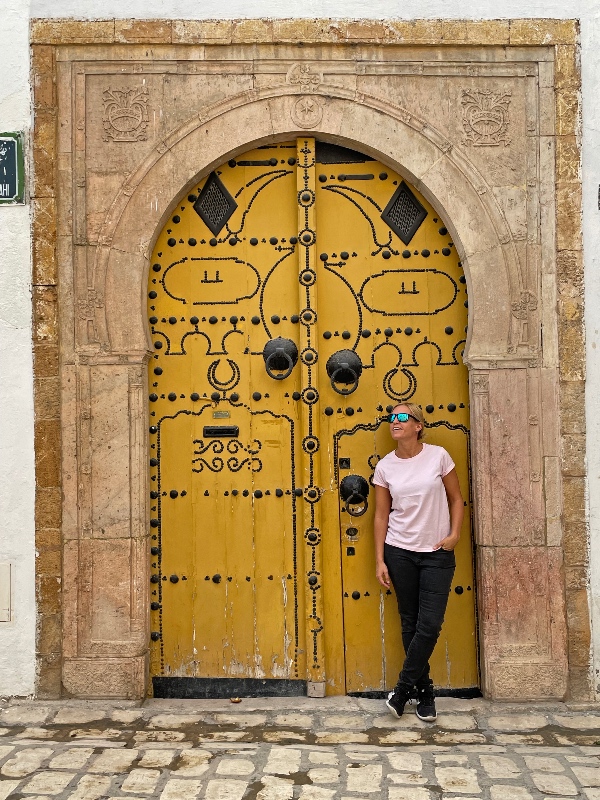
DAY 1: TUNIS
The capital city of Tunisia is a bustling city that combines modern and traditional. The best place to stay on your first visit is the medina so you can explore it. You can choose to stay in the new city at the end of your trip.
The Tunis Medina dates from the 7th century when it was built around the Zitouna Mosque.
Don’t miss the souks, especially on Friday/Saturday mornings. And, if you’re after some great views, then head up to the Cafe Panorama and enjoy a coffee or tea while you’re there.
And for a delicious lunch in the medina, stop by Restaurant The Ben Arous. You could spend a lot of time strolling through the maze of the medina with incredible doors and shops.
Read our post on the top 5 experiences of Tunis Medina.
Another highlight is the Bardo Museum, Africa’s second-biggest museum.
The museum also boasts one of the world’s most exquisite Roman mosaic collections. Definitely add this to your itinerary for Tunisia if you are an art lover. It’s closed on Monday.
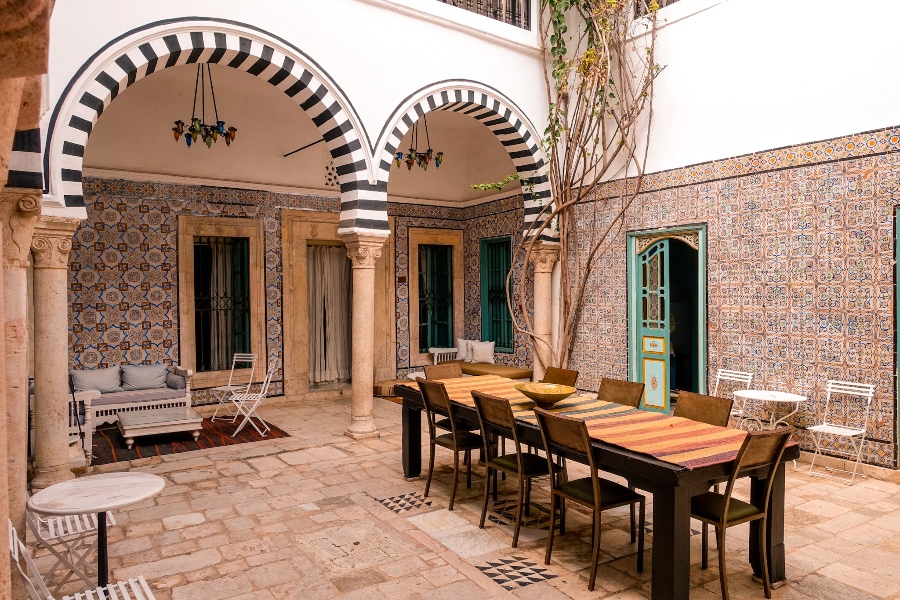
Where to stay in Tunis
Budget : Dar Ya – A great budget option in the heart of Medina. Rooms are clean and comfortable, yet only shared bathroom facilities are available. Breakfast is included in the price. The staff is very welcoming and helpful in providing local knowledge to explore Tunis and the surrounding area.
Midrange : Dar Ben Gacem – A beautifully restored old Tunisian home, now a boutique hotel. Rooms are beautiful, and an amazing breakfast is included in the rate (the best omelette and coffee in Tunisia).
The young staff is always around to help with anything you need, even if it’s just to prepare you a hot pot of tea or coffee after a long day of exploring.
Luxury: Treat yourself: Hôtel Belvédère Fourati – If you’ve got the budget that allows a swish stay in this hotel in Tunis, I recommend it.

DAY 2: TUNIS – CARTHAGE – SIDI BOU SAID
Spend the morning walking across the medina and catch the metro to Carthage (ticket is approx 0.700TND ($0.25).
This is the ancient city that once ruled a huge empire across the Mediterranean The entry ticket of 12 TND ($4.20) will get you into multiple sites.
I recommend starting at Antonine Baths and walking from there to the Roman Villas (amazing mosaics), checking out the Theatre next door, and walking up to Byrsa hill with some epic views and museums.
There are other archeological sites in Tunisia, but this one should be on anyone’s itinerary for Tunisia as it is also a UNESCO World Heritage site.
From Carthage grab a BOLT (ride-sharing app) to get to Sidi Bou Said. This picturesque seaside town is famous for its white and blue architecture (very Greece-like), make sure you explore the small side streets where you lose the crowds.
There is a famous place on the main street, Rue Hédi Zarrouk to get a hot bambalouni (Tunisian hot doughnut).
It’s a blue, hole-in-the-wall stand and you can smell sugar as you approach it. You can’t miss it.
It’s the perfect place for an afternoon stroll or stays for sunset @Cafe Des Delices.
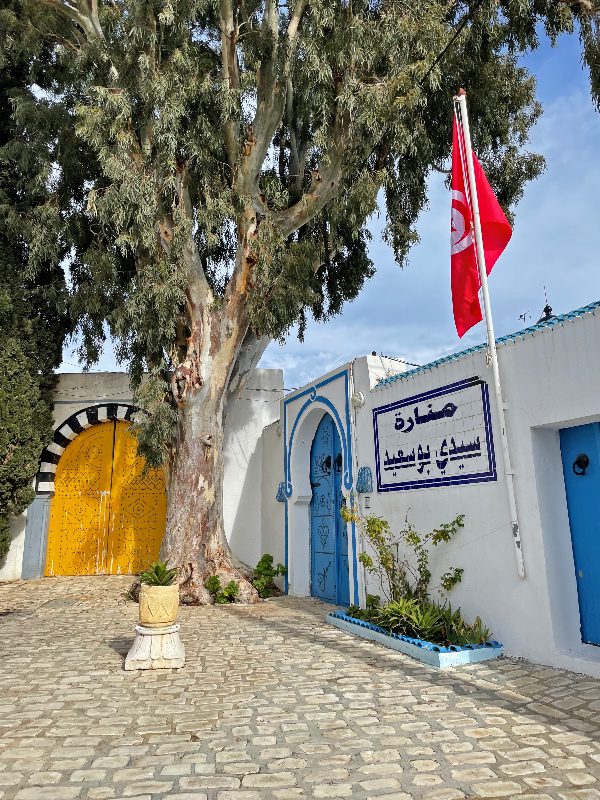
DAY 3: TUNIS TO SOUSSE
Distance: 147 km (1 hour 50 mins journey time in car)
This morning head to the Louage Station Moncef Bey to catch a louage to Sousse (11.9 TND or $4.20). This 14-day itinerary for Tunisia is based on using public transport – for us, louage was the fastest option.
LOUAGE is essentially a shared taxi, a van that fits 8 passengers, and once full it departs from the station for the destination. More about that further below.
(You could also head to Monastir directly and spend the night there at Marina Cap Appart Hotel , explore the town, and then return to Sousse the next day).
It’s only a 15 min louage ride away, a ticket is 2.25 TND and they depart regularly.
Sousse can feel pretty touristy at times but the medina is nice although it mostly feels like a market. The Ribat (fortress) is worth visiting and you can stroll down to the beach. You might choose to stay in the medina.
We stayed at Hotel Paris, a comfortable budget option located in the medina.
For breakfast get some coffee from Beanery Cafe and pastries from the amazing french bakery just around the corner (across the entrance to the Institute of Arts) and have lunch at Restaurant du Peuple – an amazing set lunch menu not to be missed.
You can also choose to stay at one of the nice resorts along the beach in Sousse. I recommend either the Sousse Pearl Marriott Resort or Mövenpick Resort & Marine Spa .
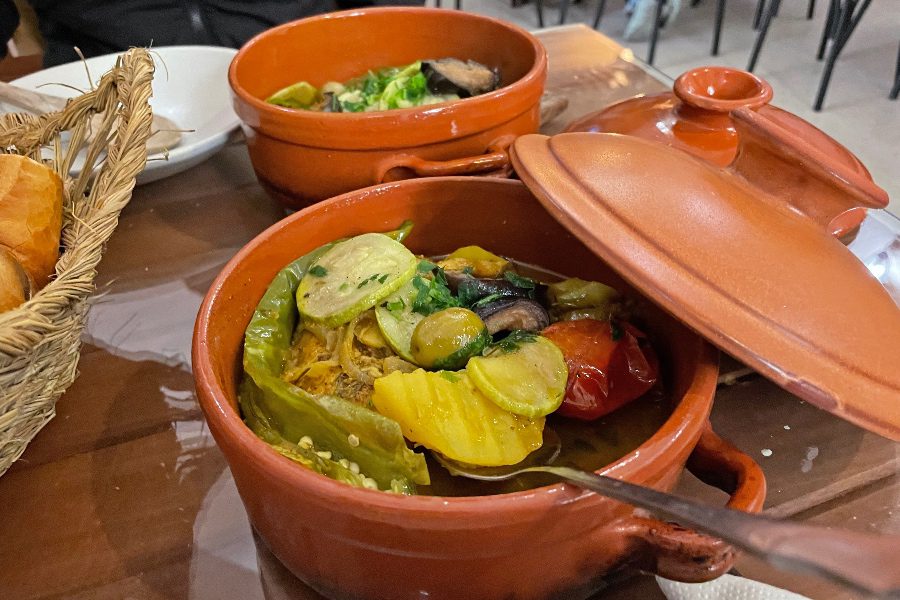
DAY 4: DAY TRIP TO MONASTIR AND EL JEM
Distance: Sousse to Monastir 22 km (25-30 mins journey time in car)
Distance: Monastir to El Jem 73km (1 hour journey time in car)
Only 30 minutes away Monastir is an easy day trip from Sousse (ticket for louage is 2.25 TND). We actually spent a few nights here as we got a great deal at the marina, staying at Marina Cap Appart Hotel. It was a nice place to chill for a few days.
You can walk from the station to the Ribat which is well restored. Across from the ribat is the Mausoleum of Habib Bourguiba containing the remains of former president Habib Bourguiba, the father of Tunisian independence and the former president.
Don’t miss the picturesque marina only a short walk from the Ribat.
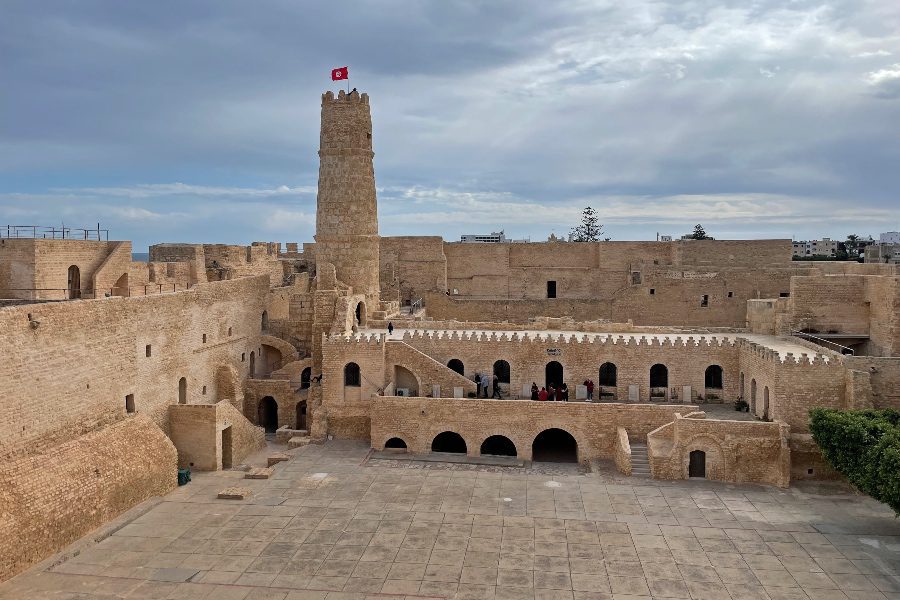
Afternoon in El Jem
Catch a louage back to Sousse and head down to El Jem. The louage ticket is 5.9 TND from Sousse to El Jem, allowing one hour journey time.
This was one of our absolute highlights of Tunisia – an ancient amphitheatre built by the Romans in 238AD. This is the largest and best-preserved Roman amphitheatre in Africa and it was designed to seat 35,000 people. This must be on anyone’s itinerary for Tunisia.
Entry is 12 TND each and be ready to be blown away!
For more detailed information and tips, read our post about how to get to El Jem in Tunisia using local transport.
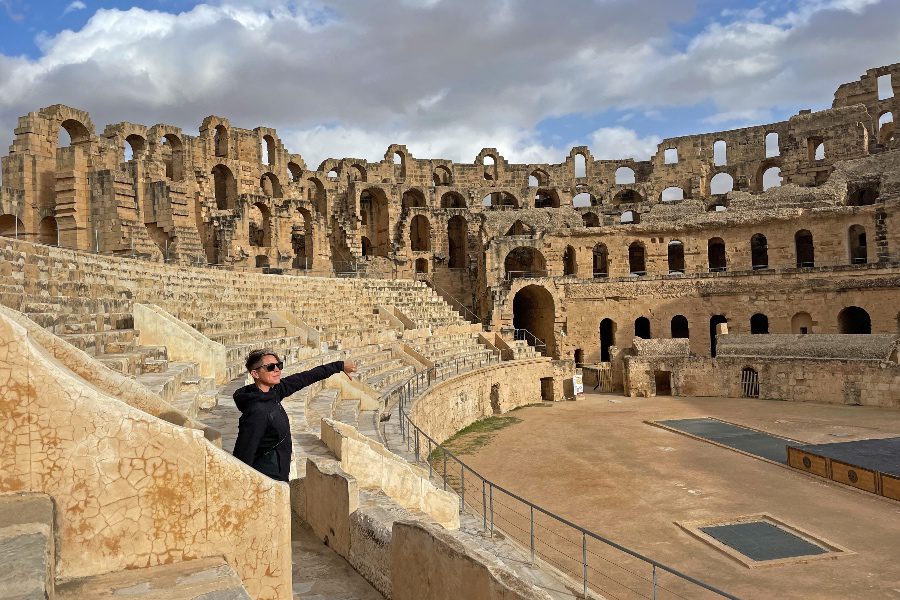
Travelling to a country with a different currency? Avoid ATM transaction fees and pay in local currency with a Wise Card . We love this card; it has saved us so much in fees.
DAY 5: SOUSSE TO TATAOUINE
Distance: 405 km (5 hours 30 mins journey time in car)
A travel day to the south. Take a louage from Sousse to Medenine first. The price is 23.5 TND ($8.20), journey time is about 5.5 hours, including two brief bathroom stops and a 25 min stop for lunch.
Change to a different louage at Medenine station heading to Tataouine. The ticket is 3.65 TND ($1.30), journey time is 45 minutes.
Don’t miss the patisseries in Tataouine that have the special: Cornes de Gazzelle (crescent-shaped cookies filled with almond filling then fried in oil and soaked in honey)
Overnight at Auberge Alferdaous , a good budget option located in the centre of Tataouine .
The owner is a great guy, has fantastic English, and can give you some good tips for exploring the area.
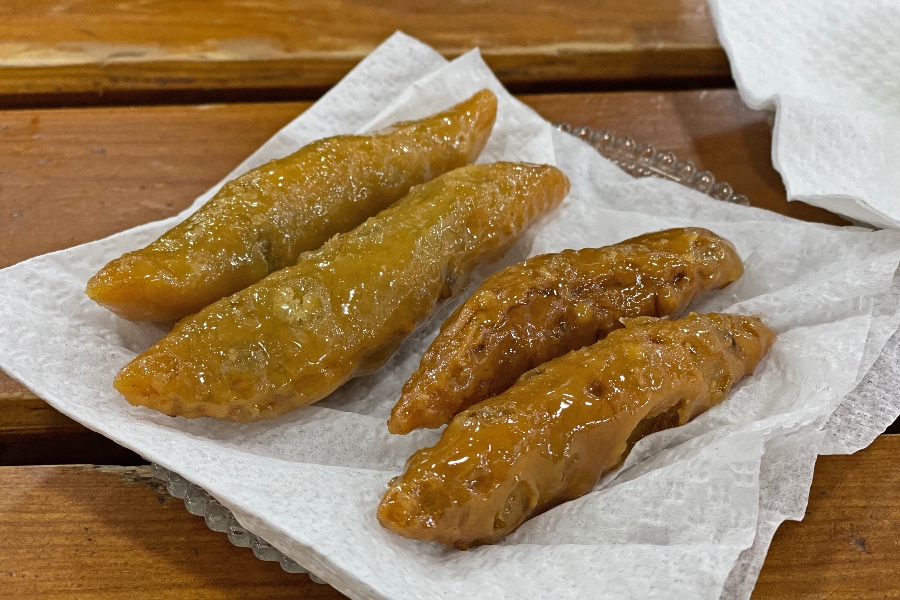
DAY 6: VISIT KSAR OULED AND MOVE TO CHENINI
Distance: Tataouine to Chenini 18 km (25 mins journey time in car)
Grab a cheap and easy breakfast in a bakery and head out (best to grab a taxi for 20 TND) to Ksar Ouled.
Alternatively, you can take louage for around 2.5 TND each, but it does take time to fill up with passengers here. However, if you have the time, it’s a cheap option.
This 15th-century granary is not to be missed. Not only because it was a set from Star Wars movies, but because it’s truly stunning.
You probably won’t need more than an hour here so it’s worth asking the taxi to wait or you can catch a louage back to Tataouine.
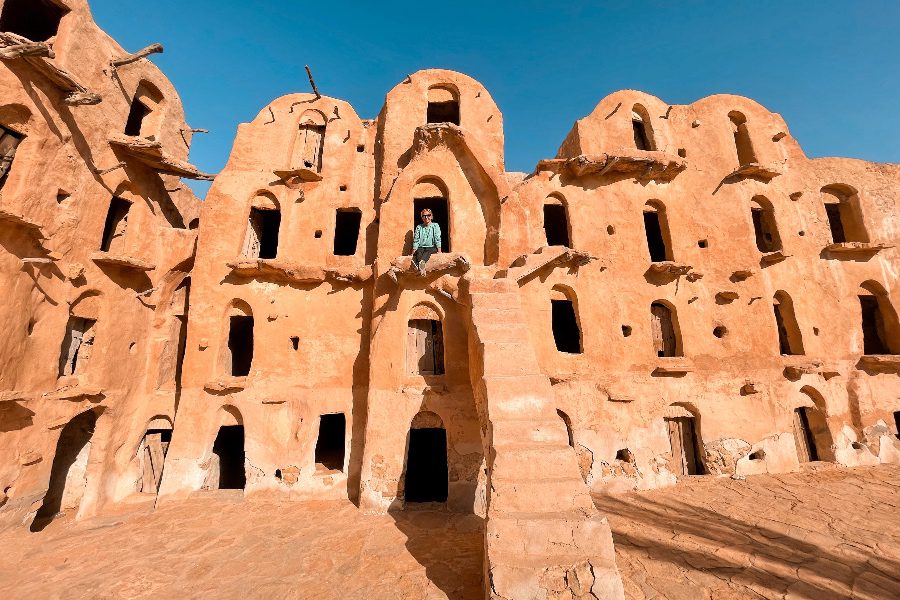
Grab lunch in Tataouine (I recommend Restaurant Sindbad for a good lunch menu) and then head out to Chenini.
It’s only about 20 minutes ride and the scenery is spectacular. We have stayed at Residence Kenza for another unique stay – in a cave. It was really cosy and had incredible views.
Chenini is a small village, part of it is an abandoned Berber stone village that you can stroll through on top of the hill.
There is a mosque on top of the hill and don’t miss the sunset or sunrise over the valley.
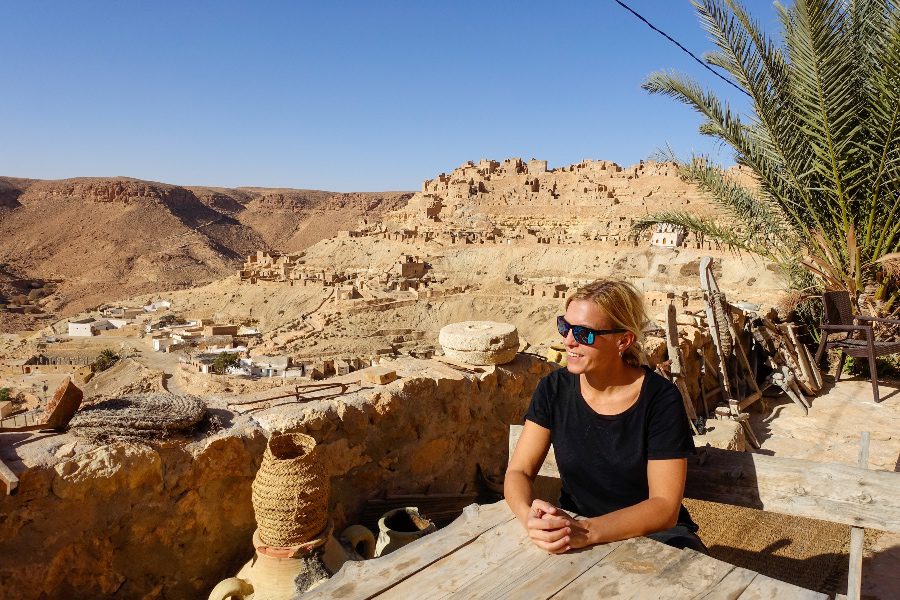
DAY 7: CHENINI TO DJERBA
Distance: 143 km (2 hours journey time in car)
Breakfast in Chenini, and then walk down the hill to catch a louage to Tataouine again. From here there are direct vans to Djerba.
The journey to Djerba was actually really quick and we had time to grab lunch once we arrived in Djerba near the louage station – Restaurant Central Djerba .
We took a taxi after a wonderful lunch of chicken and couscous (highly recommended) to our accommodation and checked in to enjoy the afternoon at leisure.
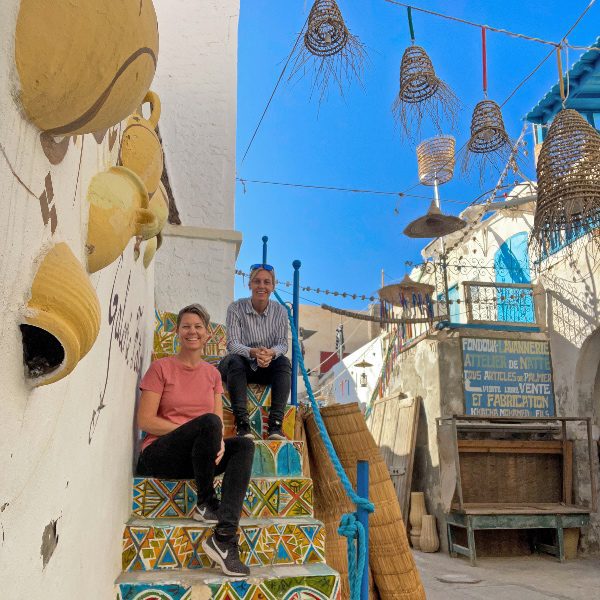
We treated ourselves in Djerba and found fantastic online rates (during late November) with Booking.com at Ulysse Palace Djerba Resort.
The resort is located approximately 9km from the centre of Djerba, however, private taxis are very affordable. We paid just a few dollars from Djerba directly to our resort (all taxis are metered).
If you’re looking for a good budget option in the heart of Djerba, I recommend Hôtel Olympic Djerba.
DAY 8: DJERBA ISLAND
Djerba is a really popular summer destination if you arrive during the summer or shoulder season.
As we visited in the cooler months, the old medina in Houmt Souk was so nice to walk around. Check out the souks, street art, maybe have a coffee in the trendy El Fondouk .
Don’t miss out on Djerbhood (street art event) and El Ghriba Synagogue.
If you have a few more days to play with, you can extend your time here.
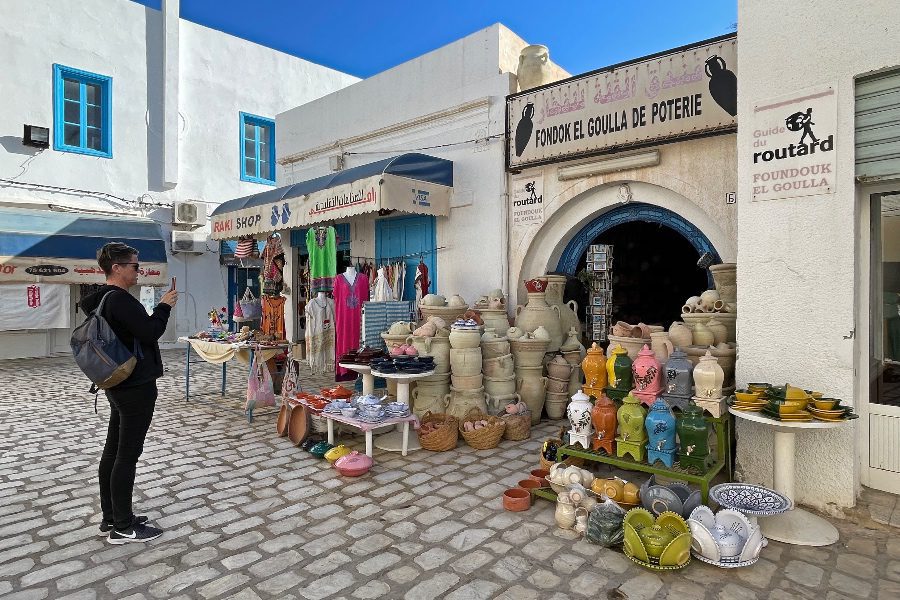
African Food Guide – 10 Best Food Countries in AFRICA
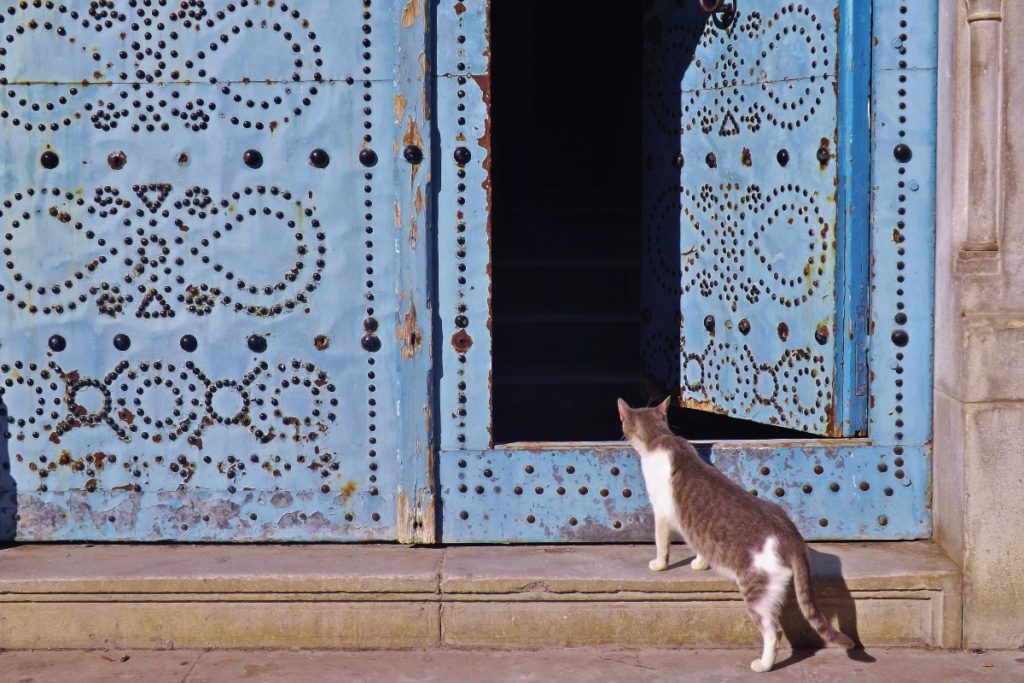
Travel in Tunisia – 10 Best Tips for Independent Travellers
Day 9: djerba to matmata (stay in star wars hotel).
Distance: 130 km (2 hours 45 mins journey time in car – allow time to change transport at stations)
From Djerba, you can head back north or if you only had 9-10 days you could simply fly out of Djerba as there are direct flights to France and Germany.
So you could alter your itinerary for Tunisia and fly from here. We always find the most competitive prices for flights using Skyscanner .
Getting north is easy. Once again catch the louage to Gabes and from there we took two vans to the small town of Matmata.
This place is known for troglodytes – houses that were built completely underground to keep cool during hot summers and warm in winter.
One of them, Hotel Sidriss has been turned into a hotel after it was used as the film set for Star Wars Episode 4 movie.
The hotel is very basic with shared bathrooms, but if you are a Star Wars fan it’s really cool to stay here. You can also just come in for a visit.
They charge 3 TND (1 euro) per person to come inside and explore.
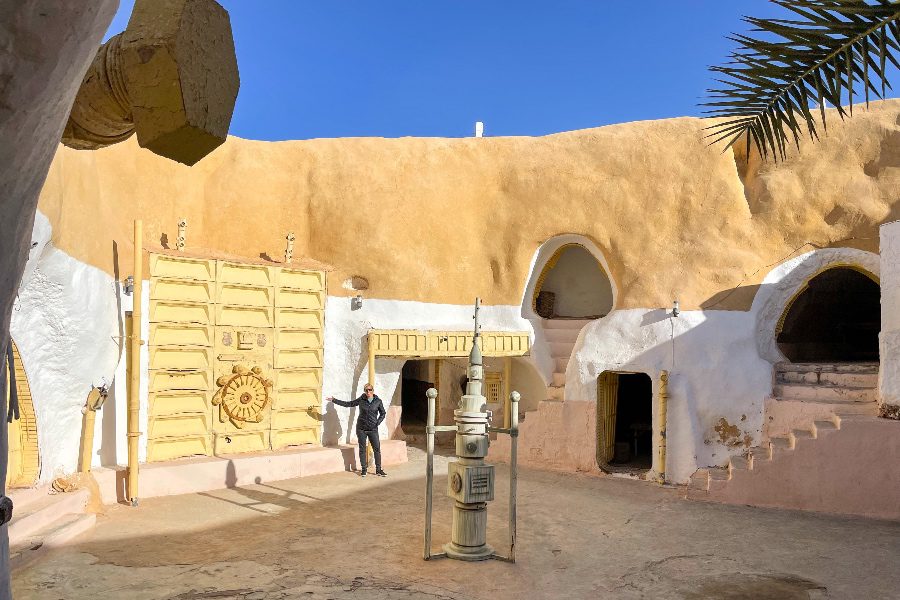
DAY 10: MATMATA TO TOZEUR
Distance: 215 km (3 hours 30 mins journey time in car – allow for time changing transport at station)
Another big day on the road, but plenty of scenery. You will need to change transport (Matmata Nouvelle a v Gabes).
Tozeur is a town surrounded by the Tunisian desert and it has a really unique feel. There are dates palms everywhere and the best dates come from here so make sure you buy some.
They’re incredibly affordable, only a couple of euros for 1kg.
The town architecture is another reason why Tozeur is so special, most buildings are decorated with small bricks, and especially the medina is a beautiful place to stroll through.
Today you should book your day trip for the next day – we booked it at the agency Au Coeur Du Desert across from our hotel, Residence El Arich .
The price quoted for a private 4WD with an English-speaking driver/guide for the day was 250 TND ($87).
The car can fit a maximum of 7 passengers, so if you have a group of people/friends to share the cost, it would considerably reduce the price per person.
We were happy to take the day trip with just the two of us and our driver/guide.
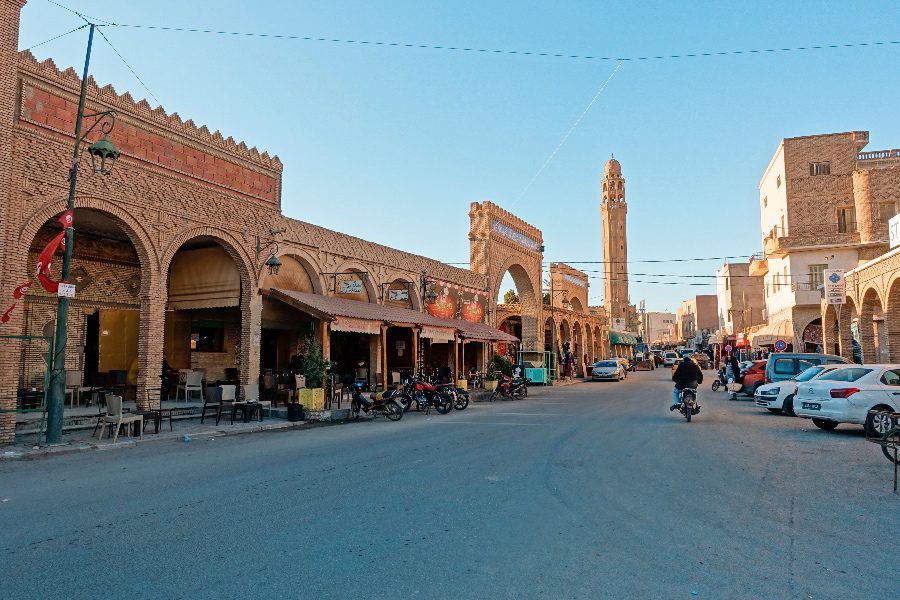
DAY 11: TOZEUR Day trip to Chebika – Tamerza – Mides – Ong Jmel
You can choose a half-day or full-day tour from Tozeur. We chose the full day one.
It included a stop at Chebika Oasis, where you visit an old village and walk down through the wadi and see the waterfall that brings life to this part of the desert.
Next is Tarmeza, another oasis village, and the gorgeous canyon at Mides. You stop for lunch and continue across the desert for some dune bashing in your 4WD to reach Mos Espa (Ong Jemel).
Travel to the Mos Espa film site, beautifully located amongst the Sahara dunes. Here, find the Pod-racing arena, the Mos Espa streets, Watto’s shop, the market, and Sebulba’s Café. Return to Tozeur at the end.
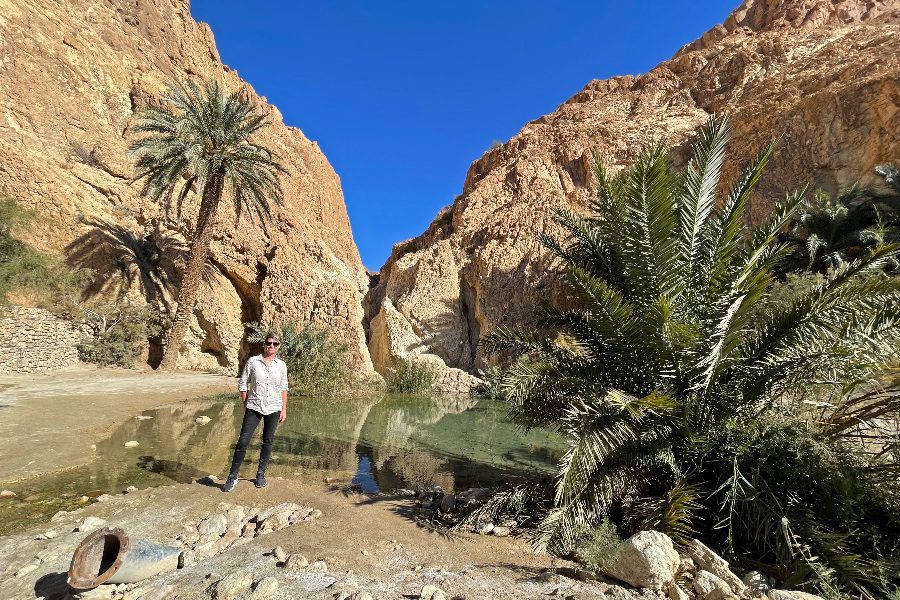
DAY 12: TOZEUR TO KAIROUAN
Distance: 295 km (4 hours 30 mins journey time in car)
Take a louage to Kairouan this morning, one of the holiest places of Islam in Tunisia and it was the first capital of the Maghreb.
A UNESCO World Heritage site, it conceals several marvels, but the medina and the Great Mosque are not to be missed.
Overnight: The budget option is to stay at Chema chaabani.
I’d recommend a very comfortable stay at Hotel Continenta l if you can afford to spend a little more.
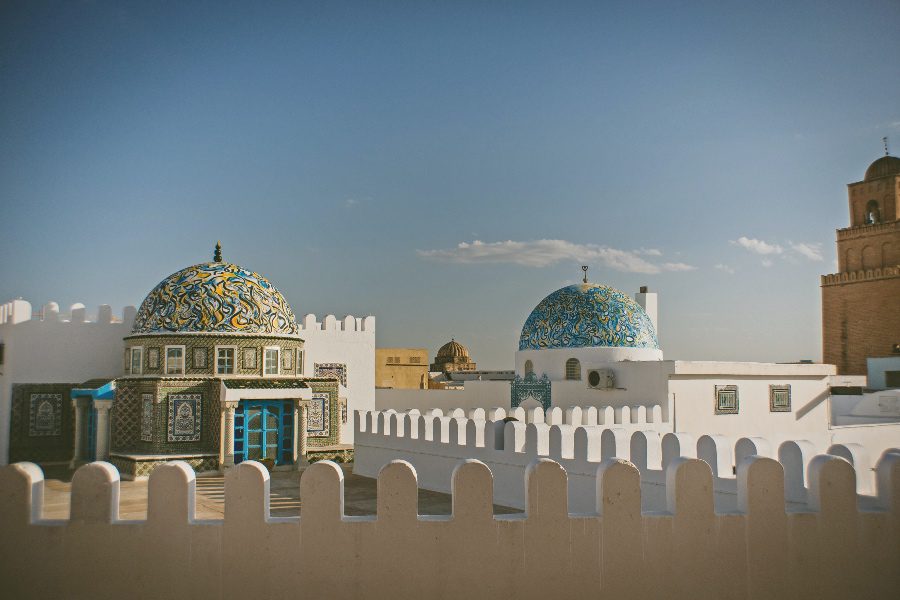
Get Connected with eSIM

Get connected easily on your travels—buy an eSIM! It works like an app: buy it, download it, and get connected in minutes! It’s easy, affordable, and convenient. Keep your original phone number, too!
Use our code: RACHEL5045 to get $3 off your first purchase!
DAY 13: KAIROUAN TO TUNIS
Distance: 165 km (2 hours 20 mins journey time in car)
Spend the morning exploring Kairouan and depart to Tunis later on. Once you arrive in the capital, you can visit the medina or head to the Bardo museum – whatever you didn’t get to do in Tunis last time.
A suggestion for a comfortable, newly renovated business hotel in central Tunis is Golf Royal Hotel .
We stayed here for our final few nights in Tunis and highly recommend it. Good prices, comfortable beds, fantastic breakfast, and great service.
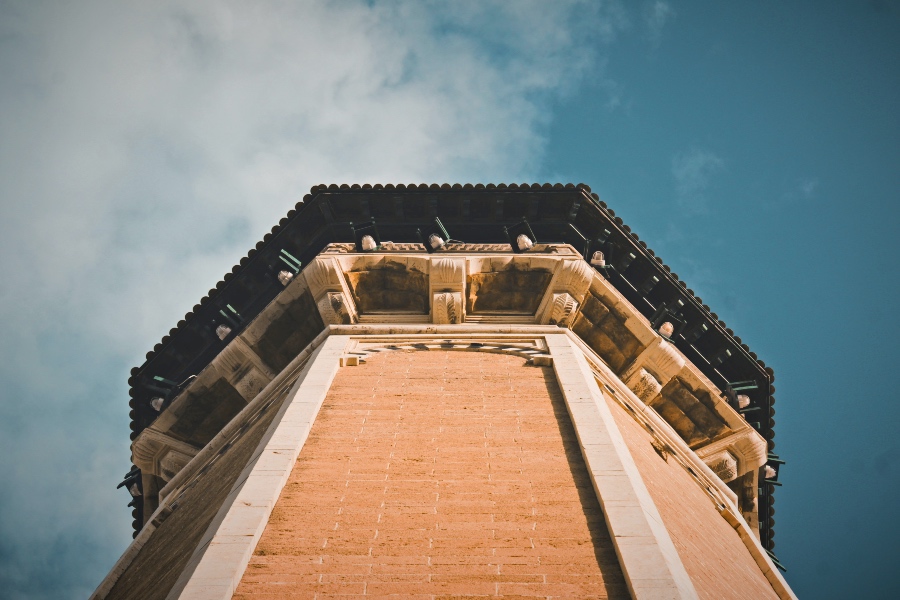
- 🔥 Hot Tip: Book accommodation on Booking.com
- 🎟 Book your tickets online: We use Viator and GetYourGuide
- 🔋 Stay charged: This Belkin Power Bank is essential!
- 📸 Join a Group Tour: Search Tourradar for Group Tours
- ✅ Get Connected with eSIM: Easy and affordable! View eSIM
DAY 14: TUNIS DEPARTURE DAY
Your itinerary for Tunisia ends in the capital. There is always plenty to do, see or eat in Tunis, depending on when your flight is.
Grab BOLT to the airport instead of a taxi, it will probably cost around 10-12 TND.
Travel Insurance for Tunisia
Make sure you get Travel Insurance before hitting the road. We recommend Heymondo & SafetyWing
Click here and get 5% off Heymondo from us!
Things to know before you travel to Tunisia
- Language: The official language is Arabic and French and English is not as common. Many people in the tourism industry speak Spanish and German as well.
- Cafes are often highly men-dominated. You can look for Salon du The for cafes that are more mixed and usually nicer.
- Food in Tunisia is amazing. Don’t miss our post about the 8 most popular Tunisian street foods to try while you’re here.
- Download the BOLT App before you arrive (or when you’re here). It will save you time and money. If your French or Arabic language skills are non-existent, this app will help you to get from A to B without any hassle.
- Always keep loose change and coins handy for paying for taxis, bottled water, or street food snacks.
- Internet connection isn’t great in Tunisia. I’d recommend picking up a SIM Card for your phone with one of the phone providers at the airport. There are several to choose from. I got an Orange SIM Card for free, then topped it up with 10GB for 20 TND (USD $7). You can get 2GB for 10 TND also, but if you’re travelling on my suggested itinerary for Tunisia, I’d recommend buying the larger package. Alternatively, the most convenient and affordable way to get connected in Tunisia is to buy this Tunisia eSIM Data Pack online.
- Keep any foreign currency receipts or ATM currency withdrawal receipts on you. At the end of your trip to Tunisia, ensure you convert all of your Tunisian Dinar to Euros/USD before you depart. Tunisian Dinars are impossible to exchange once you’ve departed the country. If you exchange currency at the airport before your departure, you may be asked for the receipt proving where you got the cash initially.
- Download Maps.me App on your phone, it’s a very useful offline map for Tunisia. I’d also recommend downloading an offline map of Tunisia on Google Maps as a backup to access maps if you cannot get online.
- Download Arabic and French in your Google Translate App. You never know when you may need to use it.
- To book any day trips or short multi-trips in Tunisia, we recommend Viator .
Travel Tips for Tunisia
We wrote helpful travel guides and tips for Tunisia—this country is so diverse!
When planning your trip, we recommend you read our 10 best tips for independent travellers to Tunisia . This post includes essential things to know that will make your travels here much smoother.
Our perfect 14-day itinerary for Tunisia is a detailed guide to visiting the best parts of the country.
We wrote this comprehensive post about how to visit El Jem Amphitheatre , what an incredible site!
Our post explaining 8 of the best street eats in Tunisia cannot be missed, and we recommend these top 5 things to do in Tunis Medina .
Tunisia features on our list of the 10 best food countries in Africa , offering some of the most popular African breakfast foods .
Our Food Map of Africa is interesting because it explains what they eat in all 54 nations.
You’ll need to stay connected while travelling in Tunisia. We recommend eSIM. It’s easy, reliable and affordable. View eSIM options in Tunisia.
If your travels in Tunisia are part of a larger global adventure, then a Global eSIM may be the answer. It connects you in 124 countries , offering data-only eSIM and data/call/text eSIM . The Global eSIM has been a game-changer; we couldn’t imagine travelling without it now.
Want to travel in Tunisia with like-minded travellers? View the best deals on group adventures in Tunisia .
Check out our best-ever travel tips compiled from more than twenty years of experience.
Travel Planning Resources
✈️ Flights : We use Skyscanner to book cheap flights worldwide.
🏨 Accommodation : Booking.com is our preferred platform for booking hotels and accommodation. We use Vrbo to book apartments and long-term stays.
🏥 Travel Insurance : We recommend Heymondo ( Get 5% off Heymondo) & SafetyWing
🚌 Transportation : Trainline is the best website to reserve trains. We use Omio to book transport worldwide. For travel in Asia, we use 12Go.
🚘 Car Rental : We use DiscoverCars to book rental cars worldwide.
👫 Group Tours : G Adventures OR compare multi-day tours worldwide with Tourradar .
📸 Day Tours & Trips : GetYourGuide & Viator are the only two platforms you need.
📚 Lonely Planet: The Best Range of Travel Guides & Ebooks , and FREE Shipping! (use code RACHELDAVEY10 for a 10% discount)
🎒 Luggage : Osprey Farpoint 40L Backpack or Samsonite Luggage Range.
🛄 What to Pack: Don’t forget your Universal charger and a good power bank . To help you pack the essentials, here is our ULTIMATE Packing List for all Travellers .
🐶 Become a House Sitter: Join Trusted Housesitters and enjoy FREE accommodation worldwide. Use our invite to receive 25% off your new membership.
💰 Send Money Anywhere: WISE & Revolut are the best online accounts that let you send money, get paid, and spend money internationally. Both are so easy to use and way cheaper than any bank transfer.
📶 Stay Connected: Airalo eSIM allows you to get connected the moment you land at your destination, and you can avoid those expensive data roaming charges. We LOVE this product! Use promo code NOMAD15 for 15% off ALL eSIMs (new Airalo users only) OR use NOMAD10 for 10% off ALL eSIMs (for existing Airalo users)
✅ Check out our Travel Gear and Travel Resources for more valuable tips to save you money!
Tasty Food Adventures
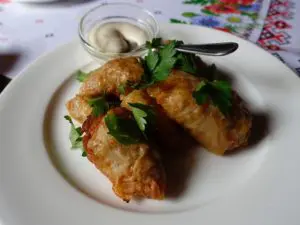
What to Eat in North Macedonia – 8 Delicious Foods
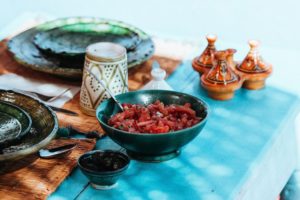
What To Eat In Marrakech (and what to avoid) 2024
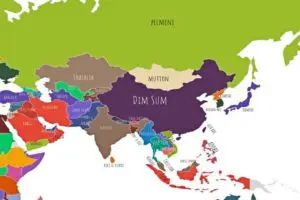
Food Map of Asia – The Best Food in Asia in 39 Countries
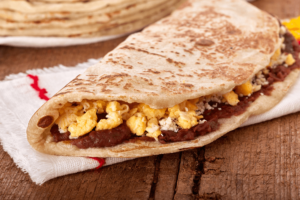
15 Most Popular Foods From Honduras
See all Food Adventure blogs
Expert Travel Guides
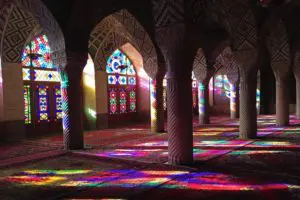
20 Inspiring Photos of Iran
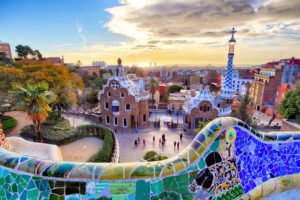
The Best City to Visit in Spain – 10 Top Rated Cities

Is it Safe to Walk around in Lagos, Nigeria
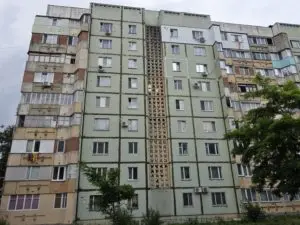
Visiting Transnistria – A Little Known Disputed Territory
See all our Travel Guides
Trusted Hints & Tips

Airalo eSIM Review – PLUS eSIM Code for Discount

How to Find and Book Cheap Flights – 8 Tips
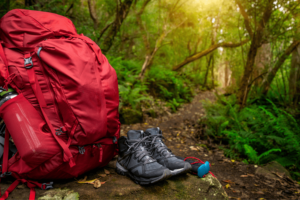
Africa Packing List: The ESSENTIAL Packing List for Africa

Teach English Overseas: Best Job to Earn Money to Travel in 2024
See all our expert Hints & Tips
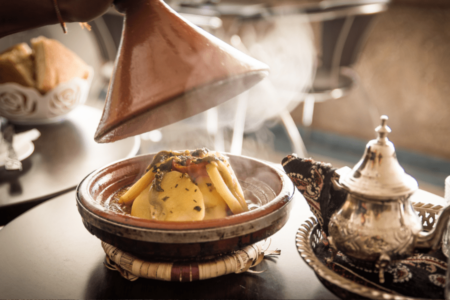
The Fascinating Medina in Tunis – 5 Unique Things To Do
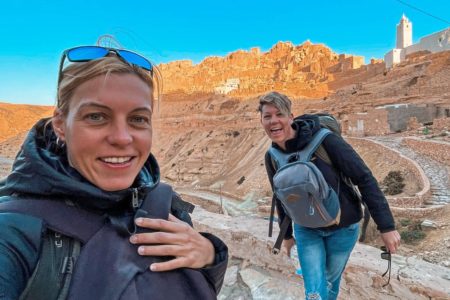
14 Comments . Leave new
thank you for sharing your trip to Tunisia it was definitely helpful.
Thank you, we’re really happy you found value in our post. Happy Travels!
Hi both I stumbled across this page while searching for info and tips on our upcoming trip to Tunisia in 2 months time This itinerary looks spot on, and touches all the things I wanted to see. We just decided to go louage rather than car rental, despite travelling with childre. One thing that I think would bring this page onto a completely new level of usefulness would be having rough estimates of times and costs involved in all the city to city trips: it’s great knowing that you can do Tozeur to Matmata (or the other way round) by louage, but it would even better to know roughly if it’s 2hr, 4hr, 6 hr, etc.. just to plan the itinerary! Anyway, thanks for all the tips and info, really great job!! Giovanni
Thanks for your feedback Giovanni, well noted. We hope you have a fantastic time in Tunisia 😉
Following up on my previous comment, can you remember how long it took you from Kairouan to Tunis (assuming by louage)? we plan to do it the other way round, but distances and times should be the same! thanks Giovanni
Yes, we took a louage taxi and the journey took about 2 hours. It was direct and they drive pretty fast on those roads.
Thanks for this info!! It was really helpful X About how much would you recommend to budget for a 9day trip (very roughly lol) ? Thanks Riya
Based on our trip, we roughly spent around 30 USD per night on accommodation (clean, comfortable rooms in good locations). Food is very affordable, so you can eat street food and great French pastries with coffee for only a dollar or two. It’s easy to find some great sit-down lunches and dinners for around $3.50 – 4.00 pp for a huge couscous with chicken/veg. Transport and getting around is affordable too, if you use Bolt app for short rides and louage (shared taxi) between cities and longer drives.
Roughly, we spent between USD $40-70 per day in total, and we’re two people. So yes, Tunisia can be a very affordable place to travel if you need to stick to a budget. Hope that helps 🙂
These two blogs I wrote below may be quite useful if you’re planning to travel to Tunisa.
– https://www.veryhungrynomads.com/10-best-tips-for-travel-in-tunisia/ – https://www.veryhungrynomads.com/street-food-tunisia-8-most-popular-eats/
Hello, thanks for your blog. I wanted yo ask you if the visits around Tozeur (oasis, canyon, mos espa) can be fone by our own means. With a normal car?
A second question is if djerba in winter for 2 days and 1 night is a place that we shall not miss. I am asking as it is relatively far.
Hi Carlos, I think you could do some self-driving in Tozeur with a normal car, but there are parts you need 4WD (I remember driving on sand when visiting oasis, the Star Wars city etc). As for Djerba, it will probably be quiet and cooler in winter, so might be worth to skip it. Hope that helps. 🙂
Hello, thanks for sharing the tips in your blog! I am travelling to Tunisia soon, and would like to ask if it’s possible to travel to Tatatouine straight after visiting El Jem? Would there be louages from Sousse to Tatatouine say 12pm onwards? By any chance do you know the opening hrs for louages?
We can’t answer for sure whether there would be louage from El Jem or Sousse to Tatouine around that time, but we imagine so. Sousse is a very busy hub or louage station for shared taxis going in all directions..and remember that the cars depart once they fill all seats. This is the primary way that all people move around in Tunisia. And, if you don’t have a car going all the way, perhaps there might be a car going to the city of Gabes, and then you could continue the next morning. Happy travels 🙂
Hello, I went through your blog and it was pretty detailed. I absolutely loved it. Just wanted to ask you if it’s possible to cover Djerba-Matmata-Tozuer in one day? Like starting from Djerba quite early, going to Matmata just to see the troglodytes up close and then head over to Tozeur for the night stay? I know it sounds very hectic, but we are very short of time. I was hoping it can be possible. We’ll not have any car with us, we are solely depending on public transport systems, preferably the louages. Thanks in advance!
Hi Shalini,
Yes, this journey would be possible – as you mentioned, you must get an early start to this day from Djerba. And, if you’re hoping to do a tour around Tozeur the following day (if you’re short on time), it may be an idea to book it online and get a confirmed trip (some suggestions in our blog to do this), or possibly call ahead and see if your hotel can arrange a guide/driver for you.
Happy Travels! This is such a fascinating area of Tunisia to explore 😉
Leave a Reply Cancel reply
Your email address will not be published. Required fields are marked *
Post Comment
10 of the Top Things to Do in Tunisia, North Africa
:max_bytes(150000):strip_icc():format(webp)/DSC00412-5b73daf7c9e77c0057ca2198.jpg)
Tunisia is one of the most popular tourist destinations in North Africa , and for good reason. It offers spectacular beaches for those in need of relaxation, and several diverse cities with ample opportunities for shopping and dining. Most importantly, though, Tunisia is a country steeped in history. Its UNESCO-protected archaeological sites provide an insight into periods of Roman, Arab and European rule and the treasures left behind by each civilization. Here are 10 of the top things to do in Tunisia.
Note: At the time of writing, travel warnings had been issued for parts of Tunisia affected by terrorism and political instability. Make sure to check for the latest updates before booking your vacation.
Soak Up the Atmosphere in Tunis
The capital of Tunis is the natural place to start your Tunisian adventure. Its origins pre-date the Romans, and over the centuries the city has developed its own unique blend of Arabic, African and European culture. In the French Ville Nouveau area, colonial buildings flank palm-lined avenues and sidewalk cafés serve artisan coffee and pastries. In the medina, authentic souks provide the chance to barter for Arabic crafts and fabrics. As the second-largest museum on the African continent, the Bardo Museum is a particular highlight. Housed in a 19th-century palace, it is a veritable treasure trove of Tunisian history populated by mosaics, sarcophagi and sculptures unearthed from ancient sites located across the country.
Live Like a Gladiator in El Djem
Further south, the town of El Djem gives visitors the opportunity to relive the grandeur of the Roman Empire. Today’s settlement grew up around the ruins of the Roman city of Thysdrus, once one of the most prosperous settlements in North Africa. Much of the original architecture is now lost—with the exception of the city’s mighty amphitheater . Built to house gladiator shows and chariot races, the amphitheater held 35,000 spectators and was one of the largest in the Empire. Now a UNESCO World Heritage Site, the amphitheater is more intact than the Coliseum in Rome, with two thirds of its triple-arcaded outer walls still standing. Visitors can also see the underground passages and cells that once held the arena’s human and animal combatants.
Discover the Grand Erg Oriental Dunes
Tunisia’s natural beauty is just as impressive as its storied past. Those wishing to experience the rugged splendor of the Sahara Desert should head for Grand Erg Oriental , a vast dune sea that stretches for approximately 370 miles/600 kilometers between Algeria and Tunisia. The region can be explored on camelback or via a 4x4 safari, with trips lasting anywhere from a few hours to several days. Camping trips are especially rewarding, giving visitors the chance to marvel at unspoiled starscapes and to witness the magnificent colors of sunrise and sunset in the desert. Grand Erg Oriental is famous for its rolling dunes, but in between the endless peaks and valleys of sand one can also find verdant oases, rocky mountains and unexpected wildlife.
Explore Islamic History in Kairouan
The centre of Islamic history in Tunisia is Kairouan , a city in the country’s northern inland region. Founded in 670 AD, Kairouan became the principal holy city of the Maghreb region under the Aghlabid dynasty in the 9th century. Today, it is the fourth holiest city of the Muslim faith, and recognized by UNESCO as a crucial stronghold of Arabo-Muslim culture. For visitors, the most rewarding area of Kairouan is the medina. Here, ancient ramparts protect a veritable maze of narrow, winding streets lined with painted houses and bustling souks. Every now and then, the alleyways lead to incredible Islamic monuments ranging from stucco and mosaic-adorned tombs to ornate mosques, the most famous of which is the 7th-century Great Mosque .
Relax by the Sea in Sidi Bou Said
Located just 12 miles/20 kilometers north of Tunis, the seaside town of Sidi Bou Said was founded to accommodate pilgrims paying homage to the nearby tomb of a Muslim saint. Today, the town is a popular getaway destination for visitors to the capital, offering the chance to unwind overlooking beautiful views of the Gulf of Tunis. Sidi Bou Said is famous for its Greek-style white buildings and distinctive blue-painted doors and trellises. This out-of-place architecture was inspired by Baron Rodolphe d’Erlanger, a French painter and musicologist who settled in Sidi Bou Said in the early 1900s and decorated his palace in the trendsetting white-and-blue style. Visitors can explore the Baron’s magnificent residence before exploring the quaint old town.
Visit the Ancient City of Carthage
Now a suburb of Tunis, the ancient city of Carthage was founded in the 9th century BC. It was the capital of the Carthaginian civilization, which posed the only real threat to the early Roman Empire, launching a series of offensives against Rome itself between 264 BC and 146 BC. The last of the Punic Wars saw the destruction of Carthage, which was later rebuilt by the Romans. Although it is not Tunisia’s most impressive archaeological site, it is certainly the most famous. A wander through the suburb reveals the remains of Carthage’s amphitheater, circus, cemeteries and Punic ports, as well as the foundations of the city’s ancient residential quarter. The Baths of Antoninus Pius are particularly famous as the largest public baths outside of Rome.
Admire Mosaics in Bulla Regia
For a more intact insight into Roman life in North Africa, make your way to Bulla Regia , an archaeological site located near the city of Jendouba in the northwest of the country. Under Roman rule, the region flourished because of its ability to produce grain, grapes and olives. This prosperity is evident in the villas at Bulla Regia, which were built underground as a defense against the heat. As a result, their interiors are so well preserved that visitors can walk through the rooms as their owners might once have done and see original artifacts in situ. These include elaborate floor mosaics, which are thought to be amongst the most impressive in North Africa. The haloed sea goddess depicted in the House of Amphitrite is a particular highlight of this incredible site.
Enjoy Djerba's Island Vibes
For a completely different atmosphere, exchange the history of the mainland for the laid-back vibes of Djerba Island . Surrounded by the Gulf of Gabès, Djerba is the largest island in North Africa. Its multicultural residents are famously friendly, and the island itself is a kaleidoscope of whitewashed buildings, sandy beaches and colorful seafood restaurants. Some visitors spend their time relaxing in luxury hotels along the Zone Touristique beachfront, while others venture into the Houmt Souk medina in search of authentic souvenirs. Guellala village is famous for its pottery, an industry that dates back to Roman times. Animal lovers can come face-to-face with over 400 Nile crocodiles at Djerba Explore , or admire wild flamingos on the Ras Rmel peninsula.
Go Birdwatching in Ichkeul National Park
Tunisia’s most rewarding wildlife experience, however, is to be found at Ichkeul National Park in the far north of the country. Comprising mountains, wetlands and the vast expanse of Lake Ichkeul, the park is UNESCO-protected and renowned for its hiking and birdwatching opportunities. The lake is the last great freshwater lake in a chain that once stretched across North Africa, and as such provides a vital stopping off point for migratory birds en route from Europe and Asia to sub-Saharan Africa. In season, more than 300,000 ducks, geese and coots can be spotted on the lake during a single day, and great flocks of storks and flamingo are common. In addition, the national park also provides a sanctuary for more than 200 animal species and 500 plant species.
Feel the Force in Matmata
Despite its allegedly ancient origins, the troglodyte settlement of Matmata was virtually unknown to the outside world until 1967, when extreme floods forced its people to surface from their underground homes. Now, the settlement is a famous destination for Star Wars fans , as the village and its surrounds were used to film scenes from the planet Tatooine. In particular, underground Hotel Sidi Driss acted as Luke Skywalker’s home in the 1977 film Star Wars: Episode IV - A New Hope ; and appeared again in the 2002 sequel Star Wars: Episode II - Attack of the Clones . Like all troglodyte homes, it comprises a series of artificial caves cut into the earth around a central pit and connected by subterranean tunnels. It has 20 rooms and a restaurant on-site.
Tunisia Travel Guide: Essential Facts and Information
The 18 Top Things to Do in Meknes, Morocco
Top 10 Destinations in North Africa
The Top 15 Things to See and Do in Morocco
The 12 Best Day Trips From Cairo
Your Trip to Morocco: The Complete Guide
Tunisia Travel: Visas, Health, Transport, & More
Top 10 Things to See and Do in Marrakesh, Morocco
Roman Amphitheaters in Italy
Sidi Bou Said, Tunisia: The Complete Guide
Medina of Tunis
10 of the Best Places to Visit in Morocco
Visiting the Star Wars Sets of Southern Tunisia
The 25 Top Attractions in Rome, Italy
The 12 Best Things to Do in Casablanca
The Top 12 Things to Do in Ethiopia

Map And Camera

11 Must-See Amazing Places To Visit In Tunisia
From the winding streets of the Tunis Medina to the dunes of the Sahara Desert, discover the best places to visit in Tunisia. The country fascinated me with its rich history, natural wonders, and vibrant blend of Mediterranean and Arab cultures.
Map And Camera contains affiliate links. If you make a purchase using one of the links below, I may receive compensation at no extra cost to you. I only recommend products and services I use and trust. Using these links will cost you nothing, but will help me maintain this website. Thank you.
Table of Contents
What you need to know before going to Tunisia?

Where is Tunisia
Tunisia is a small country located in North Africa. It is bordered by Algeria, Libya, and the Mediterranean Sea. Tunisia is strategically positioned as a gateway between Africa and Europe. Its geographical location has played a vital role in its rich history. Phoenicians, Romans, Arabs, Ottoman Turks, and French have left their mark on this unique country.
How to Get to Tunisia
The best way to get to Tunisia is by plane. Tunisia’s main airport is the capital’s Tunis Carthage International Airport. It is well connected with many European cities. The airports of Monastir, Enfidha, and Djerba serve mainly charter flights.


Best Time to Visit
The best time to explore all the places to visit in Tunisia is during the spring (April to June) or fall (September to November), when the weather is pleasant, and temperatures are moderate. The summer months (July and August) can be extremely hot, especially in the interior of the country, while the winter months (December to February) can be mild but with occasional rain.
If you plan a beach holiday the best time to visit is between May and October when the weather is warm and sunny.
For exploring the Sahara Desert, the cooler months of October to April are preferable to avoid the intense summer heat.
Meanwhile, the spring and fall seasons are ideal for cultural tours and sightseeing, as temperatures are moderate and the landscapes are lush and colorful.

The official currency of Tunisia is the Tunisian Dinar (TND), subdivided into 1000(!) milims. Currency exchange services are available at the airports, major hotels, and numerous currency exchange offices throughout the country. It’s essential to be aware that it’s illegal to bring in or take out Tunisian Dinars from the country, so make sure to exchange only what you think you will spend.

Like many other countries, the safety situation in Tunisia can fluctuate depending on various factors. In recent years, Tunisia has made significant efforts to enhance security, especially in tourist areas. As a result, the popular tourist destinations in Tunisia, such as Carthage, Sidi Bou Said, and the coastal resorts, are generally safe. However, no matter where you are going to, stay updated with travel advisories, and exercise regular safety precautions.
Is Tunisia worth visiting

Tunisia is definitely worth visiting for many. It is home to several UNESCO World Heritage sites, including the ancient ruins of Carthage and medina of Tunis.
The architecture, cuisine and traditions of the country are a charming mixture of Arab, Berber, and Mediterranean influences. The beaches of Djerba are among the best places to visit in Tunisia and a perfect destination if you are looking for a relaxing holiday. On the other hand, the Sahara Desert is a photographer’s dream with its diverse landscapes raging from vast dunes to lush green oases. And if you are a Star Wars fan, you can’t miss the saga’s filming sets and locations.

Take your camera and get ready to take your most inspiring photos .
11 Top places to visit in Tunisia
sidi bou said is my number one among the places to visit in tunisia.
Sidi Bou Said is a picturesque town located on the coast of Tunisia, near the capital city of Tunis. The town is one of the best places visit in Tunisia. It is well-known for its distinctive blue and white architecture, stunning views of the Mediterranean Sea, and rich history and culture. Here are some reasons why you should visit Sidi Bou Said:
Charming Architecture

The town is famous for its Andalusian architecture, with white-washed buildings adorned with blue doors and wrought iron windows. The unique and charming aesthetic of the town makes it a popular spot for photography and exploration.
Breathtaking Views
Situated on a cliff overlooking the Mediterranean, Sidi Bou Said offers stunning panoramic views of the sea. There are numerous cafes and terraces where visitors can relax and enjoy the scenery.

Rich History and Culture
The town has a rich history, influenced by various civilizations including the Phoenicians, Romans, and Arabs. Don’t miss the Dar El Annabi Museum, which is a traditional Tunisian house that has been turned into a museum.
Artistic Feel

Sidi Bou Said has long been a source of inspiration for artists, writers, and musicians. The town’s beauty and tranquility have attracted many creative minds over the years. You can buy there traditional Tunisian handicrafts, such as pottery, textiles, and metalwork. Sidi Bou Said will provide you with a great opportunity to purchase unique souvenirs to take home and to support local artisans at the same time.
Sidi Bou Said is located just a short tram or car ride away from Tunis and the ancient ruins of Carthage, making it easy to combine a visit to these attractions.
Compared to the hustle and bustle of Tunis, Sidi Bou Said offers a tranquil and relaxing atmosphere, making it a perfect destination for unwinding.
Photo tip : Get lost in the winding streets of Sidi Bou Said and you will encounter numerous photo opportunities.
Medina of Tunis
The Medina of Tunis is the historical heart of Tunis, the capital of Tunisia. It’s a UNESCO World Heritage site and offers a rich mixture of history, architecture, culture, and art.

The Medina dates back to the 7th century and has seen Phoenician, Roman, Byzantine, Arab, Ottoman, and French influences. The area is filled with palaces, mosques, mausoleums, madrasas, fountains, and, of course, shops. Wandering through the Medina will give you an intimate look at Tunisian life – from artisans practicing age-old crafts to bustling souks selling spices, textiles, and handicrafts.
The Medina of Tunis is a real treasure if you are looking for authentic crafts, souvenirs, jewelry, and traditional items.
Traveler’s tip : Mild temperatures in spring (March to May) make it a pleasant time to explore without the heat of the summer months, and there are fewer tourists compared to the peak season. Autumn (September to November) is a lovely time to visit too as the temperatures are moderate, and pleasant for a walk. Avoid Summer. The months of June to August can be intensely hot, which might be uncomfortable for those unaccustomed to such heat.

The Bardo National Museum
The Bardo National Museum, located in Tunis, is absolute must-see of the places to visit in Tunisia if you are interested in history, archaeology, and art. The Museum houses one of the most important collections of Roman mosaics in the world. These intricate mosaics, which have been exceptionally preserved, depict daily life, mythology, and various other themes from the ancient world. Besides mosaics, the museum contains a wide range of artifacts from the Punic, Roman, Byzantine, and Islamic periods.
Both the Bardo Museum and the Zeugma Mosaic Museum in Turkey claim to be the largest and the most important mosaic museum in the world. I could not take sides in this argument. I found both museums to be wonderful and unmissable.
During my last visit, at the end of 2022, the Bardo Museum was temporarily closed. At the time of writing this article, the Bardo Museum seems to be open to the public. However, opening times and days might be affected by events, maintenance, or external factors like global health concerns.
Tip : Before planning a visit, it’s always a good idea to check the Museum’s Official Website . You will find there the most up-to-date information on hours of operation, any special events, or potential closures.
Ancient City of Carthage – archaeology lovers must-see of all the places to visit in Tunisia

Carthage, located on the Mediterranean coast, was a significant ancient city-state that played a central role in numerous historical events. The Punic ports of Carthage were vital to its maritime power and commercial strength, enabling the city to establish and maintain a dominant position in the region for centuries. These ports served as the hub for trade, naval expeditions, and interactions with various cultures around the Mediterranean.
Carthage was a major power in the ancient Mediterranean, rivaling Rome for dominance. The Punic Wars fought between Carthage and Rome, were pivotal in shaping the course of Western history. The site contains remnants of the Carthaginians’ advanced architectural prowess, including homes, public buildings, and sacred spaces.

Situated on a hill overlooking the Mediterranean, the panorama from Carthage is simply breathtaking.
No matter whether you are a history enthusiast, or a traveler seeking a unique cultural experience, you can’t miss the Ancient City of Carthage.
El Jem (or El Djem) of all the places to visit in Tunisia should be in every history buff’s list
The Amphitheater of El Jem, located in eastern Tunisia, is one of the most renowned and impressive archaeological sites in North Africa.

El Jem Amphitheater (also known as the El Jem Colosseum) is a UNESCO World Heritage site. It is the third-largest Roman amphitheater in the world and is one of the best-preserved examples of Roman architecture outside of Italy. It once could hold 35,000 spectators.
The amphitheater’s massive structure, consisting of huge stones without mortar, is a testament to Roman engineering. Its walls stand at a towering height, and its elliptical shape is grand and imposing.

A short distance from the amphitheater is the El Jem Archaeological Museum. It houses a rich collection of Roman mosaics and artifacts discovered in the area. The mosaics give insights into daily life, mythology, and the diverse artistry of the time.
Photo tip : Given its rich history and well-preserved ruins, El Jem is a haven for photography enthusiasts. Capture the grandeur of the amphitheater, especially during sunrise or sunset when the light casts a golden hue on the stones.
Great Mosque of Kairouan

The Great Mosque of Kairouan, also known as the Mosque of Uqba, is one of the most important and impressive Islamic monuments in North Africa and is worth visiting for so many reasons. Founded by the Arab general Uqba ibn Nafi in 670 AD, the Great Mosque of Kairouan is one of the oldest places of worship in the Islamic world. It has stood witness to the evolution of Islamic architecture over the centuries. Some architectural elements of the mosque, such as its vast colonnaded prayer hall and horseshoe arches, were pioneering in their times and inspired subsequent mosque designs in the region.

The mosque showcases the finest examples of Aghlabid architecture with its massive pillars, grand courtyard, and intricate decorations. Its minaret is considered one of the purest examples of architectural simplicity and beauty in Islamic culture.

Kairouan itself is a beautiful city, considered the fourth holiest city in Islam, after Mecca, Medina, and Jerusalem. The mosque plays a significant role in this regard, symbolizing the spread of Islam in North Africa. The historic city of Kairouan, with the Great Mosque at its heart, has been designated a UNESCO World Heritage site due to its outstanding universal value.

Photo tip : If you’d like to capture the view from the above picture, here is how to do it. There is a carpet shop (at the picture below) beside the mosque. They will gladly let you go to their rooftop terrace for a stunning view. Even if you are not into buying carpets, they sell some cosmetics on the first floor, so you may consider buying a cosmetic item as a small thank you gesture.

Sahara Desert

The Sahara Desert in Tunisia is a captivating and unique destination that will offer you the chance to experience one of the world’s most iconic landscapes. Here’s why the Sahara Desert in Tunisia is worth visiting and some of the activities you can indulge in:
Admire the landscape and take the most stunning photos. The desert offers unparalleled photo opportunities, from the vast dunes to a salt flat. The vast expanses of golden sand dunes are an awe-inspiring sight, and Chott el Jerid is the largest salt flat in the Sahara, offering shimmering mirages and otherworldly views.
Photo tip: You will have the best photo opportunities at sunrise and sunset when the play of light creates a mesmerizing effect. Plan your time well as Tunisia is near the equator and the sun goes up and down very fast and you will have no more than a few minutes to take the perfect shot.
Visit the indigenous Berber people, known for their rich culture, history, and hospitality. You can learn about their way of life, traditional music, and cuisine. They will most probably give a you treat with their specific home-made bread and honey.

Ride a camel across the dunes and get a traditional desert experience or navigate the dunes with a quad bike for an adrenaline-pumping adventure.

Pay a visit to Anakin Skywalker. The Sahara in Tunisia has been the backdrop for several iconic movies, including parts of the “Star Wars” series. You can visit some of these filming locations.

Visit the Douz International Sahara Festival. The festival takes place every year at the end of December and showcases traditional Bedouin culture, camel racing, and more.
See what an oasis looks like. The Sahara is dotted with oases like Tozeur and Chebika, which offer a stark contrast to the surrounding desert. These oases are lush, and filled with date palms havens that provide a unique experience. Buy some dates from a street vendor along the way.

Tips from my own experience : Before you embark on your journey to the Sahara Desert in Tunisia, remember to:
- Stay hydrated and protect yourself from the sun.
- Wear appropriate clothing like light, long-sleeved shirts, and hats.
- Bring essentials like sunscreen, sunglasses, and a good pair of shoes.
- Respect the local customs and traditions.
- Always use local guides when exploring to ensure safety.
Chott el Djerid
Chott el Djerid is a large salt lake in southern Tunisia. It’s one of North Africa’s most distinctive natural landmarks. On the surface, Chott el Djerid seems like a vast expanse of salt and nothingness. That’s what gives it its charm.
Depending on the time of day and the season, the lake changes in color. It can go from shimmering whites and blues to fiery reds and oranges. A photographer’s paradise!

One of the lake’s most famous features is its mirages. The heat causes light to bend, producing illusions of distant lakes, trees, or even buildings. It’s a surreal experience to witness these optical phenomena. Depending on the season, flamingos can be seen in some parts of the lake.
The region around Chott el Djerid has been inhabited for thousands of years. It has played an essential role in ancient trade routes. Visit the surrounding areas for deeper insights into Tunisian Berber culture. Don’t miss the opportunity to get to know their customs and the unique architecture of the desert towns.
If you, like me, are a fan of the Star Wars series, a trip to Chott el Djerid is a pilgrimage. It was used as a filming location for several scenes, most notably those of Luke Skywalker’s home planet Tatooine.
Tip : The best time to visit Chott el Djerid is during the cooler months of the year, typically between October and April. The temperatures during this period are more bearable than the scorching heat of the summer months. Also, the chances of witnessing mirages are higher in the cooler months. Remember, though, that the lake can become inaccessible after heavy rains, so it’s essential to check local conditions before planning your trip.
The small Berber town of Matmata in southern Tunisia is famous for its unique underground troglodyte structures.

The troglodyte houses are its main attraction. They are carved out of the soft rock. The underground homes were constructed to protect their inhabitants from the scorching heat of the summer and the cold of the winter. When you stand on the surface, it appears as if there’s nothing there, but upon getting closer, you’ll discover courtyards and rooms dug deep into the earth.

For the Star Wars saga fans, Matmata is a must-visit. One of the troglodyte homes was used as the exterior for Luke Skywalker’s home on the planet Tatooine.

The Berbers are the indigenous people of North Africa. In Matmata, you’ll have the opportunity to experience their traditional way of life, learn about their customs, and taste their cuisine.
The surrounding region is characterized by its moon-like landscapes, with craters, rock formations, and vast stretches of desert. The unique topography is a photographer’s dream.

If you’re planning a visit, consider hiring a local guide. They can provide you with insights into the history, culture, and traditions of Matmata. A local guide will make your visit more enriching and informative. There’s a lot to learn about the local people, their ingenious architectural solutions, and their adaptations to a harsh environment.

Mos Espa, among all the places to visit in Tunisia, is a must-see for Star Wars fans
Mos Espa, in the Star Wars universe, is a spaceport located on the desert planet of Tatooine. While Mos Espa doesn’t actually exist in reality, several sets from the Star Wars movies were constructed in the desert regions of Tunisia.

For Star Wars enthusiasts, visiting the set of Mos Espa is like stepping directly into the movies.
Some of the original Star Wars sets in Tunisia have been preserved relatively intact and will allow you to walk through and explore them.
Beyond just the sets, the surrounding desert landscape is breathtaking. The Sahara desert offers endless sand dunes. They create a serene environment and out-of-this-world feeling.
While the sets feel remote, they’re accessible with guided tours. The tours usually combine a visit to Mos Espa with an extreme buggy driving through the dunes. Though not everyone in the group I was traveling with appreciated it, I really liked it. It was a great fun!

Photo tip : The combination of the sets and the stunning desert backdrop provides fantastic opportunities for photography. Try to go there early in the morning or late in the afternoon for the best lighting conditions.
Island of Djerba, of all the places to visit in Tunisia, is beach lovers’ paradise
Djerba Island, located off the southeastern coast of Tunisia in North Africa, is a gem that offers a mix of beautiful beaches, rich history, and unique culture. Here’s why Djerba is worth visiting along with some recommendations on what to see and do:
Go for a beach holiday

Djerba boasts some of the most beautiful beaches in the Mediterranean. The soft white sands and crystal-clear waters are perfect for sunbathing, swimming, and water sports. The beaches of Djerba offer a range of water sports including jet-skiing, windsurfing, and kitesurfing.
You can even ride a camel or a horse on the beach. That was the only thing I didn’t like at Djerba. No one seems to clean the animals’ excrements, so pay attention to where you step when going to the water.
Shop at Houmt Souk

This is the main town and commercial center of Djerba. Stroll through its markets. Shop for local crafts, pottery, jewelry, or textiles. The small town also has a picturesque marina and several historical sites.
Visit one of the oldest Synagogues in the world

El Ghriba Synagogue is an important pilgrimage site for Jews. Its architecture and history make it a must-visit for everyone no matter the religion.
Explore a crocodile farm
The crocodile farm is in Djerba Explore Park. There you will find also the Lalla Hadria Museum, which showcases Tunisian art and history and a traditional Tunisian village.
Admire the street art of Djerbahood

The small village of Erriadh is an open-air museum. International artists have transformed every surface suitable for painting, into a work of art. The sleepy village has become a vibrant street art scene. Among all the beautiful places to visit on Djerba Island, this is my favorite.
Climb the Borj El K’bir Fortress

This historic fortress offers panoramic views of the coast and the marina. The fortress has a rich history and had played a significant role in defending the island from invaders.
Learn how the pottery is made

The town of Guellala is famous for its pottery. No matter where in Tunisia you see ceramics for sale, they most probably have come from Guellala. Watch artisans at work and buy some unique ceramic pieces as souvenirs.
In conclusion, Tunisia is not just a destination, it’s an experience. Its rich variety of cultures, traditions, and landscapes make it one of the top places to visit in the world. Whether you’re a history buff, an adventurer, or just someone looking to relax on pristine beaches, you will find amazing places to visit in Tunisia.
So, pack your bags and get ready to be enchanted by this North African marvel.
Find everything you might need for your travels in one place on my Travel Resources page.
You may also be interested in:
31 photos to inspire you to visit Tunisia +photo tips
Ultimate Jordan 5-day Itinerary To Visit The Highlights
Eastern Turkey Itinerary: How To Explore Upper Mesopotamia
First Time In Istanbul: 51+ Best Tips For 2024 Trip
Why Is Ateneo Grand Splendid The Most Beautiful Bookstore
11 Great Buenos Aires Attractions For Your Must-see List
9 (+2) Best Historic Bars and Cafes in Buenos Aires
Similar Posts

31 Photos Of The Best Tourist Places In Tunisia

Tunisia Travel Guide: Plan Your Perfect Trip
Written by Jess Lee Updated Sep 24, 2021
Tunisia may be mainly known as a summer sun and sea travel destination, but off the beach there is much more to discover. In the south, the Sahara's swath of desert sand scattered with lonely oases offers landscapes of rolling dunes that are ripe for adventure tourism activities, while in the north, the ruins of ancient towns sit snug within fertile hill country and are easy historic day trips from Tunis.
Tunisia's geographical situation laid it open from time immemorial to empire builders. The Roman amphitheater at El Djem is only the most famous of the country's historical sights, which take in Phoenician and Roman ruins, Roman and Byzantine mosaics, and Arab and Ottoman forts.
For those who want to explore beyond its feted beaches, Tunisia's small size makes it simple to experience a mix of culture, history, and landscapes even on a short trip.
On This Page:
Inspirational ideas for planning your trip to tunisia, best time to visit tunisia, visitors guide to tunis, best towns in tunisia, historic highlights of tunisia, essential stats & facts, first-time traveler tips for tunisia.
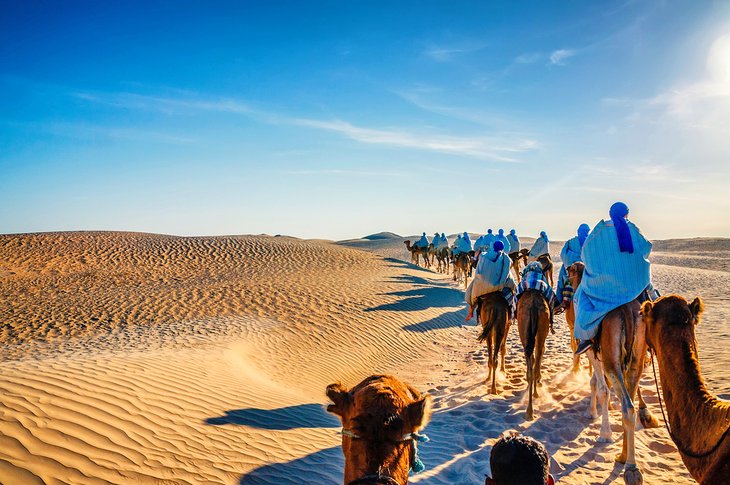
For beach vacations, head straight to the Mediterranean shore. Away from the coast, Tunisia provides plenty of adventure activities amid the vast desert landscapes of the Sahara, famous film locations for fans of movies such as the Star Wars franchise, and some of the grandest Roman ruins in north Africa.
Plan what not to miss in your holiday itinerary by checking out our overview articles on the country's highlights.
- Top-Rated Tourist Attractions in Tunisia
- Tunisia in Pictures: 15 Beautiful Places to Photograph
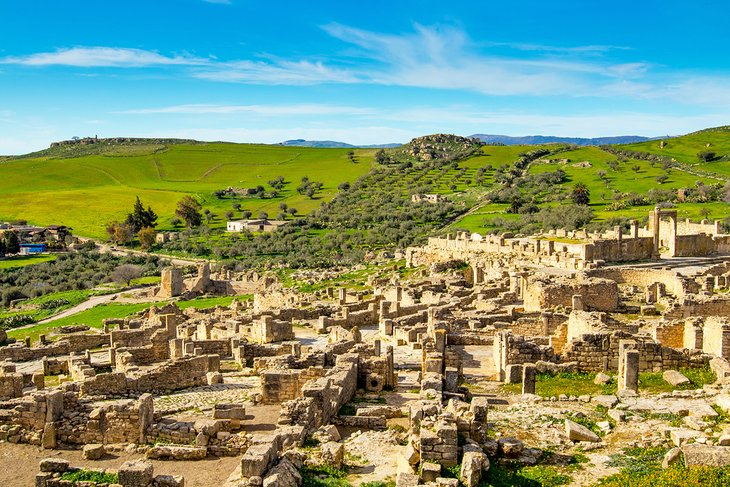
Summer: If you're traveling to Tunisia solely for the Mediterranean beaches, summer is high season, with sun and blue skies from June through August. Beach resort prices are highest during July and August. Desert trips are best avoided during this season due to rocketing temperatures.
Fall (September & October): As well as spring, fall is the best time to visit Tunisia if you want to travel around the country rather than simply bask on the beach. The weather is still mostly sunny and warm, but the high temperatures of July and August have tempered down in the south, so desert trips are back on the cards. Expect some rain in October in the north.
Winter: Tunisia's northern region and the Mediterranean coast receive most of their rain from around late October to May. It can get very chilly (including in the desert after dark), so bring warm clothing. The coastal beach resorts may be quiet, but this is a great time if you're traveling specifically for the desert.
Spring: Lots of blue skies (though expect rain along the coast and in the north) and moderate temperatures make this an excellent season for visitors who want to travel around the entire country.
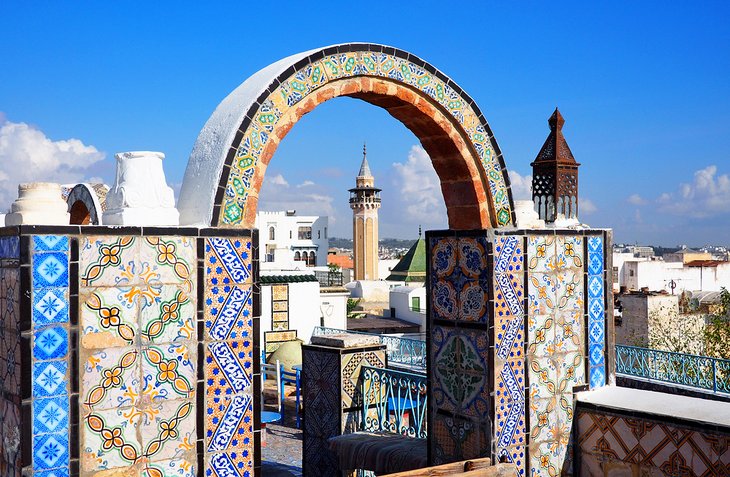
Tunisia's capital, Tunis, is a laid-back introduction to the country. Many tourists spend little time here, often only visiting as a day trip from the beach, but Tunis is the contemporary heartbeat of Tunisia and has plenty to keep visitors busy for a few days.
Spend some time exploring the wriggling alleys of the historic medina (old town), soaking up the ambience of Sidi Bou Said, admiring the world-famous mosaic collection inside the Bardo Museum, and visiting the rambling ruins of once-mighty Carthage before setting off on farther travels.
- Top-Rated Attractions & Things to Do in Tunis
- Exploring the Ruins of Ancient Carthage: A Visitor's Guide
- Exploring Sidi Bou Said: Tunis' Picturesque Seaside Suburb
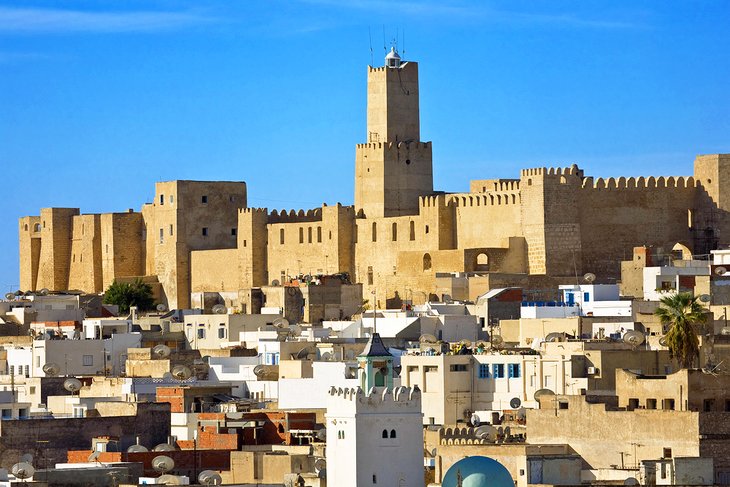
Many visitors here to soak up the sun on the beach head directly to the Mediterranean coastal towns of Hammamet and Sousse, and the island of Djerba, which are particular favorites with overseas tourists. If you're interested in history and culture, don't miss the town of Kairouan, with its labyrinthine medina, and the desert oasis town of Tozeur with its preserved brick architecture.
- Top-Rated Tourist Attractions in Hammamet
- Top-Rated Tourist Attractions in Sousse
- Top-Rated Tourist Attraction in Djerba
- Top-Rated Tourist Attractions in Kairouan
- Top-Rated Tourist Attractions in Tozeur
- Exploring Tozeur's Oasis: A Visitor's Guide
- Top-Rated Tourist Attractions in Monastir
- Top-Rated Tourist Attractions in Sfax
- Top-Rated Tourist Attractions in Mahdia
- Top-Rated Tourist Attractions in Bizerte
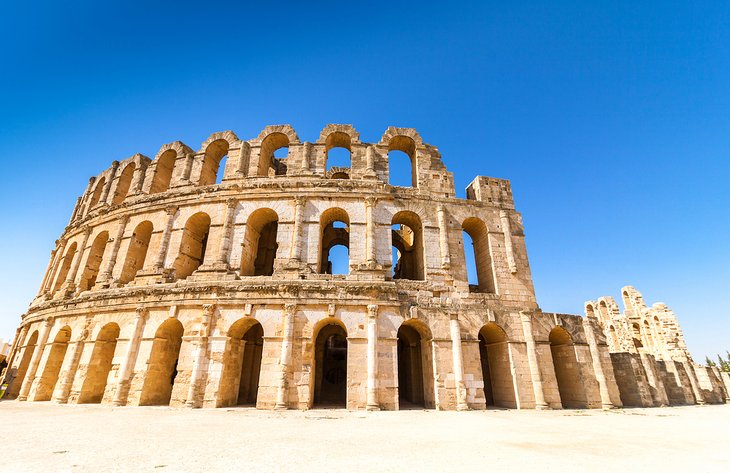
Tunisia's star historical attraction is El Djem, a massive and wonderfully preserved Roman amphitheater that was the fourth largest ever built during the Roman era. Tunisia, though, has a long and rich history, and there are plenty more historic remnants for travelers who want to delve further.
The two most impressive Roman city ruins, Dougga and Bulla Regia, are in the country's north and can be easily visited as day trips from either Tunis or Tabarka.
- Exploring El Djem: A Visitor's Guide
- Top-Rated Tourist Attractions in Tabarka
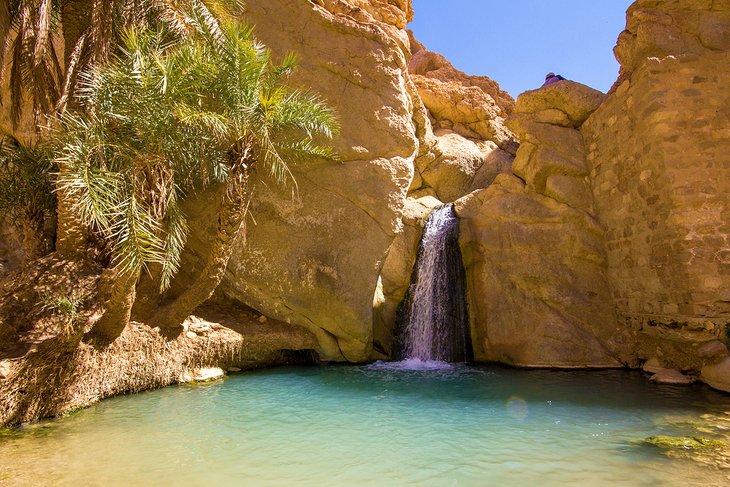
- Population of Tunisia: The population of Tunisia is 11.8 million. Nearly the entire population lives in the country's northern half and along the coast. Around 70 percent of Tunisia's population live in urban areas.
- Capital of Tunisia: The capital of Tunisia is Tunis, which has a population of two million.
- Geography of Tunisia: Tunisia is a thin country rimming the Mediterranean Sea to the north and sharing borders with Algeria to the west and Libya to the east. The northern half of the country is mountainous, while the Sahara desert covers much of Tunisia's southern half. In total, Tunisia covers an area of 163,610 square kilometers.
- Languages of Tunisia: The official language of Tunisia is Arabic. French is widely spoken in Tunisia despite having no official language status. Tamazight is also spoken by the Amazigh (Berber).
- Currency of Tunisia: The currency of Tunisia is the Tunisian dinar.
- Time Zone of Tunisia: The time zone of Tunisia is UTC + 1.
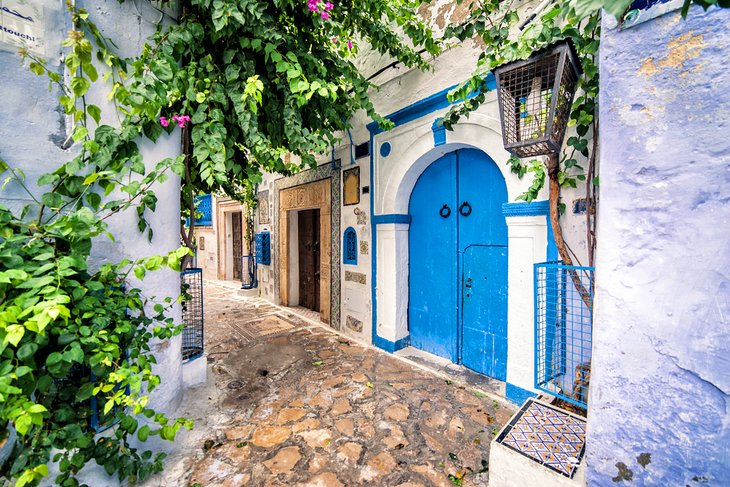
Tourist Visas for Tunisia: Passport holders of 97 countries can enter Tunisia visa-free for stays of between 30 and 90 days (depending on the country). Nationalities that require a tourist visa need to apply pre-travel at the Tunisian Embassy. An online e-visa system is currently in the works to make the tourist visa application process easier and more streamlined.
Clothing: Tunisia is an easygoing society, but off the beach and away from the tourist resorts and Tunis, travelers should err on the conservative side in their clothing, covering shoulders and knees, particularly if traveling in rural areas.
Electricity: Tunisia uses two-prong European-style plugs.
Money: Apart from large hotels, big tourist-orientated shops, and a few fine-dining restaurants, credit cards aren't widely accepted in Tunisia, so expect to pay in cash. ATMs are widely available. It is very useful to have small change for public transport, small restaurants, and shops that may not be able to break larger bills.
Mosquitos: If you are traveling to the desert oases such as Tozeur, pack some insect repellent. The mosquitos can be ferocious.
Photography: Be aware that it is illegal to photograph government and military facilities in Tunisia, and don't bring along your drone for taking spectacular aerial shots of the desert. All drone photography is illegal in Tunisia without an official permit. Always ask permission before taking photos of people.

Travel to Tunisia in 2024: Tips + Itinerary
By Joan Torres 20 Comments Last updated on April 29, 2024

From the most epic Roman ruins in Africa to crystal Mediterranean beaches, the Sahara and a great Berber culture, Tunisia is a small piece of land with a lot to offer and is a great alternative to Morocco as, basically, you get a similar Maghrebi culture with the difference that many parts of Tunisia remain unvisited and the country is mostly free of the classic scams.
The golden era in which Tunisia used to be a prime tourist destination came to an end with the 2015 terrorist attacks – unfortunately – but, even during those times, the vast majority of visitors were resort-like tourists, the most adventurous ones visiting the most typical tourist attractions on an organized tour.
Even my parents visited Tunisia for a few days many years ago, but went there with everything organized.
This means that Tunisia hasn’t really witnessed the arrival of independent travelers and I believe this is one of the things that make any trip to Tunisia a great travel experience, as you will be continuously meeting curious, kind-hearted locals everywhere you go.
No more than a few hours from any European city by air, this is perhaps, the closest and easiest exotic, offbeat destination to visit during your 1 or 2-week holiday.
This guide contains everything you need to know to travel to Tunisia , including travel tips and a compelling 2-week itinerary.
I also recommend you read: How to visit Tunis in 3 days
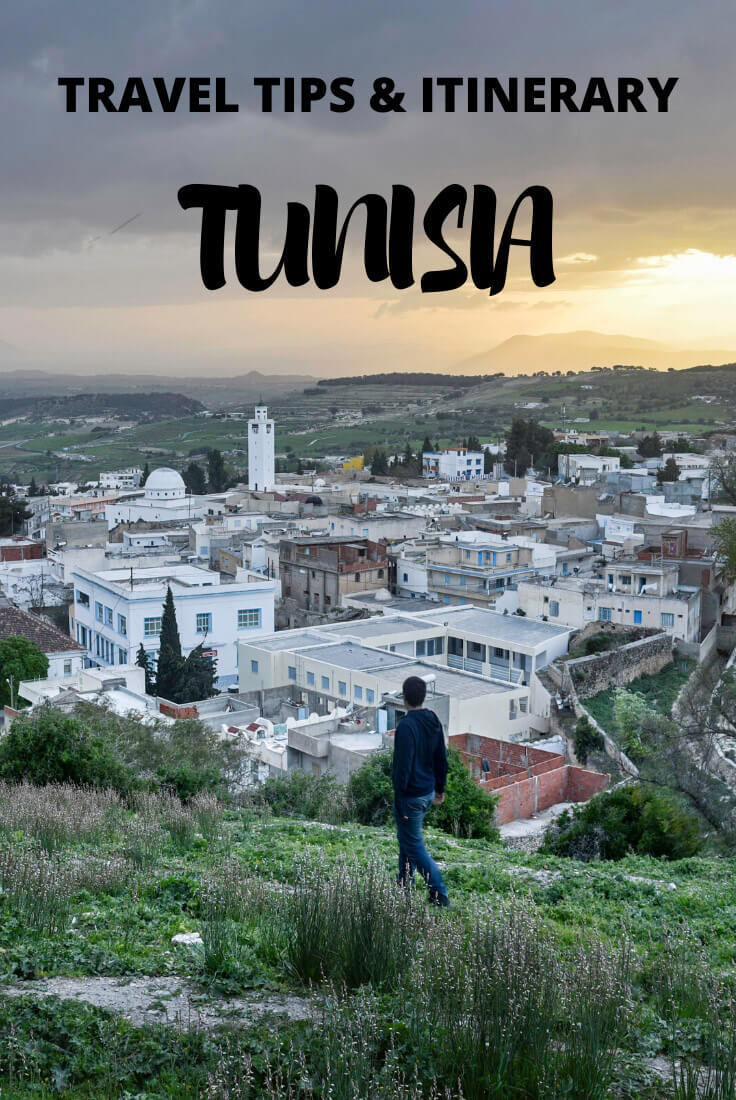
In this Tunisia travel guide you will find:
Table of Contents
- Getting there
- Travel insurance
- Best time to visit
- Tour or not?
- The people, the country
- Moving around
- Is it safe?
- Day 1, 2 – Tunis
- Day 3 – Sousse
- Day 4 – Monastir
- Day 5 – Kairouan
- Day 6 – El Jem
- Day 7 – Sfax
- Day 8, 9 – Tataouine & around
- Day 10, 11 – Tozeur & around
- Day 12 – El Kef
- Day 13 – Jugurtha Tableland
- Day 14 – Dougga
- More information
our recommended travel insurance for Tunisia
IATI Insurance is the most versatile insurance for any destination, including Tunisia.
🪪 How to get a tourist visa for Tunisia
Pretty much any nationality can get a 3-month visa-free on arrival.
🛫 How to get to Tunisia
How to travel to tunisia by air.
Tunis International Airport has connections with several European cities and other major cities in Africa. I recommend you check on Tunisair and Skyscanner. I personally flew from Barcelona with Tunisair.
How to travel to Tunisia by land
Tunisia has a border with Algeria and Libya .
- Algeria – You can travel to Tunisia from Algeria and use the entry point near Tabarka – not sure if foreigners can use the other borders.
- Libya – You can’t really cross from Libya, not because the border is closed but because, currently, Libya is not issuing tourist visas and the only way to get in is via an agency who will fake a business visa for you, and they don’t recommend you enter or exit via Tunisia, as it would not be credible that you came to Libya for business purposes.
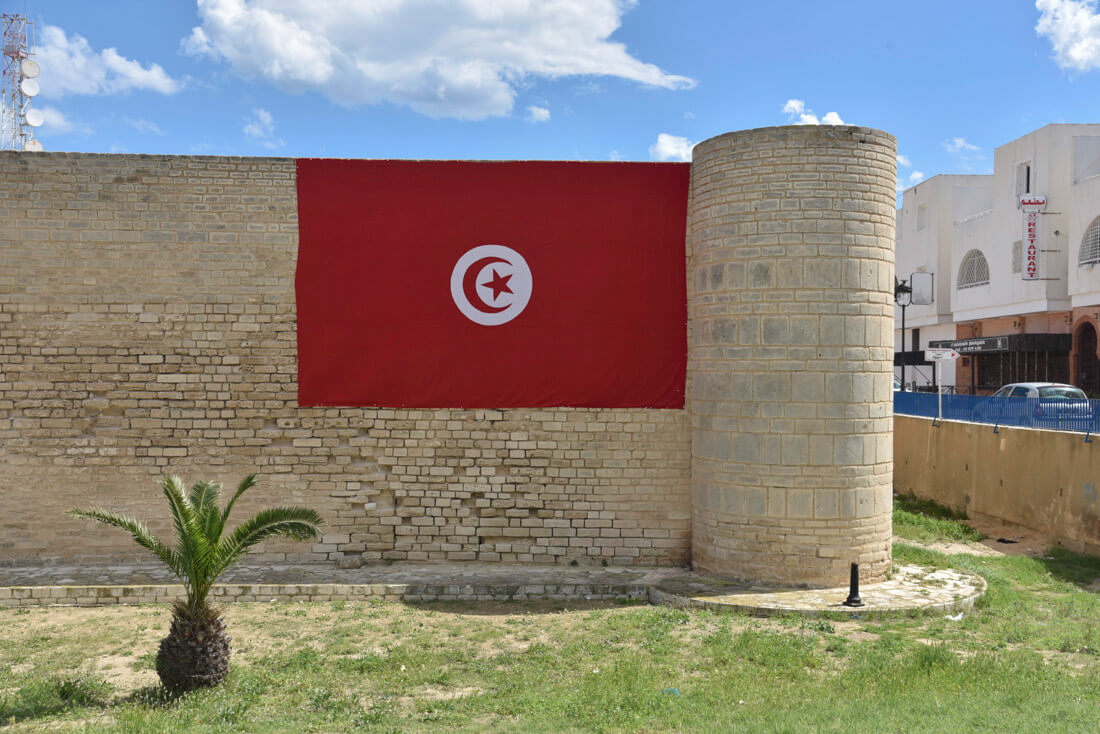
🚑 Travel Insurance for Tunisia
For Tunisia, get IATI Insurance :
- All types of plans: from families to budget backpackers
- Covers both short-term trips and up to 1-year long trips.
- Covers senior citizens too
- Readers of this blog can get a 5% exclusive discount
⛅ Best time to visit Tunisia
The best thing about Tunisia is that this is really a year-round destination.
The northern part of the country is purely Mediterranean, with mild winters and hot summers so, if you fancy the beach, July and August should prove best, and towns and cities are great to visit any time of the year. The arid south, however, is best visited in winter, otherwise, the heat might not let you enjoy it that much.
I visited Tunisia for 3 weeks from mid-April to the beginning of May and it was the perfect time. The weather in the northern part was absolutely pleasant, with a little rain sometimes, and the heat in the southern part was still quite bearable.
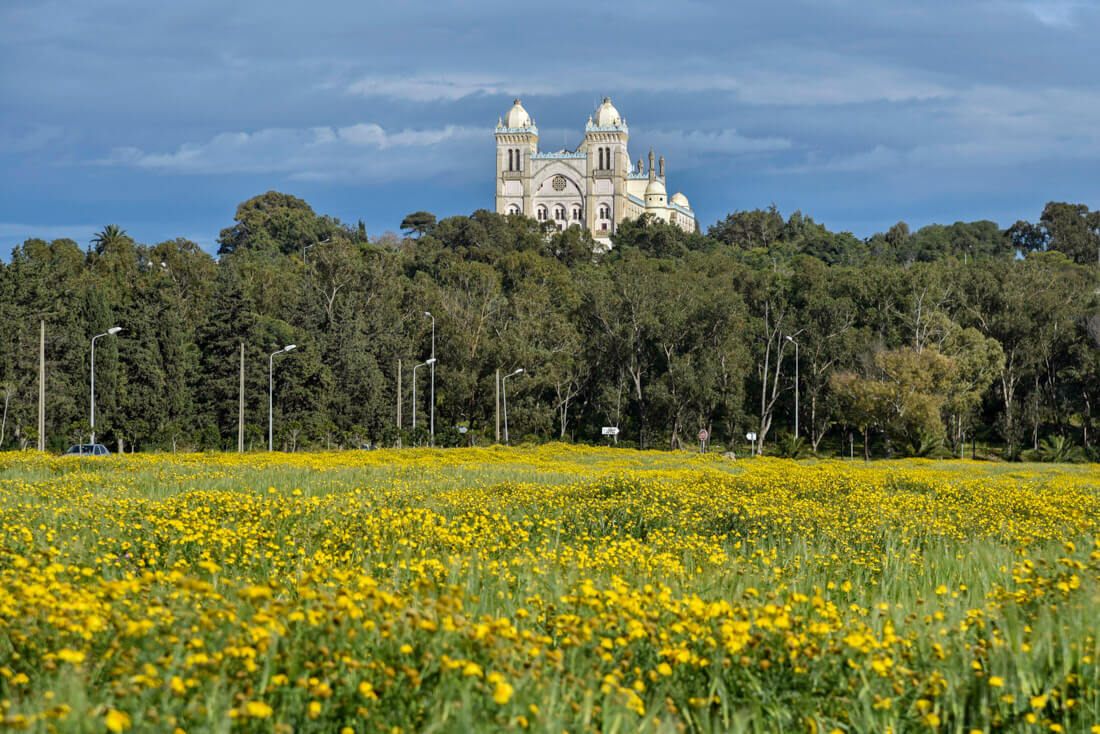
Should you travel in Tunisia independently or on an organized tour?
I visited Tunisia 100% independently, and I recommend you do the same.
However, if you are short of time and want to visit specific places on organized tours, I recommend you use GetYourGuide , a website where you can book any type of tour, from half-day trips to several-day tours with just one click.
🕌 The people and the culture
They are too African to be considered European, but they are too European to be considered African.
These are the words from an expat American woman living in the city of Tunis who I had the chance to meet during my trip to Tunisia.
Along with Beirut , Tunis might be the most secular and open-minded Arab city and you just need to go to the city center and see how people dress.
You find traditional, religious people too, of course, but the beauty of Tunis, and Tunisia in general, is that everybody is free to practice Islam the way they please and, on most occasions, you won’t be judged.

This is why in Tunis you are likely to see a young girl with a short skirt walking in a local market among other women wearing the full hijab, a mix you will rarely see in other Arab countries.
Sousse, Monastir and Sfax are other modern cities with a significant number of liberal people, especially among the young generation.
However, religion still plays an important role in Tunisia’s society. Even Tunis has its traditional districts and the rural areas are very conservative.
But what is true is that in Tunisia there isn’t much fundamentalism compared to other Arab nations and countries in the Middle East.
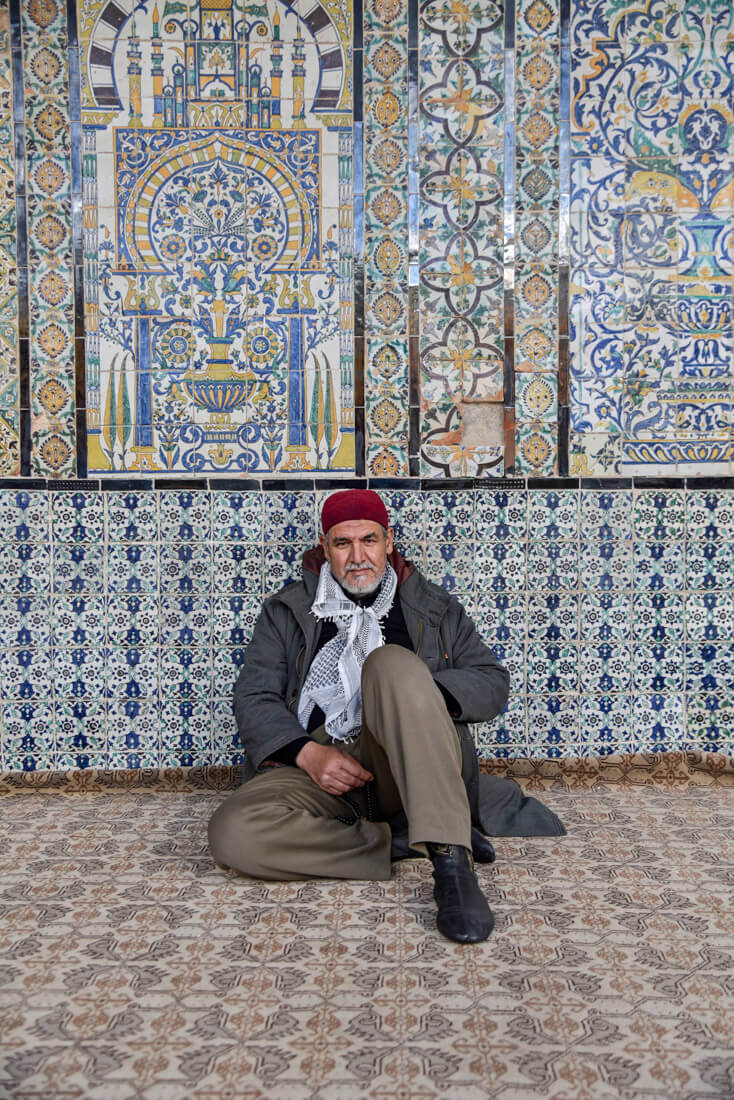
Arabic is the official language in the country, and I believe it is quite similar to the Arabic spoken in Morocco and Algeria.
However, it is very different from other Middle Eastern countries, from Egypt to Oman .
In fact, they don’t even understand each other. When I was living in Dubai, in my office there were Arabs from all the Arab countries and Tunisians would always address Middle Easterners in English.
French & English – Given this used to be a French colony, except for uneducated people from rural areas, pretty much everybody in the country speaks impeccable French, and the best educated Tunisians also have good English, so traveling in Tunisia doesn’t imply any language barrier.

🍲 Food: What can you eat when you visit Tunisia?
Just before my trip to Tunisia, I had spent around 5 weeks in Morocco, so I wasn’t really expecting to taste many different flavors, but I was very wrong.
First of all, Tunisian food is extremely spicy. Like a lot spicy, sometimes Indian-level spicy.
I don’t know why, but Tunisia must be the only Mediterranean country that uses chilis in their cuisine. They love it and also a chilli sauce named harissa , which they put everywhere.
One Tunisian lady told me that every time she travels to Europe, even if it is just for a few days, she always brings some harissa .
Moreover, due to its proximity to Italy, Italian food is a thing here, and the truth is that spaghetti with tomato sauce is a staple, something you can order in any local eatery for less than $1 sometimes, but it isn’t very good pasta to be honest.
Overall, Tunisian food is good, however, whereas in the city of Tunis (and Sousse as well) I had quite a few feasts, in the rest of the country most places would only serve very basic stuff, especially in the south, Tozeur and El Kef.

Must-try dishes in during your trip in Tunisia
- Brik – The most popular snack in Tunisia consists of a filled fried pastry, usually with egg or tuna. By the way, Tunisians love tuna.
- Ojja – Sort of a tomato stew that comes in different versions, from local sausage ( mergez ) to seafood. Ojja is available in pretty much any local eatery.
- Cous-cous – Maghrebi star-dish, and the Tunisian version is very spicy.
- Seafood – In the coastal towns of Tunisia you can find some really great seafood, the most remarkable I ate being some stewed octopus in a tomato gravy, absolutely tender and delicious. I ate it in Sousse, in a restaurant called Cafe Bellar.
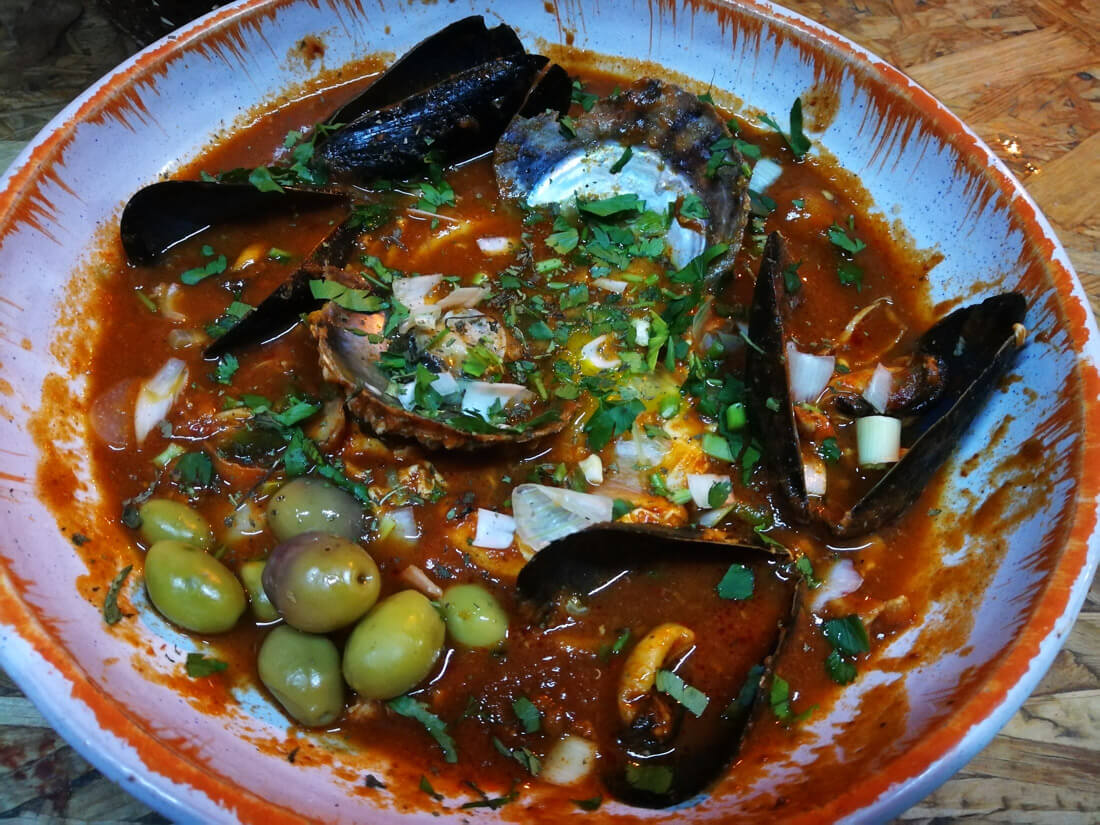
🛺 How to move around: transportation
Typically, there are 2 ways to travel around Tunisia:
Traveling around Tunisia by train
The Tunisian train is great. It is reliable, relatively fast and just soooo good. There is a train line that goes along the coast all the way to Gabés and, as far as I am concerned, the whole line is fully operational.
During my visit, however, the line that connects Tunis with Gabés through Tozeur, in the west of the country, had been closed for several years, but it seems they have already resumed all trains. In any case, you can check timings on the official railway website .
Traveling around Tunisia by louage
Louages are the local mini-vans which basically, you will ride for traveling to places you can’t reach by train. I used them to travel to Kairouan, El Kef and Tozeur and some places in the south. They are very cheap.
💰 Money, budget and costs
In Tunisia, they use the Tunisian Dinar (TND) and approximately:
1 USD = 3.15 TND
Most cities will have ATMs and changing either € or USD should be very easy.
How much does it cost to travel to Tunisia?
Tunisia is cheap, much more than Morocco, mainly because of the currency’s devaluation after the massive drop in tourism. Cost of the most typical things:
- Street sandwich (falafel) – 1-2 dinar
- Local meal (1 ojja) – 5 dinars
- Meal in a good restaurant – 20 dinars
- Entrance fees to places like Dougga ruins, ribats, fortresses, museums – 8 to 12 dinars
- Budget hotel – 20-30 dinars
- Mid-range hotel – From 40-50 dinars
- Transportation – I paid around 4-7 dinars for most train journeys, same for louage.
On a tight budget, I seriously think you can go backpacking in Tunisia for $ a day 20.
Please note that the below table is just an approximation.

⚠️ Is it safe to travel to Tunisia?
Tunisia has had some safety concerns in the past, especially throughout 2015, and that was the main reason why tourism dropped dramatically.
However, the situation has improved drastically and for a better understanding, I recommend you read my analysis:
Is Tunisia a safe country to visit?
Tunisia Itinerary – Places to visit in 2 weeks
How long should you go backpacking in Tunisia for?
I personally spent almost 3 weeks, went a bit slower than the suggested itinerary and visited one or two additional places not included here such as Djerba Island.
Tunisia 2-week travel itinerary map
Day 1, 2 – Visit the capital of Tunis
A third Mediterranean, a third European and a third North African, Tunis is a city with many cultural contrasts and most likely, the starting point of your Tunisia travel itinerary.
On the one hand, the old city is composed of an African, Maghrebi medina, not very different from the ones you would find in Morocco, but without the feeling of being in a tourist trap.
And, on the other hand, you also have the European part of town, which is filled with French-style facades, boulangeries and a relatively Westernized atmosphere.
In addition, think about all the nightlife, nice restaurants, the Roman ruins of Carthage and the Mediterranean-like district of Sidi Bou Said, and I seriously believe that traveling to Tunisia just for visiting Tunis is truly worthwhile.
Things to do in Tunis
I spent whole 5 days in Tunis, and managed to squeeze the things I visited in a 3-day travel guide
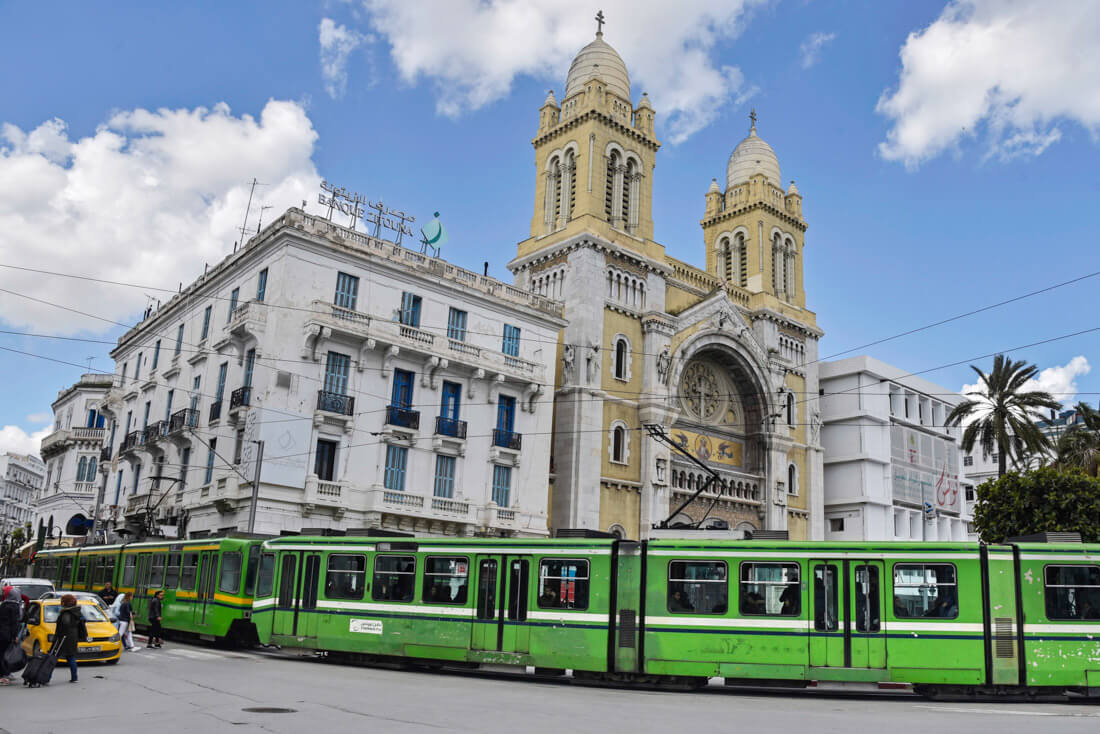
Where to stay in Tunis
Backpacker Hostel – Medina Youth Hostel – Located in the heart of the medina, this is the most backpacking-friendly hostel in Tunis.
Mid-range hotel – Dar La Leila – Super nice, traditionally decorated lovely hotel, the top-rated hotel in Tunis, and super charming staff.
Top-end hotel – Dar El Jeld Hotel and Spa – A 5-star but traditional hotel that offers all the luxuries.
Best tours in Tunis
I recommend you look for tours via GetYourGuide .
Carthage and Sidi Bou Said – Roman ruins of Carthage and the Santorini-like city of Sidi Bou Said.
Bardo Museum & Medina – The classic medina + the museum containing one of the largest collections in the world of Roman mosaics.
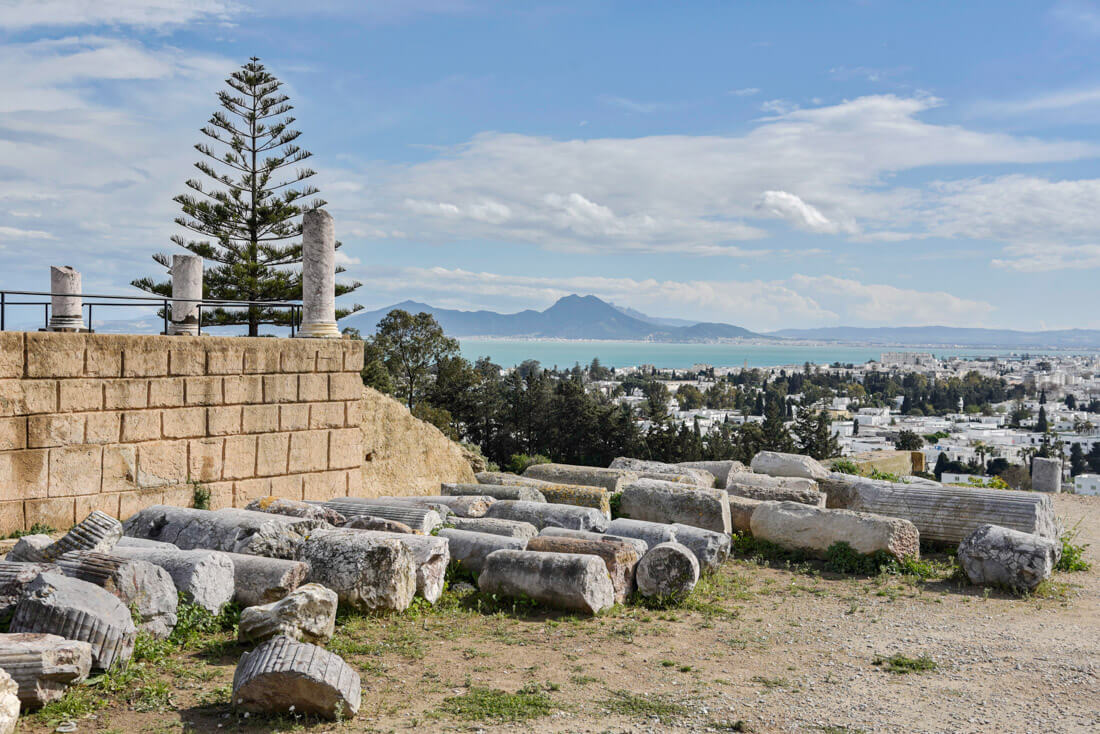
Day 3 – The resort-like town of Sousse
This is the prime tourist destination in the country, for foreigneirs and Tunisians alike, but for independent travelers, it feels a bit odd.
It feels weird because the coastal front line of the new part of town is composed of ugly, mass tourism-like buildings, restaurants with over-priced menus and just the kind of trashy tourism I would try to run away from.
However, Sousse is the city that witnessed all those unfortunate terrorist events from 2015 , so during my visit in the month of May, it felt like a real ghost town and, in any case, the old part of Sousse is a great place to get lost in, among its narrow alleys.
Moreover, Sousse is a good base to explore a few places around such as Kairouan, Monastir or El Jem. I mean, you can find accommodation in those cities but Sousse has the largest offer of hotels, restaurants, and cafés so, for me, it made sense to hang out there for a while.
Looking for visiting Sousse on a tour? CLICK HERE TO CHECK ALL AVAILABLE TOURS IN SOUSSE
Things to do in Sousse
- Medina – Like all medinas in Africa, the medina of Sousse is a maze of streets where the highlight is getting lost and escaping from the main souvenir area.
- Great Mosque – From the 8th century. They make you pay an entrance fee, a bit unusual for being a regular mosque, but Tunisia is mostly like that.
- Ribat – Old Islamic fortress from the 8th century. It contains one of the oldest praying halls in Africa.
- Sousse Archaeological Museum – I am the least museum-friendly person but I loved the museum of Sousse because it contains some of the largest collections of Roman mosaics, including a massive one of Medusa . Check the official website for timings.
Ribat – A ribat is a small Arabic fortress typically found along the northern African coast, and built during the first years of the Muslim conquest. Most coastal towns in Tunisia have their own ribat and they tend to be pretty well-preserved. The word ”ribat” means ”defense of Islam”.

Where to stay in Sousse
Budget/backpacker – Hotel Paris – Basic hotel with relatively good Wi-Fi inside the medina. I stayed here.
Mid-range – Dar Antonia – Traditional, fancy dar in the medina.
How to get to Sousse from Tunis
There are several trains a day running to Sousse from Tunis central station.
A ticket would typically cost 10,000 dinars and it takes a bit more than 2 hours.
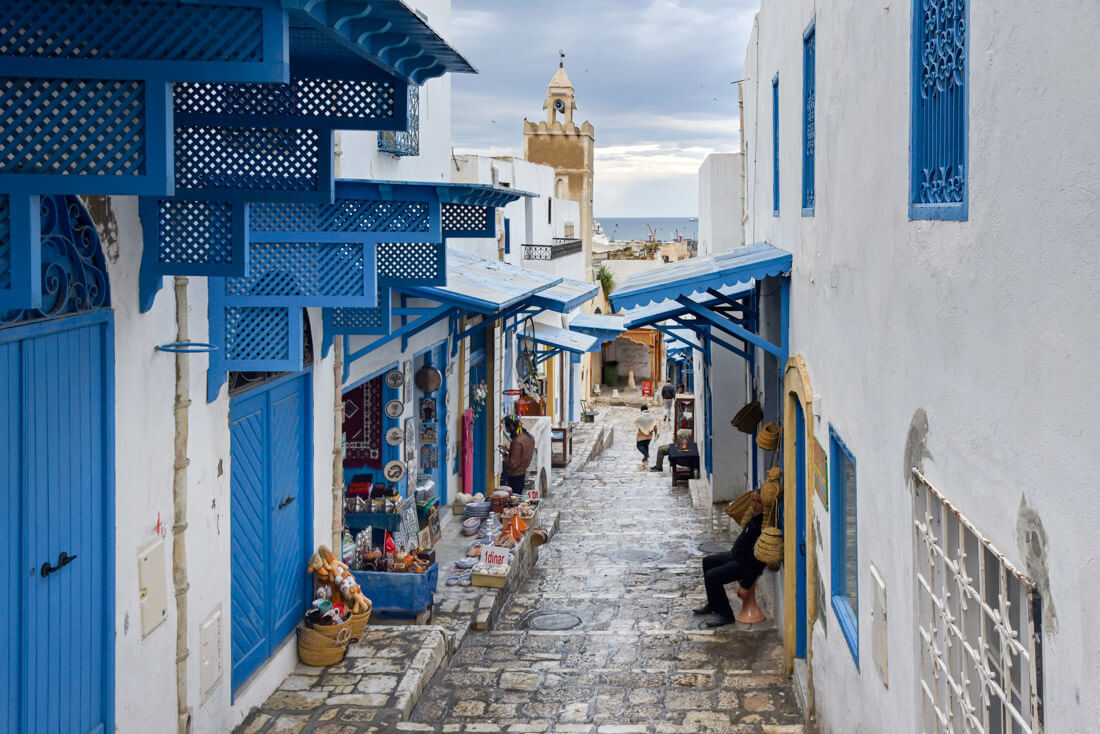
Day 4 – Day trip to Monastir
If you have the time, Monastir is a pleasant town that was founded as a Phoenician trading settlement more than 2,000 years ago.
Monastir is a peaceful, free-of-crowds town, as the touristic area is quite far away from the center, so it has managed to keep a certain charm, plus in my opinion, Monastir has the most well-preserved ribat in the country, a set of labyrinthic passages and stairways that seem taken from a movie.
Moreover, Monastir is the birthplace of Habib Bourguiba , the man who lead the country to independence from France and ruled the country from 1956 to 1987.
Other than that, Monastir is an all-right place to hang around for a while.
My visit here was a peculiar one. After visiting the ribat , I met with one local lady who had contacted me through Instagram and she took me to the local radio station’s offices – she was working there – and I kind of kept staring at what they were doing for a while.
Then, we went to Habib Bourguiba’s mausoleum.
You can also visit Monastir on an organized tour (along with Sousse) from Tunis. CLICK HERE TO LEARN MORE
How to get Monastir from Sousse
Monastir is a 20km train ride from Sousse and trains run continuously throughout the day for $1 or less.
The Great Roman Civil War Do you know about the famous Roman Civil War between Julius Caesar and Pompey ? It was the war that led Rome from a Republic to an Empire, and the last stage that guided Julius Caesar to victory occurred on the battlefield between Sousse and Monastir. The coolest thing about it is that today’s Monastir was Caesar’s base, and Sousse was Pompey’s. They even made a TV series on Netflix.
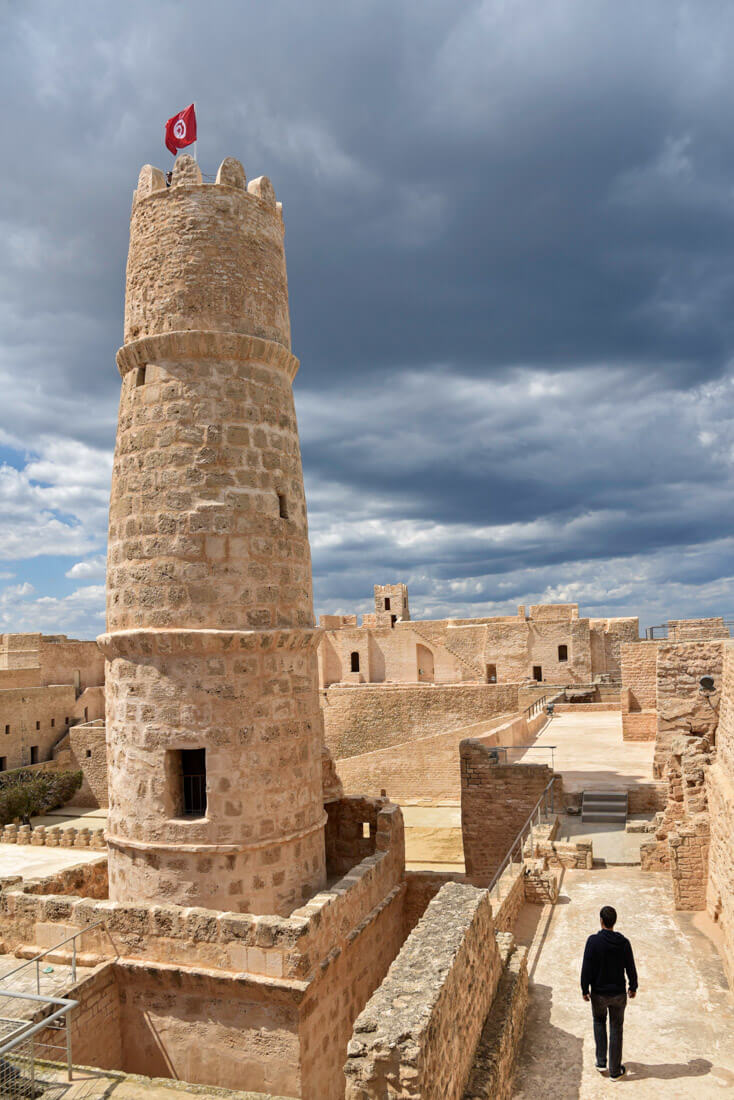
Day 5 – Day trip to Kairouan, the holiest city in Tunisia
Some sources claim Kairouan is the holiest Islamic city in Africa, and the fourth in the world after Mecca, Medina and the Dome of the Rock in Jerusalem.
I am not sure about that, however, because I have been to other places in the Middle East and Africa with the same claim but it is a fact that this is the holiest place to visit in Tunisia and the atmosphere is so different from anywhere along the coast, so low-key, so traditional and overwhelmingly welcoming.
Interested in visiting Kairouan on a guided tour? CLICK HERE TO SEE ALL AVAILABLE TOURS IN KAIROUAN
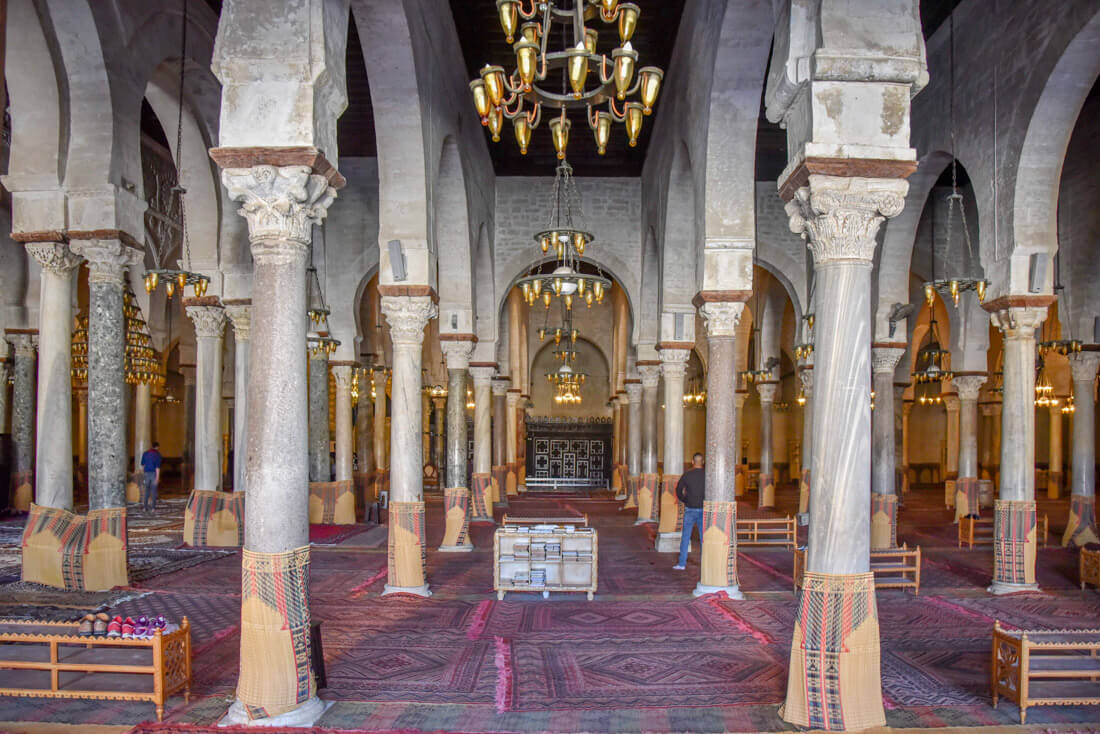
Things to do in Kairouan
At the Great Mosque, you can purchase one ticket that allows you to visit several sites and these are the ones I visited:
- Great Mosque – From the 7th century, one of the holiest Islamic places in Africa.
- Bir Barouta – An Ottoman-era building that was built around a well which apparently, connects to another well in Mecca. Sadly, they enslaved a poor camel that spends his day turning the well’s wheel.
- Zaouia of Sidi Sahab – Very beautiful Muslim complex with Andalusian-style tiles.
How to get to Kairouan from Sousse
There isn’t a train line passing through Kairouan, so you need to take a louage , which takes a bit more than 1 hour.
Sousse bus station is outside of town, here: 35.809717, 10.636374.
Mullah stories In Kairouan (in Zaouia of Sidi Sahab) I was approached by a kind Tunisian who gave me a 30-minute Islamic lesson in an attempt to persuade me to consider converting to Islam, and it was only 30 minutes because very kindly, I told him I had to leave. A very intense man, but I have bumped into many of those in my travels, and they always tell you the story of a British or an American who found God, hence inner-peace and happiness, after listening to his words.

Day 6 – Day trip to El Jem, an impressive Roman amphitheater
El Jem was one of my favorite places in my Tunisia itinerary.
This is home to one of the most epic Roman amphitheaters in the world, in fact, the 3rd largest one, built in the 2nd century, but for obvious reasons, it is much less crowded than the one in Rome.

Around 1km from the amphitheater, there is an archaeological museum also containing plenty of Roman mosaics, many of whom feature the scene when wild animals were released into the arena to eat convicts.
You must get the ticket at the amphitheater’s office, and it also includes the museum entrance.
Since it is on the way to Sfax, I took a train from Sousse early in the morning, visited El Jem for a few hours, and then I could easily get a train to Sfax.
Next to El Jem’s train station, there is a fancy hotel whose staff were kind enough to keep my backpack while I visited the city.
How to get to El Jem from Sousse
It’s a 1-hour train journey from Sousse central train station
Looking for guided visits to El Jem? CLICK HERE TO SEE ALL AVAILABLE TOURS TO EL JEM

Day 7 – Sfax, the coolest medina in Tunisia
Before traveling to Tunisia, I had read in a guidebook that the locals of Sfax were believed to be very thrifty hard-workers.
In my experience, most guidebooks are always filled with unlikely quotes but upon my arrival in Tunis, I spent some time discussing my Tunisian itinerary with a local guy who told me the exact same thing.
And, perhaps, this is the reason why, despite being untouched by tourism, Sfax has some sort of cosmopolitan feel by African standards, and many people there seem to be very open-minded.
Additionally, Sfax is also home to the best medina in the whole Tunisia, very big and authentic which hasn’t been spoiled yet by the arrival of tourists.
Things to do in Sfax
- Getting lost in the medina – As I said, this purely African medina is very traditional and authentic.
- Abandoned Synagogue – Tunisia used to be home to a large Jewish community and, in Sfax, there is an abandoned synagogue.
- Place de la Republique – French-style buildings at the entrance to the medina.
Where to stay in Sfax
There are 2 budget auberges (one next to other) 2km north west outside of the Medina.
For more hotel options in Sfax,
Jews in Tunisia Tunisia today has one of the largest Jewish communities in the Arab world, mainly living in Tunis city and Djerba Island. Of course, most of them migrated to Israel after the Israel-Palestinian war but many of them remain and a few synagogues are still functional, another fact that proves overall the tolerance in Tunisia.
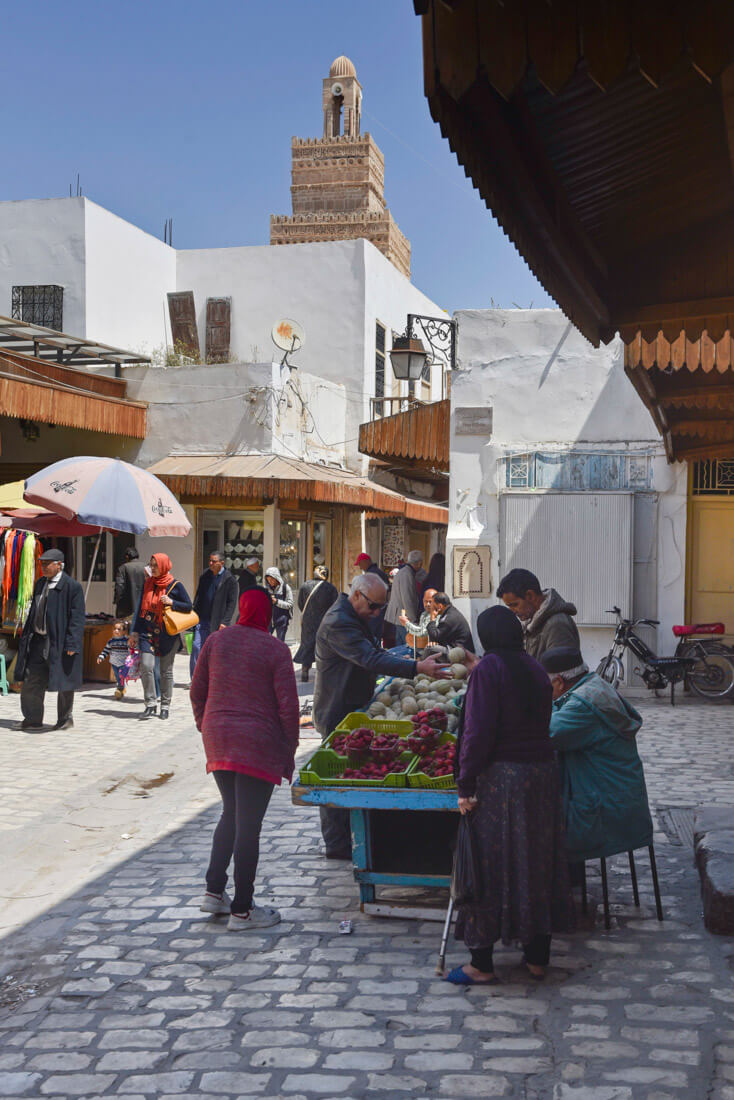
Day 8, 9 – Tataouine & around: southern Berber lands
The lesser-visited southern part of Tunisia is an arid territory that extends all the way to the Libyan border.
Berber villages, camels, ancient ksars (fortified Berber villages), and just remoteness and inhospitality, no wonder why George Lucas decided to shoot Star Wars in these lands.
This is just so different from any place you visited in Tunisia, way more conservative and home to the Berbers, the indigenous people of North Africa before the Arabs came.
How to visit Tataouine The area is vast, touristic sites are scattered, and there is no public transportation. I mean, there are a few buses but it is not a convenient way to move around, not even for backpackers. The best way to explore this area is by either renting a car or going on a tour. I rented a car for a day in a rental car office in Medenine and paid less than $25.
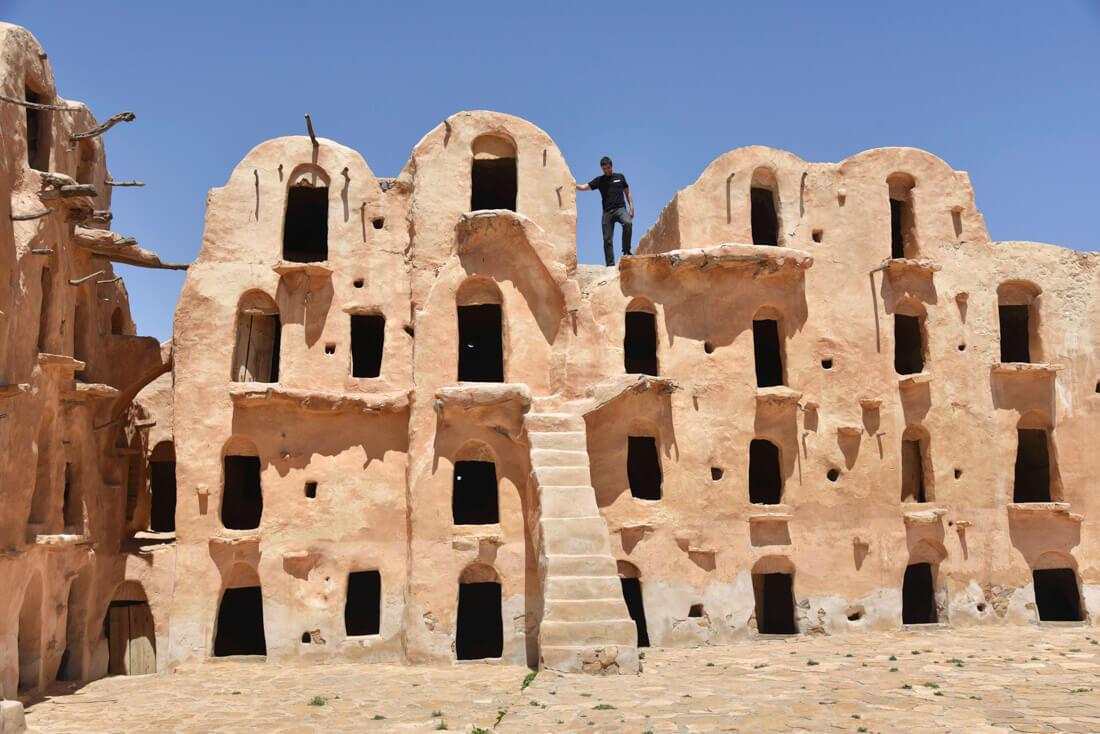
Things to do in Tataouine & around
On a normal path, you will need an entire day to visit these places, and still, you may have to rush a bit. If you want to leave early in the morning, I suggest you rent the car on the day before, as rental car shops didn’t open until 9-10am.
The ”green pins” from the previous interactive map mark the following places:
- Ksar Ouled Soltane – The most well-preserved ghorfas in the area. Ghorfas are ancient 4-story buildings that Berbers used to store the grain.
- Chenini – For me, this was the best place to visit in Tataouine. A massive ancient ksar from the 12th century sitting on a hilltop. Gorgeous.
- Guermassa – Another great ksar, not as epic as Chenini’s but still great. I only saw it from the bottom because it takes almost 1 hour to go up and I didn’t have time. The top, however, can be reached by 4WD.
- Ghomrassen – Off the beaten track modern town with pretty cool local architecture, and the ideal place to stop for lunch.
- Ksar Hadada – This ksar used to be a movie set for Star Wars. I am not a big Star Wars fan, so for me, it was not that interesting, as it was nothing more than some commercial, over-restored ghorfas .
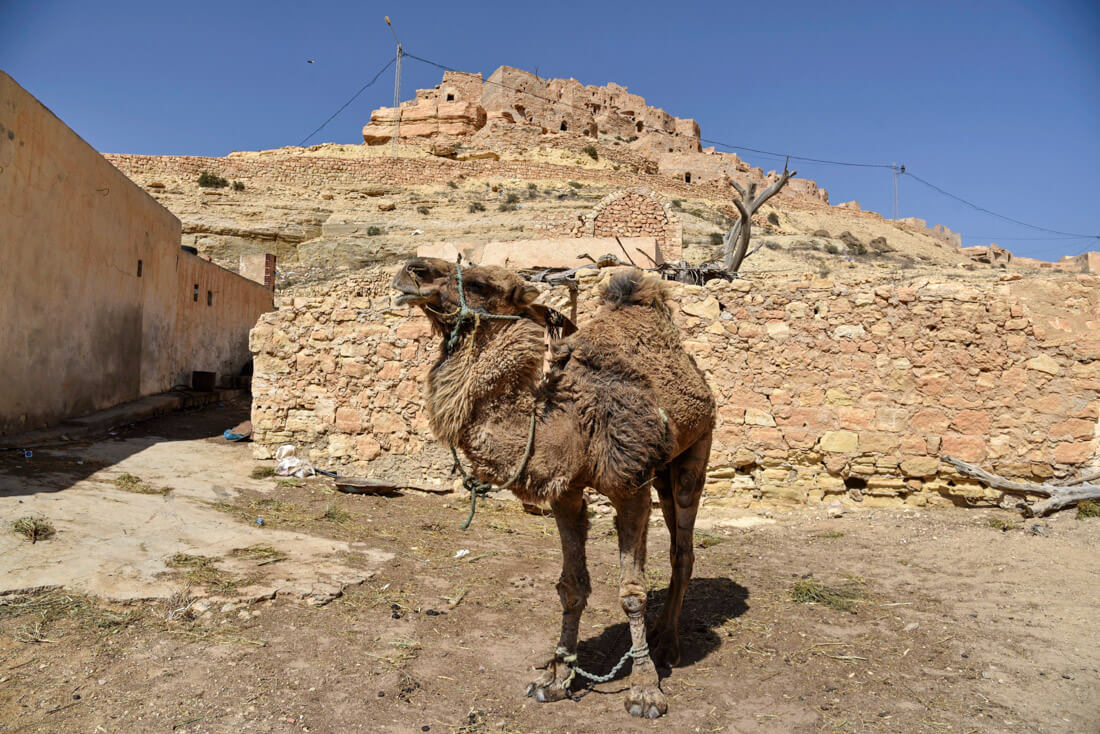
Where to stay in the area
I recommend you stay in Tataouine.
Budget – Auberge Alferdaus – An all right auberge/pension for budget travelers and backpackers.
Apartment – Dar Essadeg – Full traditional apartment.
Mid-range – Sangho Privilege Tataouine – For a comfortable stay, this oasis hotel has great facilities, including a pool, and it is not expensive at all for what you get.
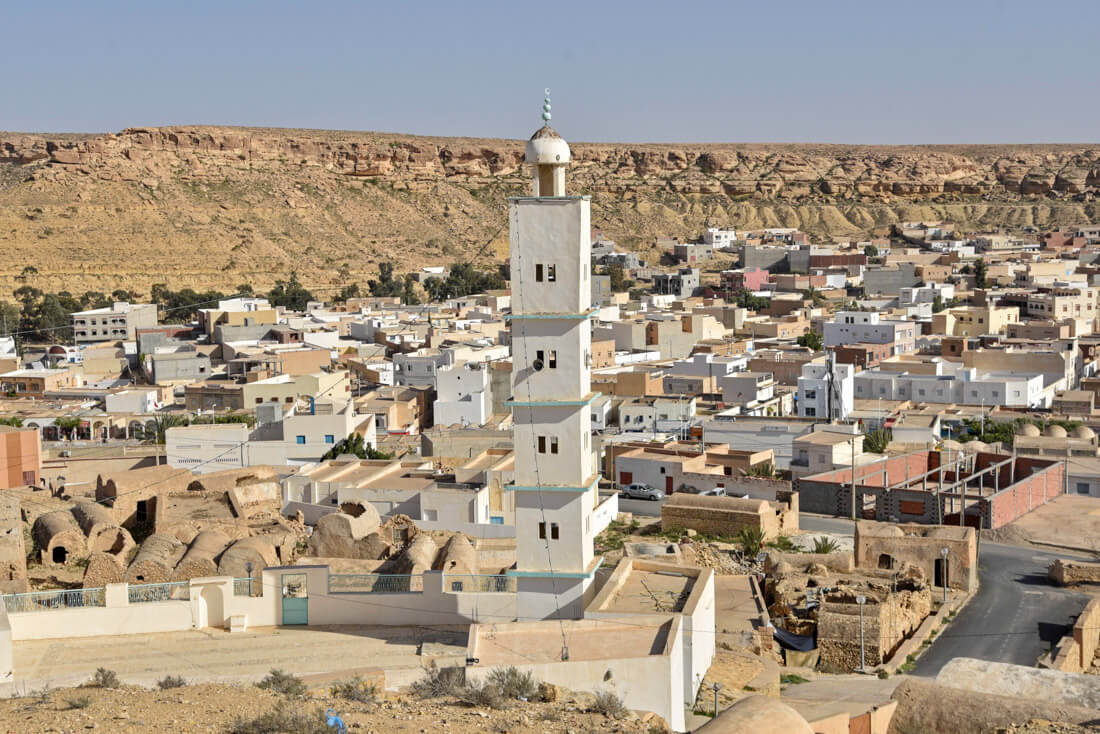
Day 10, 11 – The oasis-town of Tozeur & around
Tozeur is a pleasant oasis town with a very unique old quarter whose buildings are made of bricks (hand-made apparently) and a base from which to explore other mountain oases and check out potential camel caravans.
They claim that those oases have been inhabited for 10,000 years.
If you have been reading my blog for a while, you will know that I like to be honest, and the truth is that this was my least favorite part of my trip to Tunisia.
First of all, because all those landscapes are in my opinion, a small version of the ones you find in north Oman , a country I visited multiple times. And second of all, because this was the only place where the main sites were just packed with tourists, many of them being the irresponsible type. But to be fair, it also didn’t help that the weather was awful (loads of wind and sand).
But anyways, traveling is extremely subjective and you might have a different experience.
Like Tataouine, the area around Tozeur is best explored by car or on an organized excursion. Most hotels can arrange it for you. I personally explored all places with a local friend I had met on Instagram.
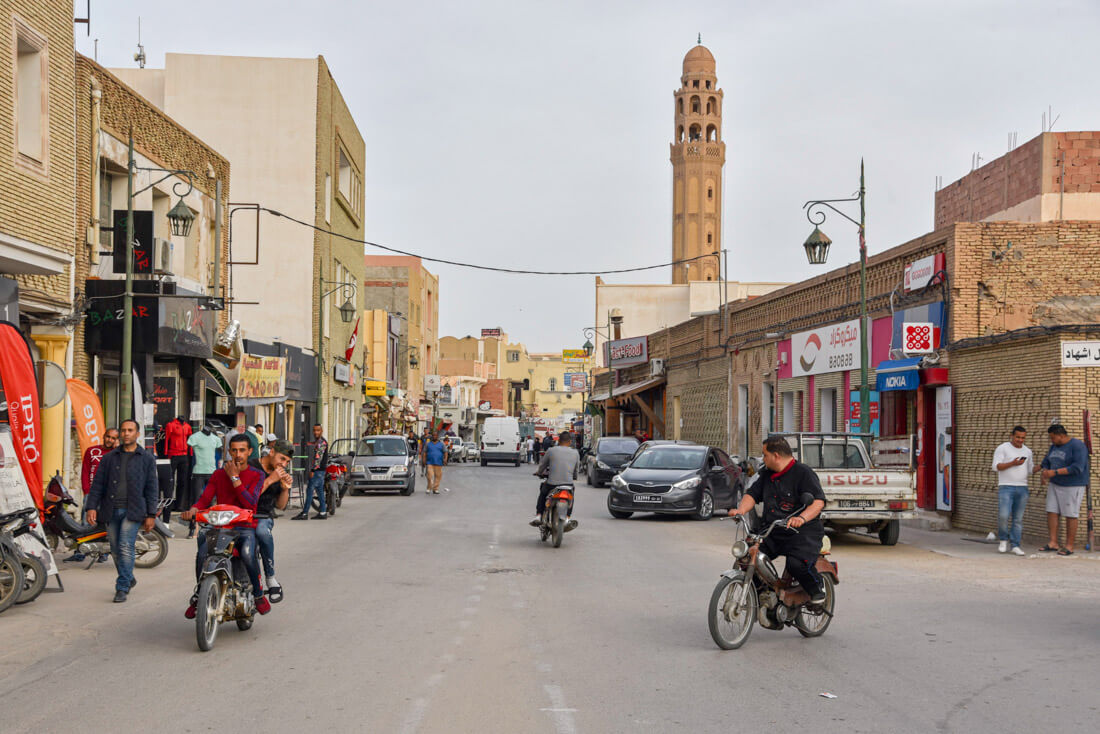
Things to do in Tozeur
Please see the ”orange pins” from the previous interactive map.
- Chebika – A small village home to a massive palmeraie.
- Tamerza – Another small village with a palmeraie, a small canyon, and a waterfall.
- Midès – And another small oasis village but the highlight is the stunning views you get to see from the road that leads to it.
- Ong Jemal – A desert famous for its sunsets and the location of a Star Wars movie set, where the original decoration still remains. Tour agencies will tell you need a 4×4 to reach the place but it is not true.
Where to stay in Tozeur
Budget – Residence Warda – A budget pension good for backpackers.
Mid-range – Residence Loued – A very pleasant traditional hotel at the heart of the Old City.
How to get to Tozeur from Tataouine
The journey is rather more than 300km.
From Tataouine, you need to take a louage to Medenine and from Medenine, another one to Gabés (not sure if you can find a direct one from Tataouine).
If you are lucky and trains are functional, you should be able to take a train from Gabés to Tozeur. Otherwise, take a louage from Gabés to Gafsa and from Gafsa to Tozeur.
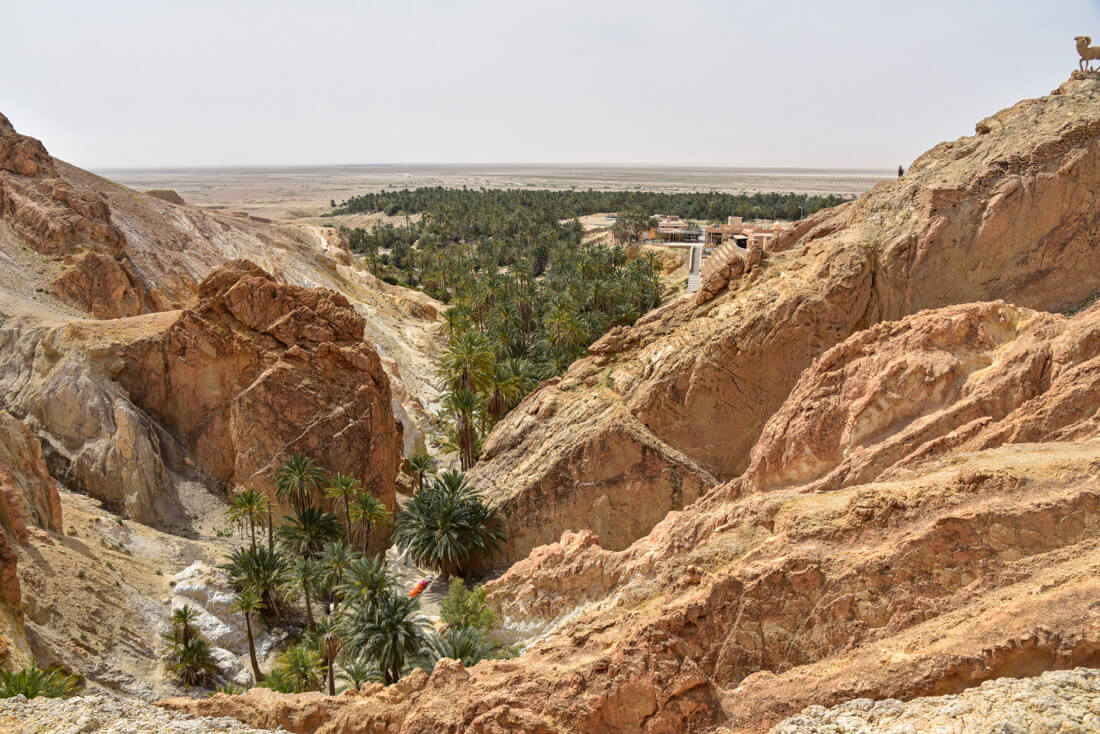
Day 12 – El Kef, traditional off the beaten track town
El Kef and the area around was my favorite part of my Tunisia itinerary.
It is a barely visited town and the top of the medina features a kasbah from where you get stunning views of the city and the green meadows surrounding it.
It has a very authentic, traditional atmosphere as well. I spent 3 nights here – as I used it as a base to explore some places around – and didn’t bump into a single tourist.
Where to stay in Le Kef
There aren’t many options, but I stayed in a hotel close to the Medina named Hotel Sicca Veneria , where I paid $15 a night. It was good!
How to get to Le Kef from Tozeur
It’s a long way, around 330km.
From Tozeur, you need to first get a louage to Gafsa. From Gafsa, a second louage to Kasserine and from Kasserine to Le Kef. It takes the entire day.
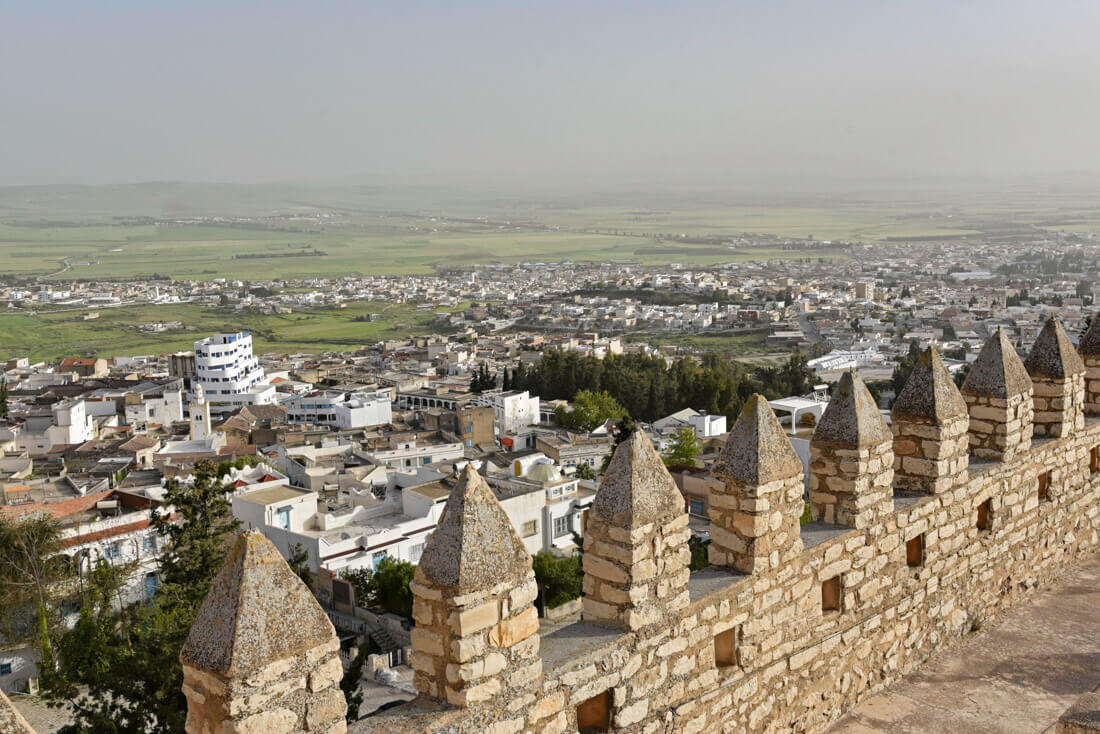
Day 13 – Day trip to Jugurtha Tableland
This off the beaten track gem was the top attraction I visited in Tunisia.
A natural military fortress, Jugurtha Tableland is a massive flat-topped mountain that rises above 1270 meters, and that has been used as a fortress for centuries, from the Romans to today’s Tunisian Army.
That’s why this is kind of a sensitive place, especially because this is a border area from where you see Algeria – stunning views of Algeria, by the way – so having a guard with you all the time is a must (free of charge).
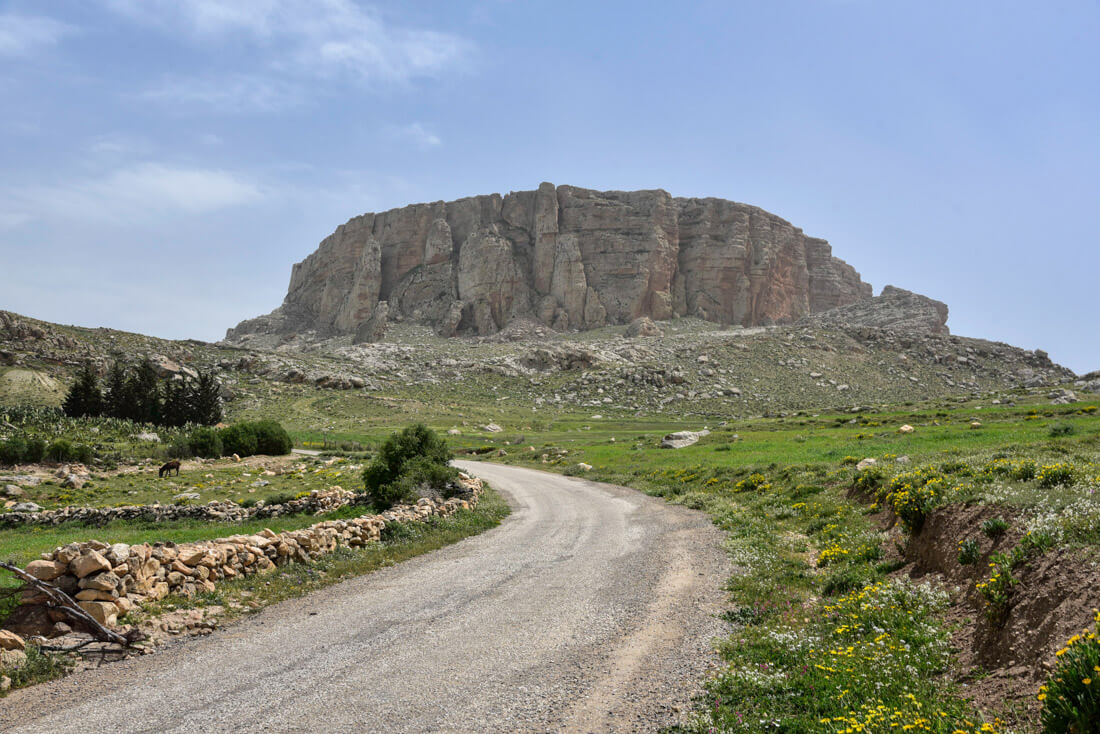
How to get to Jugurtha Tableland from El Kef
From El Kef bus station, you can take a louage to the border town with Algeria named Qalat as Sanan.
Most likely, the driver will already know about your intentions, so he will drop you at the police station, where they will make you answer a few questions and register for visiting Jugurtha.
I was extremely stupid to forget my passport in El Kef but, luckily, my Spanish ID was enough for them.
Then, the police helped me looking for a taxi to take me to the bottom of Jughurta (4km), and I paid the equivalent of around $10.
Once you arrive, an official guide will welcome you and take you to the top.
It also possible to camp at the top, but you will have to get permission at the police office, and a guard will be with you all night – I mean, they have their own huts. However, be aware that it is extremely windy.
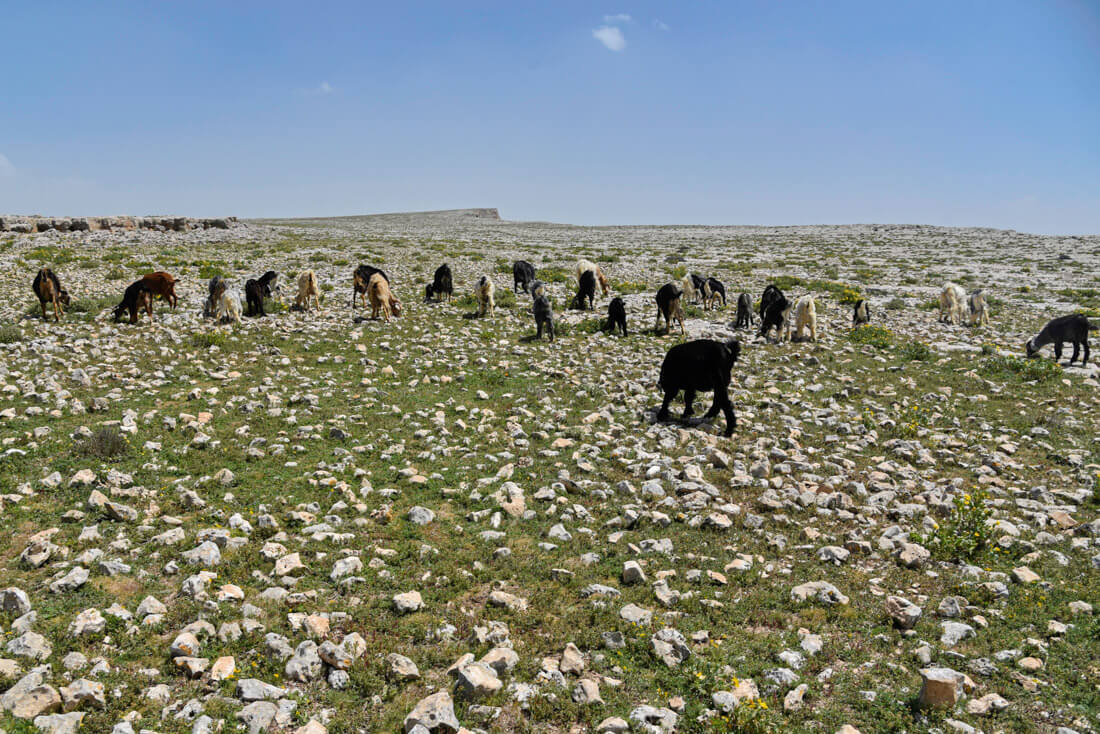
Day 14 – Day trip to Dougga Roman ruins
When I traveled to Tunisia, I also got the chance to check out this amazing place, a UNESCO World Heritage site since 1997 named Dougga,
Dougga has some of the most impressive Roman ruins I have ever seen outside of Rome, probably more stunning than the ruins of Baalbek in Lebanon , or Jerash in Jordan , not only for the ruins themselves, which are in great conditions but also because Dougga was set up in a prime, fertile location, today surrounded by beautiful olive trees and wheat plantations.
Absolutely gorgeous.
Dougga is dominated by the perfectly well-preserved Capitol, dedicated to Jupiter, but you can also find many other temples in good conditions and an amphitheater.
Allow yourself a few hours to visit the area and try to come by the end of the day, when little crowds are gone and, if possible, on a weekday.
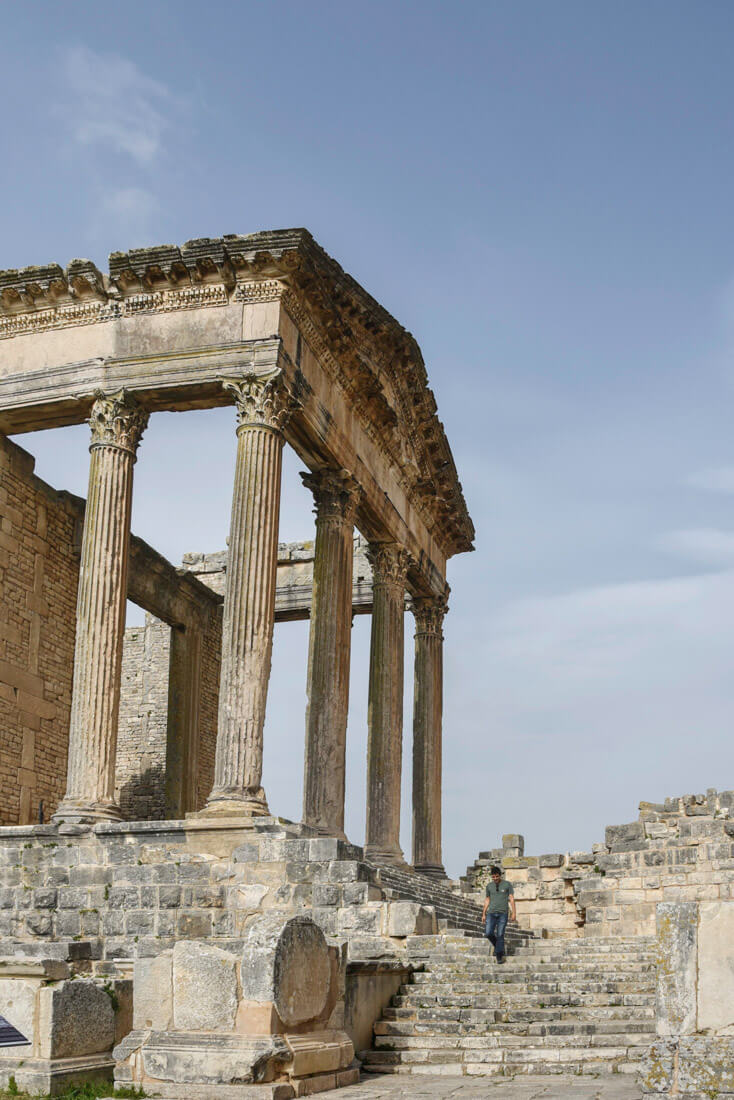
How to get to Dougga from El Keff
It was a bit complicated.
From El Kef, I took a louage to a village named Al Karib. Once in Al Karib, I asked for a louage going to Dougga town, which is 4km from the ruins, but everybody kept me saying there weren’t any, so I decided to hitchhike the remaining 20km, but it was a bit hard, as nobody would stop, don’t know why.
Then, on my way walking from Dougga town to the ruins, a kind man – a worker – picked me up.
Coming back to El Kef was fairly easy, as I just got in the first louage that passed by. By the way, from Dougga, you could easily go back to Tunis.

❗ More information for backpacking in Tunisia
📢 In my Travel Resources Page you can find the list of all the sites and services I use to book hotels, tours, travel insurance and more.
Get the Tunisia Travel Guide by Lonely Planet – A bit outdated but so far, the only one available.

All guides and articles for traveling in Tunisia destination
- Tunis Travel Guide
- Is Tunisia Safe?
Travel guides to other countries in Africa
- Ethiopia Travel Guide
- Eritrea Travel Guide
- Somaliland Travel Guide
- Travel Guide to Sudan
- Travel Guide to Egypt
- Libya Travel Guide
- Mali Travel Guide
- Travel Guide to Mauritania
PIN IT FOR LATER
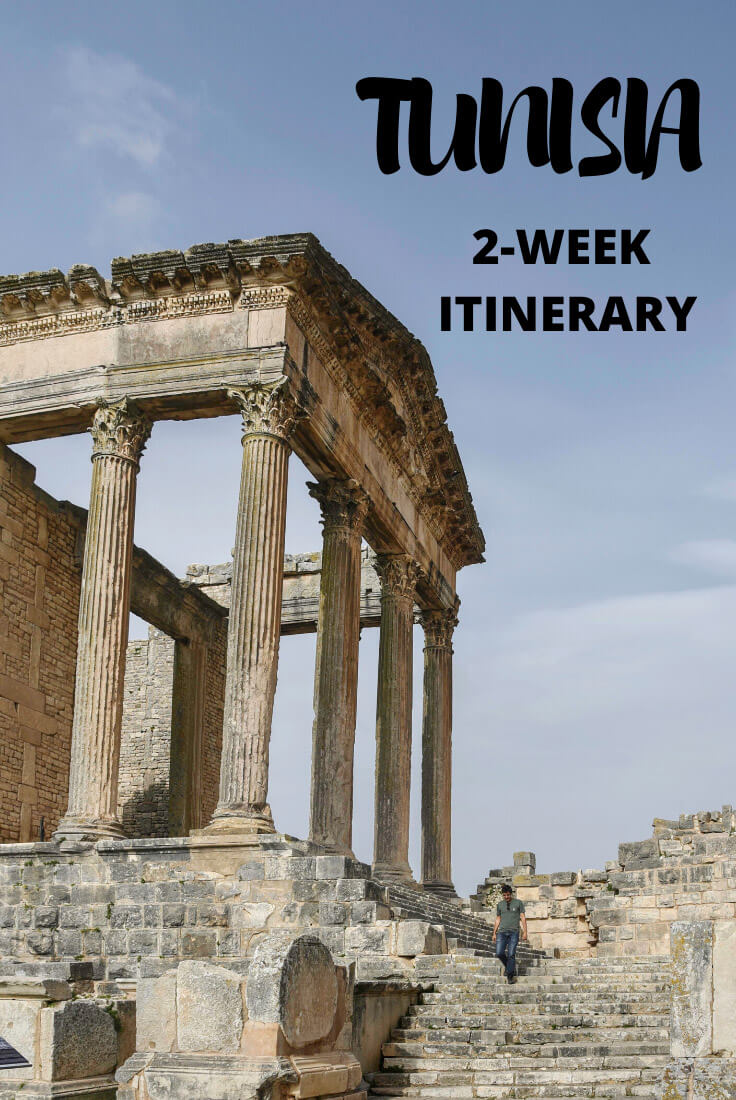
20 comments
Great blog and info as always:)Am supposed to go to Tunisia in october for 2,5 weeks ,still plan on going if……
Love reading your post, as it brings so many great memories. We have done 2 weeks roadtrip around the country too, but left the northern part for next time – I sure hope to be able to return soon and that these crazy times will be just a bad memory. All the best!
Has anyone rented a car and drove around Tunisia independently?
I did, in the south. Very easy
Man, let me tell you something and you can take it as a fact: any Arabic speaker can speak freely with another Arabic speaker from anywhere in the world. Yes, there are diferences and they can tell roughly from where the other dude is. Like I can tell a Texan from an Australian.
Hey Joan: Another great trip report. Currently planning my itinerary for my summer trip to Tunisia. This will largely be a RnR/beach vacay but looking to include some side excursions. Will likely position ourselves in Sousse and wondering if Dougga is doable as a day trip via public transportation? Also how does it compare to the amphitheatre in Busra, Syria?
Just want to make sure, the train to Sousse from Tunis is 10,000 Dinars or more than 3,000 USD for a 2 hour train ride?
Hi Joan, Thank you for a great introduction to Tunesia. Being European I typically spend my vacations at tourist hotspots in Spain, Greece, or Italy. It’s nice – but far from the adventure you’re describing. Need to convince the rest of my family to become a bit more adventourous 🙂
Mega helpful. Thank you.
Is there anyway to get from Sousse to Dougga?
Thank you for the information. Planning on a 2-week trip end of April 2023. Trying to source information about the Northern part especially traveling from/to Tunis – Bizerte – Cap Engela – Tabarka – Tunis
I’d love to visit Dougga. You said it’s possible to get back to Tunis from Dougga, is there a louage going between the two?
Hi Sarah, not from Dougga, since that is an archaeological site, but from nearby villages or towns.
Good evening, Hope everything is fine. I am planning to go to Tunisia and I wonder if there is a way to go from Medénin to Djerba Island by public transportation. If you know if there is a way I would like you to confirm it to me. Thank you in advance
Hey, I don’t remember exactly but I did go there by bus. It should be easy, just go to the bus station and ask for it
hello joan . i am planning to visit tunisia in august and move around with louages. in your article you mentioned that you visited tozeur with a louage. do you remember if it was direct ( tunis – tozeur ) or i have to change a bus in another city ? also , the station in which louage leave ( from tunis ) is called moncef bey , right ? any information will be helpful . thanks in advance and also thank you for sharing all these travel informations for countries that are not so visited . greetings from greece 🙂
Hi Konstantina! I traveled slowly from Tunis to Tozeur, stopping in many places in between, so I can’t really tell!
Hola Joan, qué tal?
A ver si hay suerte y ves el mensaje a tiempo. Estoy en Túnez y en unos tengo pensado visitar la zona alrededor de Medenine/Tataouine y estoy buscando un sitio para alquilar coche un día. Me podrías pasar el nombre, la ubicación o algún contacto aún mejor del sitio dónde alquilaste tú?
Muchas gracias, saludos!
Hola Jack, lamentablemente jamás me apunté la dirección, pero todo lo que hice fue buscar en Google Rent a Car
hello , thank you for writing about Tunisia but I think you should update your prices for the food , those prices must be from 10 years ago !
They are from 2019 but if you have any updated prices, they are most welcome 🙂
Leave a Comment Cancel reply
Your email address will not be published. Required fields are marked *
Notify me when new comments are added.
Join our Expeditions
From Syria to Iraq in Pakistan, Against the Compass is finally running expeditions to the most epic and off-the-beaten-track countries.
We have scheduled expeditions for every month of the year.
Latest posts
- How to travel to Afghanistan during Taliban rule (2024)
- How to Travel to Libya in 2024
- Backpacking Venezuela Travel Guide (2024)
- How to visit Los Llanos in Venezuela
- How to visit Angel Falls and Canaima National Park
You will be redirected to your dashboard shortly. We will also call you back in 24 hrs .
- Exploring The 10 Best Places To Visit In Tunisia In 2024
28 Sep 2023
Travelling to Tunisia is a journey into a vibrant tapestry of history, culture, and natural beauty. Located on the northernmost tip of Africa, this North African gem offers a unique blend of ancient traditions and modern aspirations. Its historical significance is palpable in its well-preserved archaeological sites, such as the ancient city of Carthage and the Roman ruins of Dougga. The medinas of cities like Tunis and Sousse transport visitors back in time with their narrow alleys, ornate doorways, and bustling souks filled with exotic treasures. If you are planning a holiday to this region, continue reading to know the best places to visit in Tunisia and set an itinerary that includes all the experiences.
10 Best Places To Visit In Tunisia
Whether you’re exploring historical sites, enjoying nature’s wonders, or indulging in local delicacies, Tunisia promises a rich and unforgettable travel experience. Here, are the best places in Tunisia worth exploring on your next visit:
1. Carthage
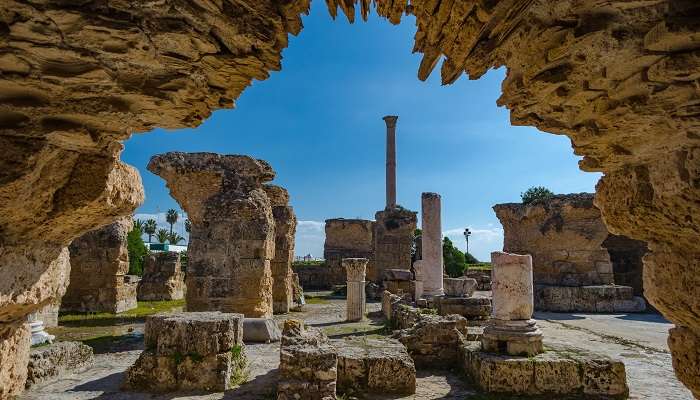
Image Source: Shutterstock
Explore the ancient ruins of Carthage, a UNESCO World Heritage Site, and learn about its fascinating history as a powerful Phoenician city. Don’t miss the Carthage National Museum, which houses an impressive collection of artifacts. Carthage, once a mighty Phoenician city located in modern-day Tunisia, is steeped in history and intrigue. Founded in the 9th century BC, it grew to become a powerful maritime empire, rivaling Rome for dominance in the Mediterranean.
The UNESCO World Heritage Site of Carthage offers a unique opportunity to step back in time and discover the captivating history of this once-mighty civilization, making it a must-visit destination for history enthusiasts and archaeology buffs. This is undoubtedly one of the best places to visit in Tunisia.
Famous Tourist Attractions: Saint Louis Cathedral, Baths of Antoninus, Carthage National Museum, Punic Ports of Carthage, Salammbo Tophet
Must Read: Zambezi River Guide: All About Your Next Soothing Trip In Africa
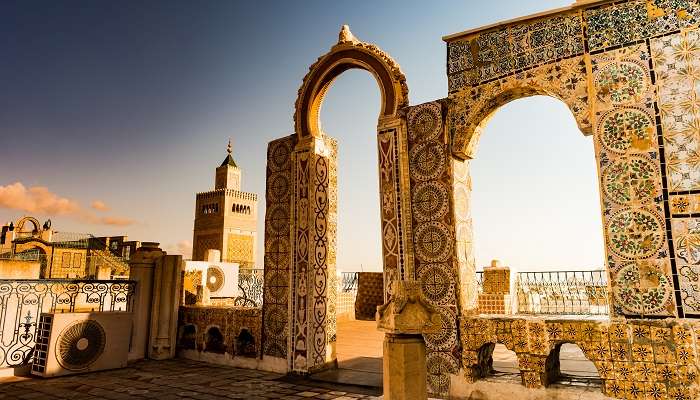
Tunis, the capital city of Tunisia, is a captivating destination that seamlessly blends tradition and modernity. Its historic heart lies in the labyrinthine streets of the Medina of Tunis, a UNESCO World Heritage site where you can get lost in the maze of narrow alleyways and discover centuries-old architecture.
Beyond Medina, Tunis offers a range of attractions. The Bardo Museum is renowned for its exceptional collection of Roman mosaics, providing a glimpse into Tunisia’s rich historical heritage. Just a short drive away, Carthage beckons with its ancient ruins and historical significance, dating back to the Phoenician era.
Famous Tourist Attractions: Medina, Ez-Zitouna Mosque, Cathedral of St Vincent de Paul, Ben Bhar, Avenue Habib Bourguiba
3. Sidi Bou Said

Sidi Bou Said, often referred to as the “Blue and White Village,” is a picturesque coastal town located just a short drive from Tunis, the capital of Tunisia. What immediately catches the eye in Sidi Bou Said is its enchanting blue-and-white architecture.
The town’s buildings, adorned with cobalt blue doors, window frames, and wrought-iron railings against a backdrop of brilliant white facades, create a visually stunning and unique ambiance. This iconic color scheme has earned Sidi Bou Said its distinctive nickname and draws visitors from around the world.
Famous Tourist Attractions: Dar El Anna, Ennejma Ezzahra, D’Art Des Metiers De Lella Salta, Café Des Delices
Suggested Read: 10 Flea Markets In Nairobi That’ll Satiate All Shopping-Freaks
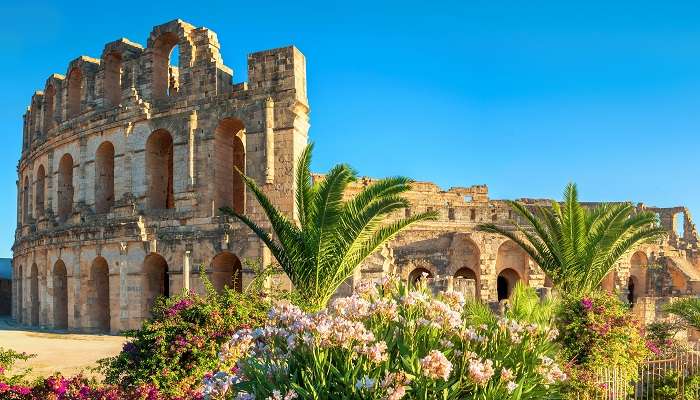
El Djem itself is a charming town that exudes a laid-back atmosphere, surrounded by olive groves and the picturesque Tunisian countryside. Visitors can not only delve into the rich history of the amphitheater but also immerse themselves in the local culture and hospitality.
Exploring this ancient Roman marvel, visitors can envision the roars of the crowds, the bravery of gladiators, and the spectacle of ancient contests that once filled this arena. El Djem’s Roman amphitheater stands as a testament to Tunisia’s historical heritage and offers an unforgettable journey back in time, making it a must-visit destination for history enthusiasts and travelers alike.
Famous Tourist Attractions: Amphitheatre of El Jem , Archaeological Museum of El-Djem, Ribat of Sousse, Great Mosque of Kairouan
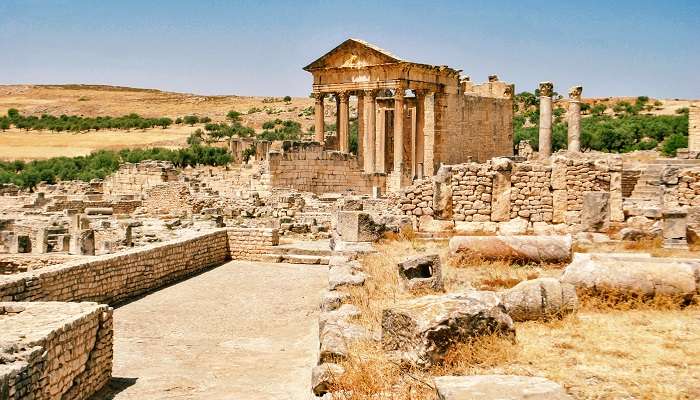
Dougga, also known as Thugga, is an ancient Roman archaeological site in Tunisia that holds a prominent place among the country’s historical treasures. Situated in the northwestern region of Tunisia, Dougga is often hailed as the best-preserved Roman small town in North Africa, and it was designated as a UNESCO World Heritage Site in recognition of its historical significance.
Dating back to the 2nd century BC, Dougga thrived as a prosperous city during the Roman era, and its ruins are a testament to the architectural sophistication of that time. The town’s layout includes a well-preserved forum, temples, theaters, baths, and a variety of residential and administrative buildings, all set against a backdrop of picturesque rolling hills.
Famous Tourist Attractions: Great Mosque, Great Mosque, Commonwealth War Cemetery, Bulla Regia, Ksour Toual Zammel, Kbor Klib
Suggested Read: 10 Cafes In Nairobi To Relish African Cuisines In The Capital City Of Kenya
6. Kairouan
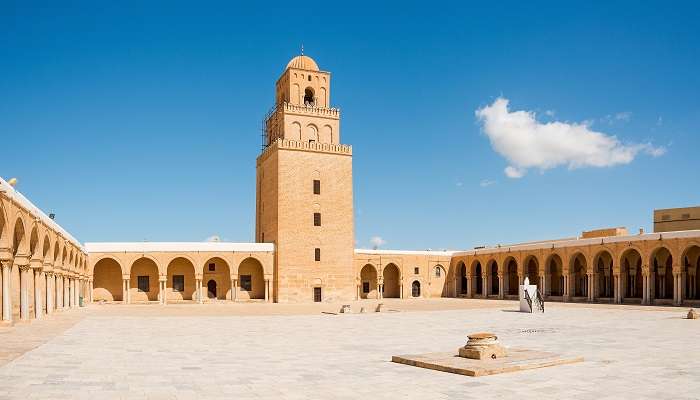
Kairouan, often referred to as the “City of One Thousand and One Mosques,” is a city of immense historical and cultural significance in Tunisia. Situated in the northeastern part of the country, Kairouan stands as one of the Islamic world’s holiest cities, a place of pilgrimage and learning.
One of the city’s most iconic landmarks is the Great Mosque of Kairouan, which dates back to the 9th century and is considered one of the oldest and most important mosques in the Islamic world. Its stunning architectural details, including graceful columns and intricately designed prayer halls, showcase the grandeur of Islamic architecture.
Famous Tourist Attractions: Kairouan Medina, Great Mosque, Mosque of the Barber, Mosque of the Three Doors, Aghlabid Basins
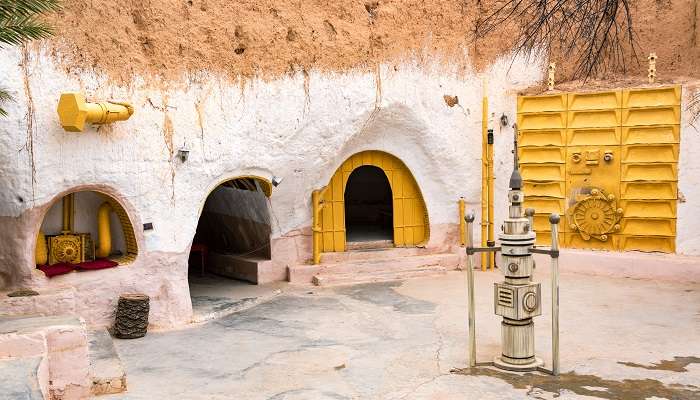
Matmata, a small desert town located in southern Tunisia, is renowned for its unique and fascinating underground dwellings known as “troglodyte houses.” These remarkable structures have been hewn into the soft, sandstone cliffs of the region, creating an otherworldly landscape that has captured the imagination of travelers and filmmakers alike.
The troglodyte houses of Matmata are not just architectural curiosities; they also have a practical purpose. The underground design helps regulate indoor temperatures, providing natural insulation against the scorching heat of the desert during the day and the cold nights.
Famous Tourist Attractions: Casas Trogloditas de Matmata, Mosquée, Escale de Toujane, Ata elhani
Suggested Read: 10 Restaurants In Kenya That’ll Make You Fall In Love With African Food
8. Ichkeul Lake
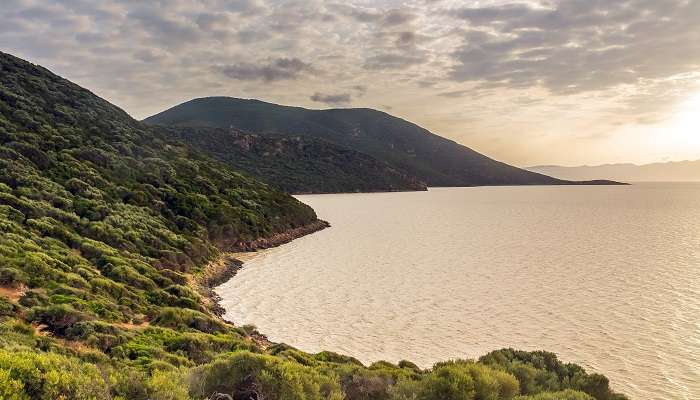
Ichkeul Lake, a UNESCO World Heritage Site, lies in northern Tunisia. The lake and its associated wetlands boast strong ecological importance as they offer natural habitat to a wide range of bird species, especially during the winter migration season..
Enjoying the vicinity of wetlands, the lake is primarily known for its natural landscape and rich biodiversity. Some of the best species found here include flamingos, herons, storks, and various types of ducks. If you wish to bask in the charm of nature, plan a visit to Ichkeul Lake and spend some soulful moments.
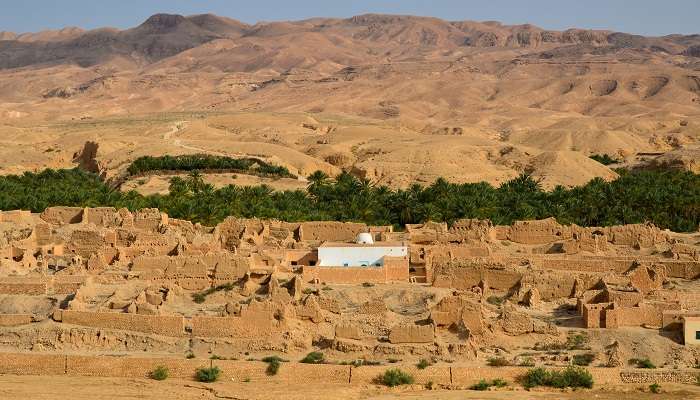
Tamerza is a small village located in southwestern Tunisia, near the border with Algeria. The destination is renowned for its lush palm groves and oasis, which provide a stark contrast to the surrounding arid desert landscape. One of the main attractions in Tamerza is the Tamerza Waterfall which flows from the mountains, creating a refreshing pool at its base.
One of the best places to visit in Tunisia, it also makes a popular spot for visitors to relax and soak in the natural bliss. Apart from this, Tamerza offers breathtaking panoramic views of the desert, mountains, and oasis. For travellers wanting to ditch the crowd, Tamerza is a true heaven
Suggested Read: Top 10 African Islands For A Tropical Vacation In 2023 On This Astonishing Continent
10. Monastir Ribat
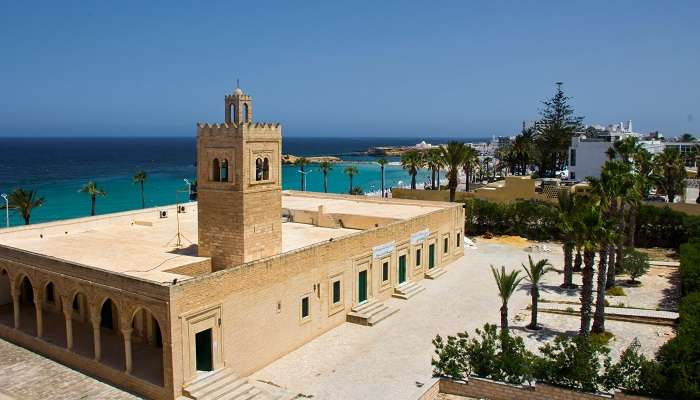
Monastir Ribat is famed for its historical and architectural supremacy. Positioned in the city of Monastir, the Ribat is a well-preserved example of a medieval Islamic fortress and monastery. Constructed in the 8th century AD, this striking spot served as a defensive structure during the early Islamic period.
It played a crucial role in defending the city against various threats, including pirates and invaders. Besides this, it also impresses visitors with its Islamic military architecture, characterized by its sturdy walls, towers, and a central courtyard.
Further Read: Don’t Miss These Food Festivals In South Africa If You Call Yourself A Foodie
Tunisia’s historical sites, coastal beauty, and cultural diversity make it a captivating destination for travelers looking to explore a land where ancient history meets the vibrant present. You can plan your future holiday to Africa with TravelTriangle and have an itinerary drafted exclusively according to your preferences. Don’t forget to unravel the mentioned places to visit in Tunisia for an wholesome experience.
For our editorial codes of conduct and copyright disclaimer please click here .
Cover Image Source: Shutterstock
Frequently Asked Questions About Places To Visit In Tunisia
What is the most visited place in Tunisia?
One of the most visited places in Tunisia is the ancient city of Carthage. Carthage, located near the modern-day capital, Tunis, is renowned for its historical significance and archaeological treasures. It was once a powerful Phoenician and later Roman city, and its ruins offer a fascinating glimpse into Tunisia’s rich past. Visitors come to explore its ancient sites, including the Roman amphitheater, Antonine Baths, and the Carthage National Museum, which houses an impressive collection of artifacts. The combination of historical importance and accessible location makes Carthage a top tourist destination in Tunisia.
Is Tunisia a cheap destination?
Tunisia is often considered an affordable destination for travelers, especially when compared to many Western European countries and North American destinations. However, the cost of your trip can vary depending on factors like your travel style, choice of accommodations, dining preferences, and activities.
Do you need a visa for Tunisia?
A tourist visa of Tunisia is issued for a maximum of 90 days but can also be issued for lesser period, depending on the purpose of visit. If a traveller wants to stay for more than 90 days or, then you must apply for a Tunisia long-stay visa.
People Also Read:
Places To Visit In Maldives Places To Visit In Mauritius Places To Visit In Sri Lanka
Recent Posts

Explore Grand Baie Bazar For An Exciting Weekend Gateway In Mauritius

The Allure Of Kirinda Beach Sri Lanka Includes Surfing, Safaris & Sunsets To Explore In 2024

Visit The Kelani Bridge In Sri Lanka To Admire Modern Architecture In 2024
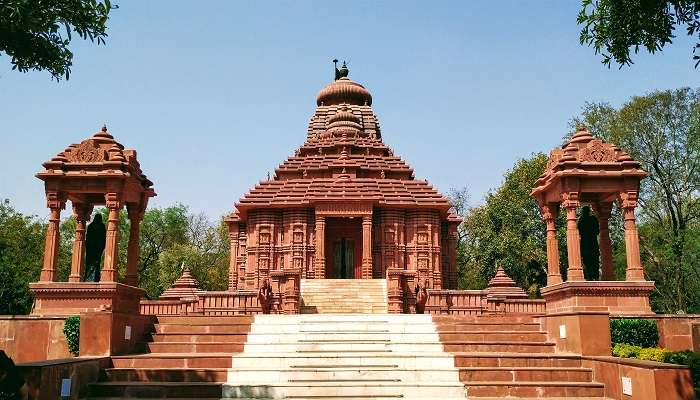
Soak In The Extravagance Of The Sun Temple In Gwalior On Your Vacation In 2024
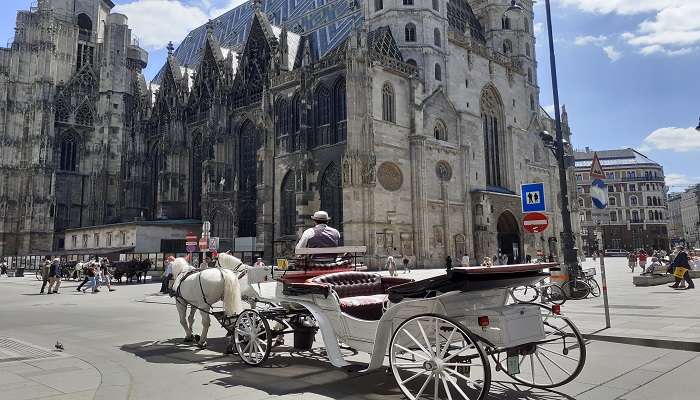
Visit Cho Quan Parish Church To Witness The Ho Chi Minh City’s History In 2024
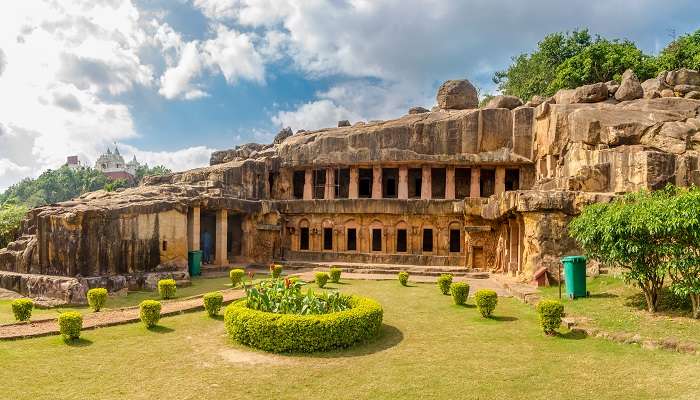
Unveil The Ancient Wonders Of Khandagiri Udayagiri Caves In 2024
Trending Blogs

20 Mysterious Places In India To Visit In 2024 More Bizarre Than The Bermuda Triangle

10 Scariest Roads In India That Are A Driver’s Nightmare

101 Places To Visit In India Before You Turn 30 in 2024

35 Exotic Places To Visit In December In India 2024 To Enjoy A Surreal Vacation

60 Best Honeymoon Destinations In India In 2024

95 Best Honeymoon Destinations In The World In 2023 For A Romantic Escape!
Best Places To Visit In India By Month
Best places to visit outside india by month.
- TravelTriangle
- International
- Places To Visit »
- Tour Packages
- Honeymoon Packages
- Family Packages
- Budget Tour Packages
- Luxury Tour Packages
- Adventure Tour Packages
- Group Tour Packages
- Maldives Tour Packages
- Bali Tour Packages
- Dubai Tour Packages
- Singapore Tour Packages
- Thailand Tour Packages
- Europe Tour Packages
- Sri Lanka Tour Packages
- Tour Packages From Delhi
- Tour Packages From Mumbai
- Tour Packages From Bangalore
- Tour Packages From Chennai
- Tour Packages From Kolkata
- Tour Packages From Hyderabad
- Tour Packages From Ahmedabad
- Thailand Tourism
- Bali Tourism
- Singapore Tourism
- Maldives Tourism
- Mauritius Tourism
- Dubai Tourism
- Europe Tourism
- Hotels in Thailand
- Hotels in Maldives
- Hotels in Mauritius
- Hotels in Bali
- Hotels in Dubai
- Hotels in Singapore
- Hotels in Sri Lanka
- The 10 Most Beautiful Towns...
The 10 Most Beautiful Towns In Tunisia

Tunisia is famous for its beautiful towns built around an ancient Medina quarter, towered over by minarets and looking out over the Mediterranean. You’ll find some of the best preserved architecture of the early Islamic era in Tunisia , in mosques and palaces that incorporate intricate Arabic calligraphy and Koranic verses on their patterned façades. Places like Dougga and Ghar al Milh hold picturesque crumbling ruins from earlier and later periods to be explored. Here is our guide to 10 of the most beautiful places in Tunisia.

Founded by the Arabs in the year 670, Kairouan in Arabic means ‘military camp’. It was a staging post for the Arabs during the conquests of northern Africa and Spain. During the 9th century, it became home to rulers of North Africa, the Aghlabid dynasty, and under them, Kairouan became a great center of learning and prosperity. Magnificent palaces, libraries, gardens and mosques were built, along with vast water basins that still exist today. The centerpiece of modern Kairouan is the Great Mosque of Sidi-Uqba with its beautiful columns made from porphyry and marble taken from the ruins of Carthage. There are smaller mosques too, including the Mosque of the Three Gates with its façade incorporating decorative calligraphy. The city is a UNESCO World Heritage Site and is regarded by many Muslims as the fourth holiest site in Islam.

Hammamet lies on the Mediterranean coast in north Tunisia, a popular tourist resort famed for its endless beaches and wonderfully preserved medina. The town has passed through many different hands – Punic, Roman, Islamic, Spanish, Turkish and French, each leaving their own architectural legacy. The seawalls date back to the 13th century, the medina to the 15th and many of the elegant whitewashed houses were built in the era of French rule. Hammamet has attracted plenty of discerning visitors over the years, including Sophia Loren, Winston Churchill and Andre Gide. Most famously it was painted by the great Paul Klee, whose ‘ Hammamet with Its Mosque ’ of 1914 hangs in the Metropolitan Museum of Art in New York

Sfax was built on the ruins of two Roman towns on the east coast, as a port from which olive oil grown inland could be transported all over the Mediterranean. It was fought over for centuries by the Normans from Sicily, the Spanish and later became a base for Barbary pirates. Today there is a real French feel to parts of Sfax with wide boulevards and avenues, though the medina is regarded as the best preserved in Tunisia. You’ll find labyrinthine alleys winding their way through souks, past the Great Mosque modeled on that at Kairouan, the Borj Ennar or ‘Tower of the Fires’, and the ancient Kasbah. Despite feeling somewhat haphazard the medina is in fact intricately planned, with souks selling religious incense closest to the mosque and those selling mundane items like leather on the outside for passing caravans.

You won’t find anyone living in Dougga; it’s a town of ruins, and the best preserved Roman town in North Africa according to UNESCO . Unlike Carthage which has largely been built over, Dougga lies far from encroaching urbanism in north Tunisia, allowing it to decay naturally to form ruins every bit as picturesque as Paestum or Delphi across the Mediterranean. There are remains of pre-Roman monuments, triumphal arches still standing, and much of a theater that could once have seated most of the inhabitants of the town. The remains of 11 temples have been found, including the excellently preserved Capitol with its portico and pediment still erect. Many of the mosaics that once adorned the villas of Dougga can be seen in the Bardo Museum in Tunis.

On the Gulf of Hammamet, Sousse looks out on the Mediterranean and is enclosed on the landward side by swathes of olive groves. The ancient medina is a UNESCO World Heritage Site and a favorite site for filmmakers, having featured in the Indiana Jones movies as a substitute for Cairo. Long coastal defenses nestle next to indolently swaying palm trees, and towers and battlements, mosques and souks combine in one of finest examples of North African military coastal architecture. The minarets of the Great and Bou Ftata Mosques soar over courtyards and face the watch towers of the Kasbah and the Ribat, a unique military fortress once manned by holy men.

Houmt Souk is the main town on the island of Djerba , just off the south-eastern coast and believed to have been the island of the Lotus-Eaters on which Odysseus and his sailors were stranded. The town and island are rare centers of Berber culture rather than being French or Arabic speaking, and have been home to large Jewish and Islamic sect communities for milennia. Along with successive occupations by Romans, Sicilian Normans, Ottoman Turks and Barbary corsairs, this has left a wonderful legacy of religious and military buildings. The fortress of Borj el Kebir looms over the town, whilst the splendid El Ghriba synagogue with its white and blue arches and porticoes, just outside the main town to the south-west, is believed to date back 1,900 years.

Become a Culture Tripper!
Sign up to our newsletter to save up to $1,395 on our unique trips..
See privacy policy .

Sidi Bou Said
Sidi Bou Said is the classic blue and white sun-soaked Tunisian coastal town, sitting on the north coast and facing out over the Mediterranean towards Sicily. Whitewashed walls are paired with blue doorways embossed with crescent and star motifs. The town was once a religious sanctuary, before it became a pleasure resort for the Ottoman governors of Tunis and in the era of French rule, a magnet for artists and writers. The likes of Simone de Beauvoir and Andre Gide traveled to Sidi Bou Said, along with painters Paul Klee, Auguste Macke and Henri Matisse, all drawn by the brilliant light and vibrancy of the town.

It might seem a cliche to include Matmata, as it is common knowledge that the early parts of the first Star Wars films were shot there. But the underground houses cut into the rocky Hamada desert are one of the most extraordinary and unique sites in Tunisia. The troglodytes of Matmata were barely known until 1967, when the town, not far from Gabes in southern Tunisia, became a major attraction for visitors. Some of the cave houses go down as far as 30 feet and are said to date as far back as the 4th century BC . The Berber inhabitants use earthen steps and rope ladders to make their way between the levels of the caves and use passageways to wend their way between rooms.

Ghar Al Milh
Sometimes also known as Porto Farina, Ghar al Milh lies on the north coast at the head of a lagoon. It’s a well-kept secret that gets few visitors but was once one of the main ports of Tunisia along with Tunis and Bizerte. Back in the 17th century, it was home to a fleet of Barbary pirates until a British fleet destroyed the town in 1655. Since then it has been used by Maltese merchants, manned by an Ottoman garrison and used as a base by French and Italian bootleggers. The harbor silted up over time, preserving Ghar Al Milh as a picturesque town surrounded by relics and ruins of Ottoman fortresses and coastal defenses built by corsairs.

The medina, or old town, of Tunis can’t be left off this list. There’s plenty of modern architecture to see in the capital, including the French colonial buildings of the Avenue Habib Bourguiba, but the old medina is the clear highlight. Spread over 280 hectares, the old town is home to over 700 monuments largely dating to the period between the 12th and 16th centuries when Tunis was one of the leading centers of learning and wealth in the Islamic world. It’s an anthology of Islamic design in the form of mosques, souks, fountains, madrassas, military defenses, palaces and the great medina gates – the Bar Bhab and Bar Jedid.

Bars & Cafes
The 10 best bars in sfax, tunisia.

Food & Drink
The 10 best brunches in hammamet, tunisia.

The Best Beach Bars To Visit In Tunisia

The 10 Best Brunch and Breakfast Spots In Sfax, Tunisia

The Best Breakfast And Brunch Spots In Tunis, Tunisia

Restaurants
The 10 best restaurants in djerba.

Tunisian Club Shut Down After DJ Plays Muslim Call to Prayer

Azzedine Alaïa: The Couturier, A Style Guide to Tunisia's Influential Designer

Guides & Tips
Tunisia travel ban lifted two years after tragedy.

The 10 Best Contemporary Tunisian Artists

12 North African Dishes You Need To Try

See & Do
Why you need to explore tunisia.
Culture Trip Summer Sale
Save up to $1,395 on our unique small-group trips! Limited spots.

- Post ID: 365147
- Sponsored? No
- View Payload
Best attractions in Tunisia: Top 25

Mysterious country of warm sun, desert heat and cool oases, date palms and spicy jasmine is a magical Tunisia. For many vacationers this is a country of pure sandy beaches, serene vacation in an atmosphere of warmth and peace, but of course there is something to see in Tunisia and beyond the beach, traveling to places of interest - such as the holy temples, the magnificent Carthage, the Colosseum, the sultry Sahara and other memorable attractions of Tunisia. The country has a high level of service: Hotels in Tunisia meet high international standards, as evidenced by numerous reviews, and guides in Tunisia organize informative tours in Tunisia, full of vivid impressions.
What to see first of all in Tunisia
Overview of the main attractions with a brief description will be your mini assistant in planning your upcoming trip. By studying this rating, everyone will find what to see in Tunisia for 1 day and for any other period of time, where to go in Tunisia, depending on opportunities and preferences.
1. The ancient city of Carthage

Today Carthage is the most famous suburb of Tunisia, and once there, you will really have something to see in Tunisia: the ruins of the ancient city still stand on the shore of the Gulf of Tunis, impressing with its grandeur and rich history. Until now, unfortunately, historians have not managed to find enough information about the origins of Carthage, but large-scale excavations in the surrounding areas continue. Thus, the ruins of several ancient cities, once existed on this beautiful seaside land, have already been discovered during excavations under the auspices of UNESCO.
Tunisia | Save on hotel reservations
2. the amphitheater at el djem.

The amphitheater is often compared to the Roman Colosseum - this grandiose structure is already 2,000 years old and although today its arena is well below the level of the modern streets of El Djem, its walls still rise above the modern constructions of the city and are visible from afar. Inside the amphitheater one can raid the many underground passages, or climb the spectator rows to imagine the spectacles that unfolded before the eyes of the public.
3. Sidi Bou Said

The beautiful Sidi Bou Said is the most beautiful attraction of Tunisia, a town in white and blue colors, standing on a cliff at the foot of which stretches the Mediterranean Sea, in the distance you can see the Atlas Mountains and the ancient Carthage. The town is unusual in that all of its buildings are painted white and its windows, fences, and grills are sky blue. According to the stories of guides, once in this quiet picturesque place a noble French baron bought a house and he suggested the residents to paint their houses in white and blue colors, so that they were less heated in the rays of the bright African sun.
4. Bardo National Museum

The Bardo Museum of Tunisia is the premier museum of antiquity, where unique and valuable finds from archaeological excavations throughout the country have been brought in for more than a hundred years. The museum’s exhibition is the richest collection of Roman mosaics and other artifacts, reflecting the history of civilizations in Tunisia over 3 thousand years. Now there are more than 3 hundred mosaics, an extensive collection of marble statues, ancient ceramics, tombstones of priests, terracotta statues and much more.
5. The Ancient City of Dugga

Dugga is one of the first places to see in Tunisia worth seeing among the ancient ruined cities. Dugga was once a large prosperous city of over 25,000 people, and today it is one of the best preserved archaeological sites in North Africa. Many Roman temples, fountains, water tanks, as well as theaters, markets, aqueducts, necropolises and mausoleums are still preserved in their original state, and even in some places chariot tracks are preserved in the paved streets.
Official site: https://whc.unesco.org
6. The Ancient City of Kerquan

In the northeast of Tunisia, on the Cap Bon Peninsula, lies one of the most important landmarks of Tunisia, the ruins of the ancient city of Kerkouan. Since 1952, excavations at this site have continued unabated. The Punic city, founded between the 6th and 3rd centuries BC, was destroyed by the Romans in 146 BC. What is left of it has been reliably preserved under a thick layer of sand and has come down to this day, giving our contemporaries the chance to see the ancient sites with their own eyes. The city itself was protected from outside attacks by a double wall, and inside was a perfectly organized system of drainage with a multitude of water channels.
7. The Sahara Desert of Tunisia

The Sahara is one of the most mysterious and at the same time most attractive places in Tunisia. The vast area of the Sahara is desert, but there are nationalities that inhabit these lands in places of oases. Vegetation and fauna in the desert is extremely scarce, but there is something else in the Sahara, which beckons to this region. This is a kind of beauty and charm, which is endowed with sandy plains, dunes, salt lakes, rare oases and unusual local sunsets. Tours of the Sahara, including camel or jeep rides, are most frequent in the early morning hours.
8. Matmata Cave City

Berber tribes have lived in man-made chalk caves dug into the slopes of the local mountains for more than a millennium and a half. These unusual 1-2-story dwellings are of great interest to visitors, but this way of life in the desert is not a whim, but the only way to escape from the scorching heat of the African sun and the unprecedented differences in temperature during the day. So, in the heat of 40-50 degrees inside the caves there is a comfortable temperature of 20-23 degrees.
9. Gellala Village

On the Tunisian island of Djerba is another interesting attraction in Tunisia, the village of Gellala, also known as the village of potters. The name speaks for itself - this area has been famous since time immemorial for its pottery, clay products and ceramics. This is where you can see how beautiful clay jugs, large dishes and small charming vessels for spices are born. All in all, there are about 450 pottery workshops in the village that have their own secrets for making strong and quality pottery.
10. Medina of Tunis

In general terms, the medina is a city enclosed by a protective fortress wall. The Tunisian medina is distinguished by the fact that the wall was torn down about 200 years ago as being of no use, and all that was left was a gate. Other distinctive features of the medina of Tunisia - a rounded shape rather than rectangular, as in the classical view, and a mixture of styles - Spanish, Arabic, Turkish and Persian, associated with the construction of different quarters at different times. Tourists are also interested in this area abundance of traditional oriental bazaars.
11. Saint Vincent de Paul Cathedral

This classical-style Catholic church was erected in honor of the famous priest Vincent de Paul, who was redeemed from Arab slavery. The majestic building, located on Independence Square in the city of Tunis, is admirable for its exterior decoration and rich interior. The size of the temple is no less astonishing: it is about 80 meters long and almost 30 meters high. A number of artists and sculptors worked on the decoration of the shrine. A special pride of the temple is the organ hall, which houses two powerful instruments, ordered in its time from the great organ builder Aristide Cavaillé-Coll.
12. The Mausoleum of Habib Bourguiba

This is an important Tunisian landmark in the city of Monastir, a very picturesque building, outwardly imitating a mosque, finished with white marble and stone carvings. Here rests the body of the Tunisian political figure, the famous builder of independence Habib Bourguiba. Not only the exterior decoration but also the interior of the mausoleum is noteworthy: for example, some personal belongings of the president - a desk, a chair and clothes - are kept in the exposition of the museum located here. And the sarcophagus preserving the body of the deceased is installed in a special room on a pedestal.
13. El Grib Synagogue

What to see in Tunisia on the island of Djerba? The Tunisian island is famous for its famous landmark, the El Greib Synagogue in the settlement of Riyadh. There are a great many versions of the founding of the shrine: according to one of them, the priests who escaped from Jerusalem from slavery, took the stone from Solomon’s Temple and put it in the foundation of the future synagogue. Another legend says that on the hill where the synagogue now stands, a beautiful girl used to live in a hut, and some unknown power prevented the inhabitants from approaching her. One night her dwelling caught fire and the girl was killed. The inhabitants realized that the girl was a saint and built a synagogue in her honor. These are not all the legends about the origin of the synagogue, and it is difficult to distinguish between truth and fiction.
14. Uqba Mosque

Sidi Uqba, 670, is one of the few Muslim mosques where adherents of other faiths are allowed inside. Today it is one of the largest shrines in Tunisia, created through a process of continuous construction over several centuries. In general, each leader in power brought something different to the construction of the mosque. Today, the large space of the mosque includes a large prayer hall, a huge courtyard paved with marble, and a large minaret. The decoration of the mosque and the surrounding areas is characterized by unique methods of decorative work, different from the traditional Byzantine technique.
Official website: https://www.patrimoinedetunisie.com.tn
15. Al-Zaytun Mosque (Olive Mosque)

The Olive Mosque, or al-Zaytouna, is the largest mosque of the capital of antiquity. According to belief, on the site where this Tunisian landmark now stands, there grew an olive tree, under which the very first preacher of the future mosque performed his prayer vows. It is believed that construction began in 698 and since then the mosque has undergone many changes. The area occupied by the mosque is about 5 thousand square meters. A library was also founded in the building in 1450 and is located on the left side of the courtyard. In general, the courtyard is the only place in the mosque accessible to people of other faiths.
16. Ribat Fortress in Sousse

In the medina of Sousse on a hill rises the Ribat fortress of 859. It’s square in shape, with a side of 38 meters, and its strong 4-meter-thick defensive walls are 12 meters high. Ribat has a rather complicated history: originally it was a Byzantine fortress, which was later razed to the ground. Later, in the 9th century, was erected a 77-meter tower Khalef al-Fat, which due to its height has served as a lighthouse. It was not until 1063 that the citadel itself was built and its walls were completed by 1205. Today you can visit the archaeological museum in the fortress, which exhibits a large collection of artifacts.
17. Ribat Fortress in Monastir

Monastir also has its own fortress, Ribat Hartem of 767, and it didn’t get its final look either. Originally it occupied an area of only about 33 sq.m., but over time it grew and strengthened, and by the 19th century its area was already about 4200 sq.m. Ribat has 3 levels, there are many passages and spiral staircases. At one time Ribat was a religious center and place of pilgrimage, and played a defensive role only a few times. Today inside the fortress you can visit the museum of Islamic art.
18. Kelibiya Fortress

On the summit of Cape Bon, about 100 kilometers from Tunis, the Kelibia Fortress, the oldest fortress founded in the 3rd century BC, towers high. The Carthaginians were the first to build the fortress. Today it is the largest surviving fortification in the country. At the base of the fortress there are large stones laid by the Carthaginians, and the upper part is a masonry of natural stone. In the courtyard we can see the remains of a small mosque and a Byzantine fortress, and at the northern extremity of the fortress is a restored chapel.
19: Phrygia Zoo

What to see in Tunisia among the natural monuments? For example, the magnificent Zoo Frigia, located on a large area of 36 hectares between the cities of Sousse and Hammamet. It was founded in 2000 and is executed in the national style - its inhabitants live in large open spaces, not confined in cages. But despite the fact that, in fact, animals live here in the wild, their freedom is only partial: visitors can observe predators only from specially designed decks, and with herbivores - communicate at a palm’s distance.
20. Ishkol National Park

25 kilometers from Bizerte is a natural nesting place for waterfowl and migratory birds. Because of its location near the densely populated areas of Tunisia this place needed special protection. Thus the Ishköl National Park was created. As early as the 13th century, hunting was forbidden in the local lakes. Today, the park has a large lake of 50 sq km and mountains and hills of limestone on which grow olive and pistachio trees. The hills are home to approximately 180 species of migratory and resident birds, including swans, ducks, flamingos and some rarer species.
This concludes the main list of the best sights, but it’s not all that’s worth visiting in Tunisia.
Sightseeing in Tunisia: what else to visit in Tunisia
The list of what to visit in Tunisia can go on endlessly - its sights are more than enough for several trips. After the first vivid acquaintance with the country comes the time of other, no less interesting sights of Tunisia - here are recommendations for their visit.
21. The Atlas Mountains

A huge ridge of the Atlas Mountains stretches along the coast of the African mainland.
For many, a trip to the Atlas Mountains is a chance to enjoy their majestic scenery, take pictures, and see unique species of flora and fauna, some of which live only here. Once upon a time, these mountains were even home to the continent’s only bear species, the Atlas bear, but it is now extinct. The name of the Atlas Mountains comes from Greece, after Atlas, one of the mighty titans. Legend tells us that Atlas was sentenced to the punishment of holding the sky on his shoulders. For this purpose Perseus turned the titan into stone - thus, according to the legend, the mountains of Atlas were formed.
22. The island of Djerba

The hospitable island of Djerba has everything you need for a serene holiday on the Mediterranean coast: a great climate that allows you to enjoy the sun and swim most of the year, comfortable hotels, a lot of entertainment options and unique attractions. The island is steeped in olive groves and there are many farms growing dates. The population of Djerba is original - it is just as on the mainland, the Berbers lived here, and the Arab conquerors did not manage to expel these tribes. The Berbers of Djerba are now part of the Ibadite religious community.
23. Schott El Jerid Lake

In fact, this Tunisian landmark is a saltwater depression in the Sahara Desert. The lake dries up and fills up again throughout the year, and it becomes a body of water in the classical sense only in winter, during the rainy season. In the summer, when the air temperature reaches 50 degrees, it dries up, leaving a thick crust of salt on the surface, which is then covered by dry sand.
A surprising phenomenon in the vicinity of this lake are the “desert roses,” formed from minerals in the soils surrounding the salt marshes. These stone sculptures are really shaped like intricate flowers of various shades.
24. Souk el-Juma Market

In addition to a variety of historical sites, Tunisia is known for its colorful markets. One of them is the Souk el-Jouma market, whose main focus is the sale of locally produced ceramics. Tunisian ceramics are sold here at most affordable prices, so many visitors to the country, if they find themselves here, tend to buy something beautiful as a keepsake for yourself or as a gift - a vase, dish, set. In addition to ceramics, you can buy here other local attributes - Berber jewelry, incense, scarves spices and other useful things.
25. Remains of the “Star Wars” set

Once upon a time in 1976, it was Tunisia, with its unusual landscapes, that was chosen to film episodes of Star Wars. The country has more than two dozen locations where the famous saga was filmed. The most famous of these places is the town of Matmata, famous for its underground Berber dwellings. In one of these houses and was filming the 4 episodes of the saga, where a lot of sets have been built. In 1995 a fan of the famous movie restored the abandoned scenery and now everyone can see the legendary filming place as it was 40 years ago.
Tunisia, fragrant with aromas of Mediterranean greenery and spicy oriental spices, combines the millennial tradition of Africa and the culture of new Europe. Seaside resorts, amazing natural and man-made attractions of Tunisia will surprise any fan of exotic vacation on the African mainland. Read also about the best sights of Algeria and get inspired for your future journey to Africa!
- Attractions
Popular articles

Best attractions in Bahrain: Top 14

Best attractions in Lithuania: Top 25

Best attractions in Leipzig: Top 21

Best attractions in Bangkok

Best attractions in Munich: Top 25

Best attractions in Hainan Island: Top 25

Best attractions in Kuwait: Top 15

Best attractions in Malaga: Top 26

Best attractions in Vancouver: Top 20

Best attractions in Astana

Best attractions in Las Vegas: Top 25

Best attractions in Denmark: Top 25

IMAGES
COMMENTS
Discover the diverse and rich culture, history, and nature of Tunisia with this list of the best tourist attractions and places to visit. From ancient ruins and Islamic architecture to sun-soaked beaches and desert landscapes, Tunisia has something for everyone.
12- Ichkeul National Park. Ichkeul National Park is a UNESCO Biosphere Reserve located in northern Tunisia, near the town of Bizerte. It is renowned for its diverse wetland habitats, including marshes, lakes and lagoons, which provide crucial wintering grounds for migratory birds such as ducks, geese and flamingos.
Lets explore the best places to visit in Tunisia: 1. El Djem. Source: flickr. El Djem. It doesn't get much better than this for fans of the ancients. Colossal arches and elliptical amphitheaters to rival even the Colosseum in Rome are what mark the horizon of famous El Djem.
19. Bou-Hedma National Park. National parks are treasures to behold, and in 1980, Bou-Hedma National Park was founded in Tunisia. Today, it is on the list of UNESCO heritage sites for its ecological significance and illustrious history. It is home to ancient Roman structures beautifully preserved within the park.
Beaches. Beachfront locale with watersports and quaint souvenirs amid deep white sands and a backdrop of scenic views, though marred by environmental concerns. See ways to experience (2) 2024. 5. Musee de Guellala. 1,108. Speciality Museums. Built in 2001, this art museum boasts a fine collection of pottery and a round observation tower ...
Explore Tunisia holidays and discover the best time and places to visit. Explore Tunisia holidays and discover the best time and places to visit. Lonely Planet. Destinations. Planning. Inspiration. Shop ... Ancient Rome: the best places to embrace it (in Tunisia) Nov 13, 2019 • 5 min read. Food. Best things to do in Tunis in summer.
El Djem is a must-place to see in Tunisia. Especially, for a history lover. Every year thousands of tourists visit the biggest historical tourist attraction in Tunisia. ... People say that going under the sea is one of the best things to do in Tunisia. Clearwater, colorful coral reefs, shipwrecks, and lively sea life make Tunisia a perfect ...
Places to Visit in Tunisia. Explore popular experiences. See what other travellers like to do, based on ratings and number of bookings. See All. Day Trips (98) ... The Best of Tunisia, 3 Days Guided Tour with Lunch. 2. Historical Tours. from ₹36,135. per adult (price varies by group size)
Discover the best attractions in Tunisia including Medina, El Jem Amphitheatre, and Medina.
Things to Do in Tunisia, Africa: See Tripadvisor's 577,027 traveller reviews and photos of Tunisia tourist attractions. Find what to do today, this weekend or in July. We have reviews of the best places to see in Tunisia. Visit top-rated & must-see attractions.
Recognised as a UNESCO World Heritage site, Ichkeul stands as a testament to nature's enduring beauty. Experience Ichkeul's Natural Splendour. 10. Chott el Jerid. Stretching over 5,000 square kilometres, Chott el Jerid is Tunisia's largest salt pan and one of its most enigmatic landscapes.
The Great Mosque of Kairouan is one of the best places to visit in Tunisia. 15. Djerba. Djerba, an island off the southeastern coast of Tunisia, is the country's newest UNESCO World Heritage Site. Known for its beaches and crystal-clear waters, it's a popular getaway for Europeans looking for sun, sea and sand.
17 Top-Rated Attractions & Places to Visit in Tunisia. MORE DESTINATIONS. Exploring the Ruins of Ancient Carthage: A Visitor's Guide. Exploring Sidi Bou Said: Tunis' Picturesque Seaside Suburb ... 24 Best Places to Visit in the United States. 28 Top-Rated Tourist Attractions in the World. 22 Best Tropical Vacations.
Day Five: Second-Best Sousse. While Tunis is by far the most modern of Tunisia's cities, you wouldn't be doing the country full justice by just staying in the capital for your whole trip. Hop on one of the two morning trains heading to Sousse and expand your horizons southward. The trip takes just under 2.5 hours.
3. Djerba. Dreamy, serene, and bathed in a special light, Djerba is an island off Tunisia's southeast coast that feels a world away. Often described as one of the most beautiful places in Tunisia, Djerba is a mix of beautiful sandy beaches, lush palm groves, and unique traditional architecture. The island is home to El Ghriba, one of the ...
DAY 3: TUNIS TO SOUSSE. Distance: 147 km (1 hour 50 mins journey time in car) This morning head to the Louage Station Moncef Bey to catch a louage to Sousse (11.9 TND or $4.20). This 14-day itinerary for Tunisia is based on using public transport - for us, louage was the fastest option.
As the second-largest museum on the African continent, the Bardo Museum is a particular highlight. Housed in a 19th-century palace, it is a veritable treasure trove of Tunisian history populated by mosaics, sarcophagi and sculptures unearthed from ancient sites located across the country. 02 of 10.
Find out all the amazing places to visit in Tunisia: Sidi Bou Said, Carthage, El Jem, Kairouan, Mos Espa, Chott El Djerid, Djerba and more. ... 21, 2023 June 23, 2024. From the winding streets of the Tunis Medina to the dunes of the Sahara Desert, discover the best places to visit in Tunisia. The country fascinated me with its rich history ...
Tunisia may be mainly known as a summer sun and sea travel destination, but off the beach there is much more to discover. In the south, the Sahara's swath of desert sand scattered with lonely oases offers landscapes of rolling dunes that are ripe for adventure tourism activities, while in the north, the ruins of ancient towns sit snug within fertile hill country and are easy historic day trips ...
Day 1, 2 - Visit the capital of Tunis. A third Mediterranean, a third European and a third North African, Tunis is a city with many cultural contrasts and most likely, the starting point of your Tunisia travel itinerary. On the one hand, the old city is composed of an African, Maghrebi medina, not very different from the ones you would find ...
Famous Tourist Attractions: Kairouan Medina, Great Mosque, Mosque of the Barber, Mosque of the Three Doors, Aghlabid Basins. 7. Matmata. Image Source: Shutterstock. Matmata, a small desert town located in southern Tunisia, is renowned for its unique and fascinating underground dwellings known as "troglodyte houses.".
Hammamet. Hammamet lies on the Mediterranean coast in north Tunisia, a popular tourist resort famed for its endless beaches and wonderfully preserved medina. The town has passed through many different hands - Punic, Roman, Islamic, Spanish, Turkish and French, each leaving their own architectural legacy. The seawalls date back to the 13th ...
7. The Sahara Desert of Tunisia. The endless sandy expanse of the Sahara Desert in Tunis. The Sahara is one of the most mysterious and at the same time most attractive places in Tunisia. The vast area of the Sahara is desert, but there are nationalities that inhabit these lands in places of oases.